Sharp HRO00074 Cellular Transceiver With Bluetooth Enabled User Manual
Sharp Corporation Cellular Transceiver With Bluetooth Enabled Users Manual
Sharp >
Contents
- 1. Manual
- 2. Bluetooth Logo
- 3. Users Manual
- 4. BT Logo
- 5. User Manual
Users Manual

Declaration of Conformity
Hereby, Sharp Telecommunications of Europe Limited,
declares that this WX-T825 is in compliance with the essential
requirements and other relevant provisions of Directive
1999/5/EC.
A copy of the original declaration of conformity can be
found at the following Internet address:
http://www.sharp-mobile.com
Sharp Telecommunications of Europe Ltd.
Azure House, Bagshot Road, Bracknell, Berkshire RG12 7QY UK

Introduction 1
Introduction
Congratulations on your new HSDPA WX-T825 phone.
About This User Guide
This user guide is carefully designed to help you learn
about your phone’s features and operations quickly and
effectively.
NOTICE
• We strongly recommend that you keep separate
permanent written records of all important data. Data
may be lost or altered in virtually any electronic
memory product under certain circumstances.
Therefore, we assume no responsibility for data lost
or otherwise rendered unusable, whether as a result of
improper use, repairs, defects, battery replacement,
use after the specified battery life has expired or any
other cause.
• We assume no responsibility, directly or indirectly,
for financial losses or claims from third parties
resulting from the use of this product and any of its
functions, such as stolen credit card numbers, the loss
or alteration of stored data, etc.
• All company and/or product names are trademarks
and/or registered trademarks of their respective
holders.
• Screen layout may differ from that illustrated in this
user guide.
• The information described in this user guide is
subject to change without notice.
• All the functions described in this user guide may not
be supported by all networks.
• We assume no responsibility for downloaded
contents, information, etc. from the network.
• Occasionally, a few black or bright pixels may appear
on the screen. Please note that this will not have any
impact on any of the features or on performance.
Intellectual Property Rights
According to copyright laws, the reproduction,
alteration and use of material which is protected by
copyright (music, pictures, etc.) is only permitted for
personal or private use. If the user is not in possession
of more extensive copyright or has not received the
explicit permission from the copyright owner to
reproduce, alter or use a copy which has been made or
modified in this way, this is considered to be a violation
of the copyright laws and gives the copyright owner the
right to claim for damages. For this reason, avoid the
illegal use of material which is protected by copyright.
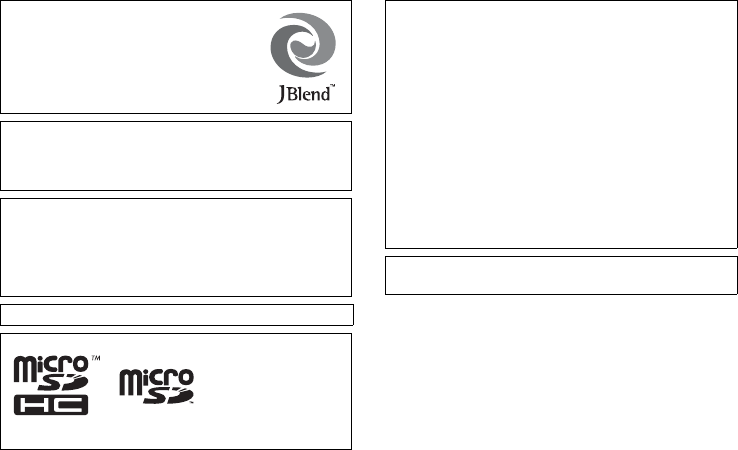
2Introduction
Powered by JBlend™ Copyright
1997-2008 Aplix Corporation. All rights
reserved.
JBlend and all JBlend-based trademarks
and logos are trademarks or registered
trademarks of Aplix Corporation in Japan
and other countries.
Powered by Mascot Capsule®/Micro3D Edition™
Mascot Capsule® is a registered trademark of HI
CORPORATION
©2002-2008 HI CORPORATION. All Rights Reserved.
Licensed by Inter Digital Technology Corporation under one
or more of the following United States Patents and/or their
domestic or foreign counterparts and other patents
pending, including U.S. Patents: 4,675,863: 4,779,262:
4,785,450: 4,811,420: 5,228,056: 5,420,896: 5,799,010:
5,166,951: 5,179,571 & 5,345,467
CP8 PATENT
microSDHC and microSD logos are trademarks.
T9 Text Input is licensed under one or more of the following:
U.S. Pat. Nos. 5,187,480, 5,818,437, 5,945,928,
5,953,541, 6,011,554, 6,286,064, 6,307,548, 6,307,549,
and 6,636,162, 6,646,573, 6,970,599; Australia Pat. Nos.
727539, 746674, 747901; Austria Pat. Nos. AT225534,
AT221222; Brazil P.I. No. 9609807-4; Canada Pat. Nos.
1,331,057, 2,227,904, 2,278,549, 2,302,595; Japan Pat.
Nos. 3532780, 3492981; United Kingdom Pat. No.
2238414B; Hong Kong Standard Pat. No. HK1010924;
Republic of Singapore Pat. Nos. 51383, 66959, 71979;
European Pat. Nos. 1 010 057 (98903671.0), 1 018 069
(98950708.2); Republic of Korea Pat. Nos. KR201211B1,
KR226206B1, 402252; People’s Republic of China Pat. No.
ZL96196739.0; Mexico Pat. Nos. 208141, 216023, 218409;
Russian Federation Pat. Nos. 2206118, 2214620, 2221268;
and additional patents are pending worldwide.
Copyright for Pictograph ©2008 Softbank Mobile Corp. or
Sharp Corporation. All rights reserved.
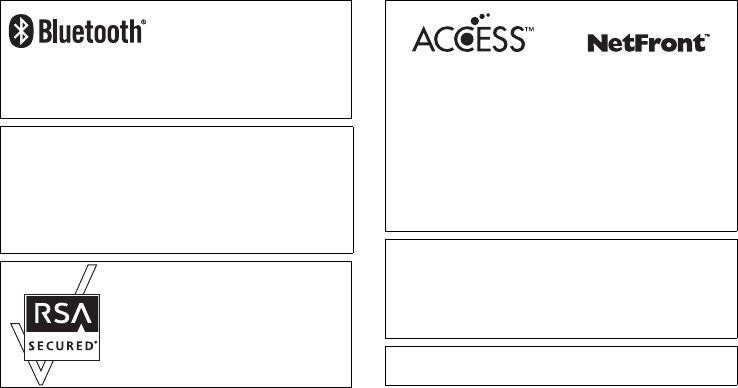
Introduction 3
The Bluetooth® word mark and logos are registered
trademarks owned by the Bluetooth SIG, Inc. and any use
of such marks by Sharp is under license. Other trademarks
and trade names are those of their respective owners.
Licensed by QUALCOMM Incorporated under one or more
of the following United States Patents and/or their
counterparts in other nations ;
4,901,307 5,490,165 5,056,109 5,504,773 5,101,501
5,506,865 5,109,390 5,511,073 5,228,054 5,535,239
5,267,261 5,544,196 5,267,262 5,568,483 5,337,338
5,600,754 5,414,796 5,657,420 5,416,797 5,659,569
5,710,784 5,778,338
This product contains NetFront Browser and NetFront
Messaging Client of ACCESS CO.,LTD.
ACCESS and NetFront are trademarks or registered
trademarks of ACCESS CO., LTD. in Japan and other
countries.
NetFront Browser © Copyright 1996-2007 ACCESS CO.,
LTD.
NetFront Messaging Client © Copyright 2000-2007
ACCESS CO., LTD.
This software is based in part on the work of the
Independent JPEG Group.
Microsoft®, Windows®, Windows Vista®, Outlook®,
PowerPoint® and Excel® are registered trademarks of
Microsoft Corporation in the United States and/or other
countries.
Microsoft Word is a product name of Microsoft Corporation
in the United States.
Adobe® and Acrobat® are trademarks of Adobe Systems
Incorporated.
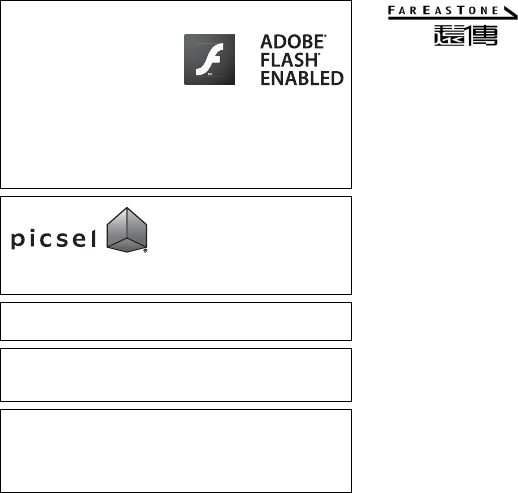
4Introduction
[FarEasTone and Logo] are trademarks or registered
trademarks of FarEasTone Telecommunications Co., Ltd. in
Taiwan and other countries.
Customer Service Call: 0800-058-885
Also Sharp Corp. is authorized with bona fide use of the
foregoing trademark in relating course of trade in Japan.
Information contained in this manual is the property of
FarEasTone and Sharp. FarEasTone and Sharp reserve the
right to change product specifications without prior notice.
FarEasTone and Sharp reserve the right to change
information contained in this manual without prior notice.
This product is licensed under the MPEG-4 Visual Patent
Portfolio License for the personal and non-commercial use of a
consumer to (i) encode video in compliance with the MPEG-4
Video Standard (“MPEG-4 Video”) and/or (ii) decode MPEG-4
Video that was encoded by a consumer engaged in a personal
and non-commercial activity and/or was obtained from a licensed
video provider. No license is granted or implied for any other use.
Additional information may be obtained from MPEG LA.
See http://www.mpegla.com.
This product is licensed under the MPEG-4 Systems Patent
Portfolio License for encoding in compliance with the MPEG-4
Systems Standard, except that an additional license and payment
of royalties are necessary for encoding in connection with (i) data
stored or replicated in physical media which is paid for on a title by
title basis and/or (ii) data which is paid for on a title by title basis
and is transmitted to an end user for permanent storage and/or
use. Such additional license may be obtained from MPEG LA, LLC.
See http://www.mpegla.com for additional details.
MPEG Layer-3 audio coding technology licensed from
Fraunhofer IIS and Thomson.
This product employs
Adobe® Flash® Lite™
technology developed by
Adobe Systems
Incorporated.
Adobe® Flash® Lite™
Copyright © 2003-2007
Adobe Systems
Incorporated. All rights reserved.
Adobe and Flash are either trademarks or registered
trademarks of Adobe Systems Incorporated in the United
States and/or other countries.
“Document Viewer” is powered
by Picsel Technologies.
Picsel, Picsel Powered, Picsel
Cube Logo, Picsel File Viewer
and Picsel Document Viewer are Trademarks or Registered
Trademarks of the Picsel Group of Companies.
QR Code is a registered trademark of DENSO WAVE
INCORPORATED.
IrSS™, IrSimple™ and IrSimpleShot™ are trademarks or
registered trademarks of the Infrared Data Association in
the U.S.A. and/or in other countries.
Contains iType™ font engine and font from Monotype
Imaging Inc.
Monotype® is a trademark of Monotype Imaging Inc.
registered in the U.S. Patent and Trademark Office and
may be registered in certain jurisdictions.
Introduction 5
Useful Functions and Services
Your phone offers you the following features:
• Video Calling. You can talk while viewing images of
each other on respective screens.
• 3D and colour Java™ games. You can also download
various games and applications from FarEasTone via
the mobile Internet.
• Advanced Super View (ASV) colour LCD display
with images that are clearer and easier to view.
• A built-in digital camera with an auto focus function
for taking pictures and video clips.
• A message function for reading and creating SMS
messages.
• MMS (Multimedia Messaging Services) for sending
picture, sound and video messages to brighten
someone’s day.
• Email for sending up to 300 KB and receiving mail
with attachments.
• A colour WAP/Web browser for accessing
information on the mobile Internet.
• Your own ringtones and ring video clips. You can use
sound or video clip files as a ringtone or ring video
clip.
• A music player that can play back MP3, MPEG-4 and
3GPP format sound files (supported codec of MPEG-
4 or 3GPP are AMR, AAC, AAC+, and AAC+e).
• Playback of downloaded sound and video clip files.
• A voice recorder function for recording and playing
back voice clips.
•A Bluetooth® wireless technology interface for
establishing contact and transmitting data with
certain devices. You can transmit pictures, sounds,
and video clips to OBEX-enabled phones.
• An infrared interface for data communication. You
can transmit pictures, sounds, and video clips to
OBEX-enabled phones.
• A schedule alarm for creating and sending schedule
entries with alarm settings.
• Barcode scanner. With the built-in digital camera,
you can read barcodes.
• A microSD™ memory card slot that expands
connectivity with a PC using the memory card.

6Contents
Contents
Introduction ................................................. 1
List of Menu Functions ............................... 8
Your Phone ................................................ 10
Optional Accessories ................................. 10
Getting Started .......................................... 12
Inserting/Removing the SIM/USIM Card
and the Battery ........................................... 16
Charging the Battery ................................. 17
Inserting/Removing the Memory Card ...... 19
Connecting the Handsfree Kit ................... 20
Turning Your Phone On and Off ............... 21
Slide Functions and Keypad Lock ............. 22
Display Indicators ...................................... 23
Navigating Functions ................................ 25
Main Menu ................................................ 25
Operations in Open Position ...................... 26
Shortcut Keys ............................................ 26
Shortcuts .................................................... 27
Operations in Closed Position ................... 28
Motion Control ...........................................29
Holding the Phone Correctly ..................... 29
Before Using Motion Control .................... 29
Motion Control Functions ......................... 30
Voice Call/Video Calling Functions .........34
Entering Characters ..................................42
Changing the Input Language .................... 42
Changing the Input Method ....................... 43
User Dictionary .......................................... 48
Using Templates ........................................50
Insert Phonebook Entries ........................... 51
Call Manager ..............................................52
Sending a Message from the Phonebook ... 55
Multimedia ..................................................60
Navigating the Multimedia Menu when
the Phone is Closed .................................... 67
Contents 7
Camera ....................................................... 69
Taking Pictures ..........................................69
Recording Video Clips .............................. 70
Common Functions in the Photo and
Video Camera Modes ................................70
Functions in Photo Camera Mode ............. 73
Functions in Video Camera Mode .............76
Messages ................................................... 78
SMS ........................................................... 78
Long SMS ..................................................78
MMS .......................................................... 78
Email .......................................................... 78
FET Mobile Internet ................................... 90
Navigating a WAP or Web Page ............... 91
Gallery ........................................................ 94
Java™ ....................................................... 102
Organiser ................................................. 107
SIM Application ....................................... 125
Settings .................................................... 126
Call Log .................................................... 153
Connectivity ............................................. 154
Connecting WX-T825 to Your PC ...........160
System Requirements ...............................160
3G/GSM Modem ......................................160
Handset Manager .....................................162
Music Manager ........................................163
Sync Manager ..........................................165
Troubleshooting ......................................166
Safety Precautions and Conditions of
Use ............................................................168
Conditions of Use .....................................168
Mobile Light LED Properties ..................169
Environment .............................................171
Precautions Concerning Vehicle Use .......172
SAR ..........................................................172
FCC NOTICE ..........................................173
Out of Warranty List ................................175
Index .........................................................176
Quick Reference ......................................179

8 List of Menu Functions
List of Menu Functions
WX-T825 functions are listed below.
See relevant page for details of each function. The menu’s corresponding number is used for shortcuts. For details,
see page 26.
1Java™
1Java™ Gallery
2Java™
Settings
3Java™
Information
p. 102
p. 104
p. 106
2FET Mobile Internet
1Homepage
2Go to URL
3Bookmarks
4Alert Inbox
5My Saved
Page
6Access History
7Browser
Settings
p. 90
p. 90
p. 90
p. 90
p. 90
p. 90
p. 92
3Organiser
(Tab 1: Tools 1)
1Calendar
2Alarms
3Tasks
4Calculator
5Expenses
Memo
(Tab 2: Tools 2)
1Stopwatch
2Countdown
Timer
3World Clock
4Hour Minder
(Tab 3: Tools 3)
1Document
Viewer
2Text
Tem p la te s
3Voice
Recorder
4Scanner
5Phone Help
p. 107
p. 112
p. 113
p. 116
p. 117
p. 118
p. 119
p. 119
p. 120
p. 120
p. 121
p. 122
p. 123
p. 124
4Messages
1Message
2Email
3Alert Inbox
4Cell
Broadcasts
5Area Info
6Messaging
Settings
7Memory Status
p. 79
p. 79
–
p. 84
p. 85
p. 86
–
5Camera p. 69
6Gallery
1Picture Gallery
2Video Gallery
3SD VIDEO
4Sound Gallery
5Themes
6Java™ Gallery
7Flash®
8Other
Documents
9Memory Status
p. 94
p. 95
p. 96
p. 96
p. 97
p. 102
p. 98
p. 98
p. 101
7Multimedia
1Video Player
2Streaming
Player
3Music Player
4Camera
p. 60
p. 63
p. 63
p. 69

List of Menu Functions 9
8Call Manager
1Phonebook
2Add New
3Call Voicemail
4Manage
Groups
5My Card
6Speed Dial List
7Message
Groups
8Phonebook
Settings
9Service
Dialling No.*
10 Advanced
p. 52
p. 52
–
p. 58
p. 53
p. 59
p. 55
p. 52
p. 54
p. 57
9Settings
(Tab 1: Phone
Settings)
1Profiles
2Display
Settings
3Themes
4Sound
Settings
5Date & Time
6Language
7Motion Control
8Switch
Ringtone
Output
9Earpiece
Volume
10 Change Menu
11 Security
Settings
12 Slider Settings
13 Master Reset
p. 126
p. 127
p. 132
p. 132
p. 136
p. 137
p. 29,
p. 137
p. 138
–
p. 138
p. 139
p. 141
p. 141
(Tab 2: Call/Video
Call)
1Voicemail &
Diverts
1Video Calling
Settings
2Show Your
Number
3Restrict Calls
4Minute Minder
5Auto Answer
6Call Waiting
7Display Call
Timer
8Display Call
Cost
9Auto Redial
p. 142
p. 143
p. 145
p. 145
p. 147
p. 147
p. 148
p. 148
p. 148
p. 148
(Tab 3: Network
Settings)
1Network
Settings
2Off Line Mode
3Internet
Settings
p. 148
p. 149
p. 150
10 SIM
Application*
p. 125
11 Call Log
1All Calls
2Dialled
Numbers
3Missed Calls
4
Received Calls
5Call Timers
6Call Costs*
7Data Counter
p. 153
p. 153
p. 153
p. 153
p. 153
–
p. 153
12 Connectivity
1Bluetooth
2Infrared
3Mass Storage
4USB Charge
5Card Settings
p. 154
p. 157
p. 158
p. 158
p. 158
*Depends on SIM/USIM
card contents.

10 Your Phone
Your Phone
Please check the following carefully. Your phone
should come complete with:
• HSDPA/3G (UMTS)/GSM 900/1800/1900 GPRS
phone
• Rechargeable Li-ion Battery
• AC Charger
• Stereo Handsfree
• Chinese User Guide
Optional Accessories
• Li-ion Spare Battery
• Cigarette Lighter Charger
•USB Data Cable
• Handsfree Microphone Unit
•Stereo Headset
The above accessories may not be available in all
regions.
For details, please contact FarEasTone.
Your Phone 11
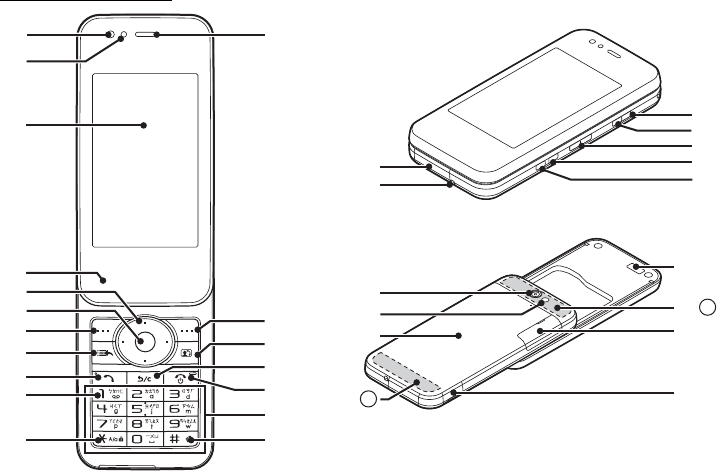
12 Getting Started
Getting Started
1
13
18
12
14
17
15
16
2
5
6
3
4
7
8
9
10
11
21
20
19
23
22
24
25
30
28
27
26
31
29
32
2
29
1
Getting Started 13
1. Light Sensor
2. Small Light:
Flashes when an incoming call or a new message is
received or missed, if Event Light (p. 126) or
Status Light (p. 127) is enabled.
3. Display
4. Speaker
5. Navigation Keys (Arrow Keys): abcd
Moves cursor to highlight a menu item, etc.
Up arrow key (a) displays Shortcut menu when
pressed in stand-by.
Down arrow key (b) displays Phonebook entries
when pressed in stand-by.
Left arrow key (c) displays the list of Java™
Gallery when pressed in stand-by.
Right arrow key (d) displays Gallery when
pressed in stand-by.
6. Centre Key: B
Displays Main menu in stand-by, and executes
functions.
Long press in stand-by to activate video camera.
7. Left Soft Key: A
Executes the function in the lower left of the
screen.
Displays Message menu in stand-by.
8. Shortcut Key: E
Displays Shortcut menu.
9. Send/Redial Key: D
Makes voice calls or accepts calls, and displays the
call logs in stand-by.
10. Voicemail Key: G
Long press to connect to the Voicemail centre.
(Depending on the SIM/USIM card.)
11. * /Shift Key: P
Switches character input method as follows on the
text entry screen.
In English mode: Abc, ABC, abc and 123. In T9
mode, T9 Abc, T9 ABC, T9 abc and 123.
In Traditional Chinese mode: Abc, ABC, abc, 123,
T9 BoPoMoFo, and T9 Stroke.
In Simplified Chinese mode: Abc, ABC, abc, 123,
T9 PinYin, and T9 Stroke.
Press to enter P, ?, +, − or * in stand-by.
Long press in stand-by to lock the keypad.
14 Getting Started
12. Earpiece
13. Right Soft Key: C
Executes the function in the lower right of the
screen.
Accesses “FET Mobile Internet” by opening the
browser in stand-by.
14. Video Telephony Key: T
Makes video callings or accepts calls, and displays
the call logs in stand-by.
15. Clear/Back Key: U
Clears the characters before the cursor, returns to
the previous screen, etc.
16. End/Power Key: F
Ends a call and turns power on/off.
17. Keypad
18. #/Silent Key: R
Displays symbol screen on the text entry screen.
Long press to switch languages on the text entry
screen.
Long press in stand-by to switch Profiles settings
between the mode most recently activated and
Silent mode.
19. External Connector:
Used to connect either the charger or a USB data
cable.
20. Microphone
21. Side Multimedia Key: Y*
When in stand-by with the phone either open or
closed:
Displays Multimedia menu.
Long press to activate Keypad Lock.
22. Side Send Key: Z*
When in stand-by with the phone either open or
closed:
Displays the call logs.
Long press to switch Profiles settings between the
mode most recently activated and Silent mode.
23. Side Volume Keys: VW*
Press in stand-by or during a call to increase or
decrease the earpiece volume.
Press while listening to music (or video) to
increase or decrease the earpiece volume.

Getting Started 15
24. Side End Key: S*
When in stand-by with the phone either open or
closed:
Press while listening to background music to stop
playback.
Long press to activate Display Saving.
25. Camera Key: X*
When in stand-by with the phone either open or
closed:
Displays Main menu.
Long press to activate the camera.
When the phone is closed and the camera is active:
Takes a picture or starts recording a video.
26. Camera
27. Mobile Light:
Used as an auxiliary light.
28. Battery Cover
29. Built-in Aerial for GSM ( )/3G ( )
Warning: Do not cover the top or bottom area of
the phone with your hand when in use as this may
interfere with the performance of the built-in
aerial.
30. Infrared Port:
Sends and receives data via infrared.
31. microSD Card Slot
32. Handsfree Kit/Microphone Connector
* When the phone is closed, this key can be used to
navigate functions when an application is being used.
For details, see “Using the Side Keys” on page 28.
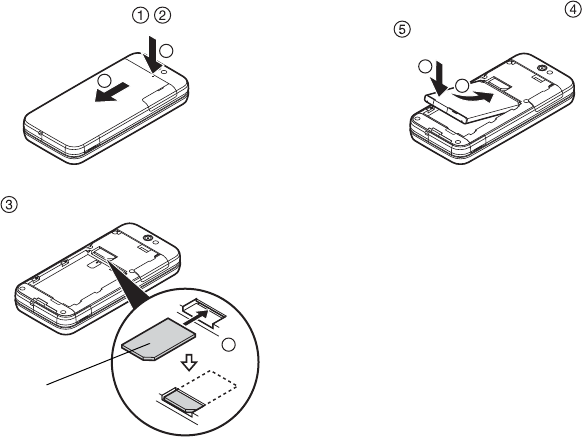
16 Getting Started
Inserting/Removing the SIM/USIM
Card and the Battery
1. Slide off the battery cover ( ).
2. Slide the SIM/USIM card into the SIM/USIM
holder .
3. Hold the battery so that the metal contacts of the
battery are facing down, slide the guides on the top
of the battery into the battery slots , and then
insert it .
4. Replace the battery cover.
Note
•Make sure that only 3V SIM/USIM cards are used.
•Make sure that the standard accessory battery is
used.
1
2
3
SIM/USIM card
4
5
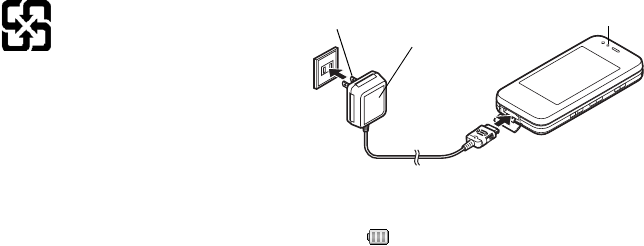
Getting Started 17
Battery Disposal
The device is battery-powered. In order to protect the
environment, please read the following points
concerning battery disposal:
• Take the used battery to your local waste depot,
dealer or customer service centre for recycling.
• Do not expose the used battery to a naked flame,
immerse in water or dispose with the household
waste.
Charging the Battery
You must charge the battery for at least 150 minutes
before using your phone for the first time.
Using the Charger
1. Open the cover of the external connector, and
connect the charger horizontally to the external
socket located at the bottom of the phone until it
clicks.
2. Extend the blades of the charger.
3. Connect the charger to an AC outlet.
When the phone is charging, the battery indicator
icon ( ) displays the current status. The Small
Light also lights up.
Standard charging time: Approx. 150 minutes
Please recycle waste batteries
Small Light
AC Charger
Blade
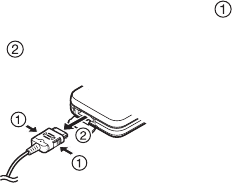
18 Getting Started
Note
•Charging time may vary depending on the state of the
battery and other conditions. (See “Battery” on
page 169.)
To Disconnect the Charger
When charging is completed, the battery indicator icon
displays the full charge status. The Small Light also
turns off when completed.
1. Unplug the charger from the AC outlet.
2. Push and hold the side buttons of the charger ,
then disconnect the charger from the external socket
of the phone .
3. Close the cover.
Note
•Do not use any non-approved chargers as they may
damage your phone and invalidate any warranties,
see “Battery” on page 169 for details.
•Forcibly disconnecting the charger may cause
malfunction.
To Charge Using the Cigarette Lighter Charger
The optional cigarette lighter charger supplies power
for charging from the cigarette lighter socket of a car.
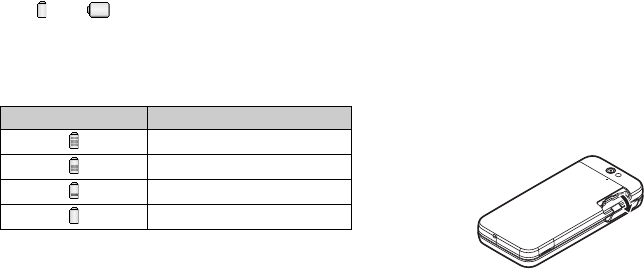
Getting Started 19
Battery Level Indicator
The current battery level is displayed in the upper right
of the screen.
Low Battery during Use
When the battery is running low, an alarm will sound
and “ ” or “ ” is displayed on the screen.
If you are using your phone and you hear the low
battery alarm, attach your charger as soon as possible.
The phone may not be able to continue normal
operation if you continue to use it.
Inserting/Removing the Memory Card
Note
•Make sure that the phone is turned off before
inserting/removing the memory card.
•Be sure to insert the card in the correct direction and
orientation.
•Keep all memory cards out of the reach of small
children.
•If you have difficulties opening the microSD card slot
cover, try again after removing the battery cover.
1. Turn off the phone.
2. Open the microSD card slot cover.
Battery Indicators Charge Level
Sufficiently charged
Charging recommended
Charging required
Empty
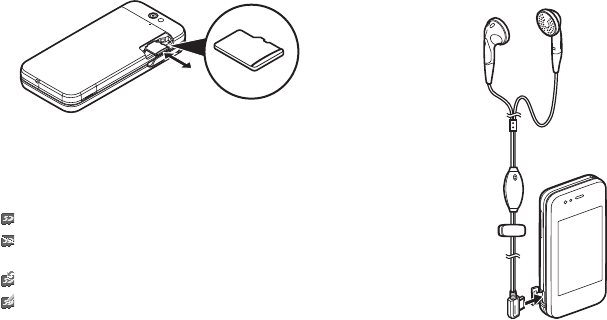
20 Getting Started
3. Insert the memory card until it clicks. (To remove
the memory card, push the memory card until it
clicks.)
4. Close the cover.
Tip
•You see the following indicators when the memory
card is in use:
: Appears when the card is inserted.
: Appears when the card is damaged or unusable.
Make sure the card is properly inserted.
: Appears when the card is being accessed.
: Appears when the card is being formatted.
Connecting the Handsfree Kit
1. Open the connector cover.
2. Connect the handsfree kit.
Getting Started 21
Turning Your Phone On and Off
To turn the power on or off, long press F for
approximately 2 seconds.
To Enter the PIN Code
If the PIN (Personal Identification Number) code is
enabled you are asked to enter the PIN code each time
the phone is switched on. For details on setting the PIN
code, see “Enabling/Disabling the PIN Code” on
page 139.
1. Enter your PIN code.
The PIN code is 4 to 8 digits.
2. Press B.
Note
•If your PIN code is entered incorrectly three times in
a row, the SIM/USIM card is locked. See “Enabling/
Disabling the PIN Code” on page 139.
•If the clock settings have not been entered, the date
and time entry screen is displayed (p. 136).
To Copy All Phonebook Entries from the SIM/
USIM Card
When you insert the SIM/USIM card into your phone
for the first time and start the Phonebook application,
you are asked whether you wish to copy Phonebook
entries on the SIM/USIM card. Follow the on-screen
instructions, or you can do it later using the Phonebook
menu as follows:
“Call Manager”
→
“Advanced”
→
“Copy All
Entries”
1. Select “From SIM to Handset”.
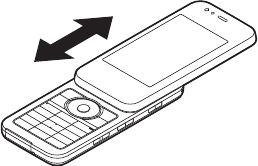
22 Getting Started
Slide Functions and Keypad Lock
When your phone is on, you can answer an incoming
call by sliding open your phone.
You can terminate the call and lock the keypad to
prevent it from being pressed accidentally by sliding
close your phone.
You can also operate the following actions by sliding
open/close your phone.
When opened:
• The display and keypad light up.
• The keypad is unlocked.
• Incoming calls can be answered.
See “Slider Settings” on page 141.
When closed:
• The keypad is locked.
• Calls are terminated.
See “Slider Settings” on page 141.
Note
•Some applications can be used even when your phone
is closed.
•Some Java™ applications are suspended when your
phone is closed.
•Do not stick items on the back of the LCD display
when the slider is open.
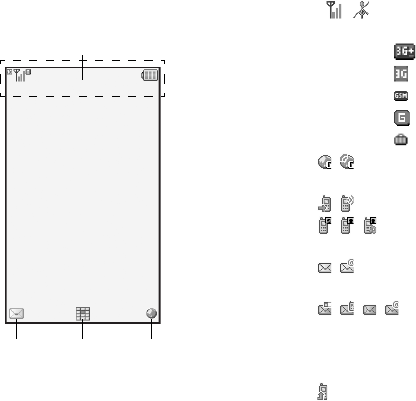
Getting Started 23
Display Indicators 1. / : Strength of received signal/Service out
of range
: HSDPA
: 3G (UMTS)/GPRS
: GSM
: GPRS enabled
: Roaming outside network
2. / : Connection to the server [established/
communicating]
3. / : Voice call [incoming/in progress]
4. / / : Video calling communication mode
enabled [voice/video/voice and video]
5. / : Alerts [text message and multimedia
message/Email]
6. ///:
Mailbox full [SIM/USIM card only/
handset only/both SIM/USIM card and
handset/Email only]
7. : “Voice Calls” diverts set to “Always”
Right soft keyCentre keyLeft soft key
Indicator area
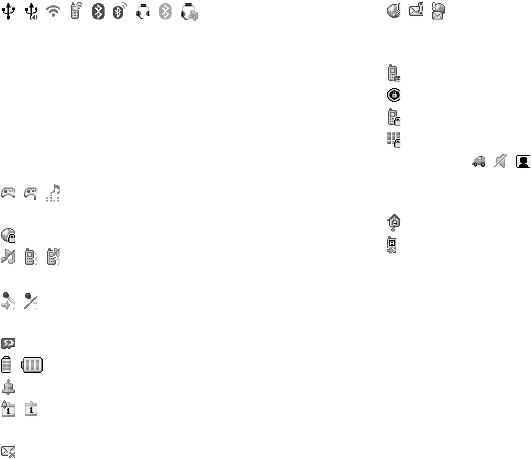
24 Getting Started
8. //////// :
Connection status
[USB cable [stand-by/exchanging
information]/IrDA setting [stand-by/
exchanging information]/Bluetooth
wireless setting [stand-by/exchanging
information/talking with the Bluetooth
headset/Hide my phone/playing back
music with the Bluetooth headset]]
9. / / : Java™ application [executed/
suspended]/Music player
10. : Secure WAP/Web page displayed
11. / / : Silent/vibration setting [silent/vibration
enabled/silent and vibration enabled]
12. / : Speaker mode [speaker phone on/
microphone muted]
13. : Memory card inserted
14. / : Battery level
15. : Daily alarm enabled
16. / : Schedule entry enabled [with/without
reminder alarm]
17. : Outbox contains unsent messages [text
message/multimedia/Email]
18. / / : WAP/OTA provisioning alerts [WAP
alert/OTA provisioning alert/WAP and
OTA provisioning alerts]
19. : Voicemail message alert
20. : “Show Secret Data” set to “On”
21. : Function Lock enabled
22. : Keypad Lock enabled
23. (No display)/ / / :
Current profile [Normal/Car/Silent/
Personal]
24. : Hour minder enabled
25. : Auto answer enabled
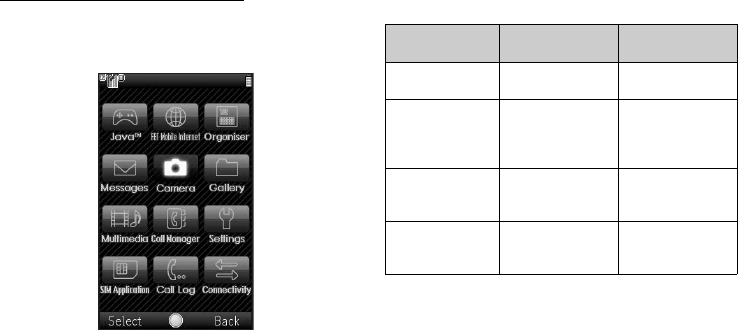
Navigating Functions 25
Navigating Functions
Main Menu
All applications are accessed from the Main menu.
To launch applications, you will need to open the Main
menu, highlight menu items, and then make selections.
For details on menu options, see “List of Menu
Functions” on page 8.
The Main menu and some applications can also be
operated using the side keys (Y, Z, V, W, S, X) when
the phone is closed.
The basic operations for when the phone is open or
closed are as follows.
In certain procedures when the phone is open, you will
need to press one of the soft keys (indicated in square
brackets in this user guide), which are displayed in the
lower left and right of the screen. Press the
corresponding soft key (A or C).
When the Phone
is Open
When the Phone
is Closed
To Access the
Main Menu
Press B in
stand-by.
Press X in
stand-by.
To Select a Menu
Item (indicated in
quotation marks
in this user guide)
Move the cursor
using a, b, c,
d and press B to
select.
Move the cursor
using Y, Z, V, W
and press X to
select.
To Return to the
Previous Screen
Press right soft
key if it displays
Back.
Press S.
To Close the
Main Menu
Press right soft
key if it displays
Back.
Press S.

26 Navigating Functions
The Organiser and Settings menus have tabs.
The operations for selecting an item in these menus are
as follows.
Each section in this user guide starts with a list of items
you will need to select in order (indicated in italics)
before performing the procedures shown. Select each
item to reveal the next set of items that you have to
choose from. Open subsection items after opening
those listed in the main section.
Example:
“Java™”
→
“Java™ Settings”
Example (menu with tabs):
“Settings”
→
“Call/Video Call” tab
→
“Video Calling
Settings”
Operations in Open Position
Shortcut Keys
You can access menus by pressing B and digit keys for
the corresponding number on the Main menu. For
numbers 10 to 12, press B and P (10), Q (11) or
R (12). For menus with tabs, press d (or c when
necessary) to select the desired tab before pressing the
digit keys. See “List of Menu Functions” on page 8.
Shortcuts are listed in the headings of this user guide.
Example (p. 149): To Access “Off Line Mode” Sub
Menu
Off Line Mode
“Settings”
→
“Network Settings” tab
→
“Off Line
Mode”
Press BO and d twice for the “Network Settings”
tab, then press H.
Example (p. 58): To Access “Manage Groups” Sub
Menu
Manage Groups
“Call Manager”
→
“Manage Groups”
Press BNJ.
Note
•The shortcut keys work for the first three menu levels
only.
When the Phone
is Open
When the Phone
is Closed
To Access the
Desired Tab Press c or d.Press Y, Z, V or
W.
To Select a Menu
Item (indicated in
quotation marks
in this user guide)
Move the cursor
using a or b and
press B to select.
Move the cursor
using Y, Z, V, W
and press X to
select.
(M 9-d-d-2)
(M 8-4)
Navigating Functions 27
Shortcuts
Your phone has a shortcut function (press E in
stand-by) which enables you to access the desired menu
quickly. The default shortcuts are as follows (shortcuts
assigned to G-O can be customised):
• Main menu
• Enter Phone Number
•G: Inbox
•H: Create Message
•I: Bookmarks
•J: Calendar
•K: Phonebook
•L:Gallery
•M: Calculator
•N:Alarms
•O:Bluetooth
To Use the Shortcut Key
1. Press E in stand-by.
2. Select the desired item or number.
To Customise the Assigned Shortcuts
1. Press E in stand-by.
2. Highlight the shortcut you wish to customise from
G-O.
3. Press [Options] and select “Assign”.
The list of the available items is displayed.
4. Select the desired item.
Note
•To move the item in the list that appears in step 1,
highlight the item, press [Options] and select
“Move”. Then press a or b to the desired location
and press B.
•To reset the customised shortcut, press [Options] and
select “Set to Default” in step 2.

28 Navigating Functions
Operations in Closed Position
Using the Side Keys
You can navigate functions when your phone is closed by using the side keys. Operations differ as follows depending
on the direction the phone is held.
Using the Multimedia Menu
You can navigate the Multimedia menu when the phone is closed using the side keys. For details, see “Navigating
the Multimedia Menu when the Phone is Closed” on page 67.
Direction
Side Key Normal Position Rotated 90° to the Right
(turn clockwise)
Rotated 90° to the Left
(turn counter clockwise) Upside Down
Multimedia Y
Moves cursor to the left.
Long press to activate
Keypad Lock.
Moves cursor down.
Long press to activate
Keypad Lock.
Moves cursor up.
Long press to activate
Keypad Lock.
Moves cursor to the right.
Long press to activate
Keypad Lock.
Send Z
Moves cursor to the right.
Long press to switch
to Silent mode.
Moves cursor up.
Long press to switch to
Silent mode.
Moves cursor down.
Long press to switch to
Silent mode.
Moves cursor to the left.
Long press to switch
to Silent mode.
Up VMoves cursor up.
Long press to scroll up.
Moves cursor to the right.
Long press to repeatedly
move to the right.
Moves cursor to the left.
Long press to repeatedly
move to the left.
Moves cursor down.
Long press to scroll
down.
Down W
Moves cursor down.
Long press to scroll
down.
Moves cursor to the left.
Long press to repeatedly
move to the left.
Moves cursor to the right.
Long press to repeatedly
move to the right.
Moves cursor up.
Long press to scroll up.
End SReturns to previous screen.
Long press to activate Display Saving.
Camera XExecutes the function.
Long press in stand-by to activate the camera.
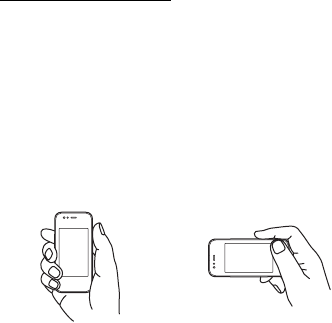
Motion Control 29
Motion Control
Your phone has a sensor which can detect motion or
changes in direction. You can change the picture being
displayed or activate an application when your phone is
closed, just by moving it in a certain way. (This is
available in portrait and landscape position.)
For details on the settings for motion control, see
“Motion Control Settings” on page 137.
Holding the Phone Correctly
Before Using Motion Control
Make sure that the phone is in the following status.
The Slider is Closed
This function is not available when the slider is open.
The Display is Turned On
This function is not available when the display is turned
off.
To Turn On the Display
Press any side key.
Keypad Lock is Deactivated
This function is not available when the keypad is
locked.
To Deactivate Keypad Lock
Long press Y.
“Action Settings” for Motion Control is
Enabled
“Settings”
→
“Phone Settings” tab
→
“Motion
Control”
To Change the Direction of the Screen
Automatically
1. Select “Display Change”.
2. Select “Auto”.
Portrait Position Landscape Position
Hold the phone so it fits
in the palm of your hand.
Hold the phone firmly.
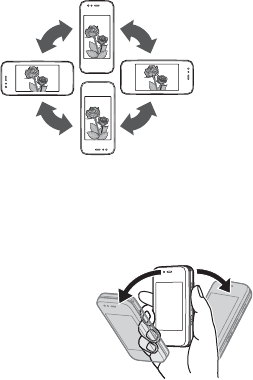
30 Motion Control
To Enable Quick Shortcut
1. Select “Quick Shortcut”.
2. Select “Switch On/Off”.
3. Select “On”.
To Enable Other Settings
1. Select “Action Settings”.
2. Select the desired action.
3. Select “On”.
Motion Control Functions
Change the Direction of the Screen
Enlarge or Shrink the Contents of the Screen
(Portrait/Landscape Position)
Zoom in on or zoom out from a picture, or enlarge or
shrink the contents of a WAP/Web page by tilting the
phone forward or backward.
The screen
automatically
changes direction
according to the
direction the
handset is rotated.
Enlarge Shrink
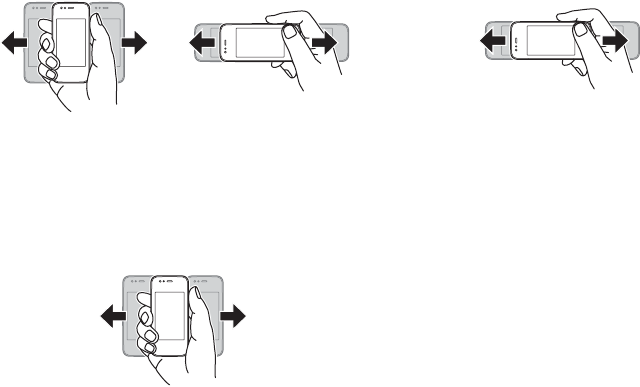
Motion Control 31
Select a Sound File or Picture
(Portrait/Landscape Position)
Select the previous or next picture, sound or document
file by shaking the phone once to the left or to the right.
Quick Shortcut
Set your phone so an application is activated by shaking
the phone sideways a few times. (This is only available
in stand-by.)
You can access the Gallery folder by shaking the phone
sideways about 3 times in portrait position.
In landscape position, you can access the Java™
Gallery folder by shaking the phone sideways about 3
times.
The application set to Quick Shortcut can be changed.
To Change the Assigned Quick Shortcut
“Settings”
→
“Phone Settings” tab
→
“Motion
Control”
→
“Quick Shortcut”
→
“Quick Shortcut
Entry”
1. Select “Portrait” or “Landscape”.
2. Select the desired application and press [Assign].
Note
•To delete an assigned shortcut, highlight “Portrait”
or “Landscape” in step 1, press [Options] and then
press [Delete].
•To reset the assigned shortcut, highlight “Portrait”
or “Landscape” in step 1, press [Options] and then
press [Reset Settings].
About 3×
About 3×

32 Motion Control
Tapping
Set your phone so the application currently being used
can be ended by tapping the back of the phone a few
times (3 to 5 times). (The phone returns to stand-by.)
Note
•Tapping may not be recognised or may accidentally
react when sound is being emitted or played back.
•This function is not available when the phone is
receiving an incoming call, is receiving/sending
data, is vibrating, or an alarm is sounding.
Quick Silent
Quickly silence your phone (the ringtone, alarm tone,
etc.) just by turning the phone over.
Note
•Make sure to set “Quick Silent” in “Action Settings”
to “On” before using this function.
•Depending on the volume and the type of sound, the
phone may not be completely muted.
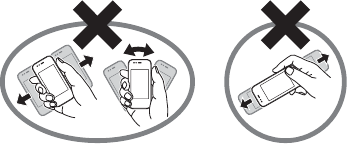
Motion Control 33
Practicing the Action
You can practice and confirm the actions set in the
motion control settings.
“Settings”
→
“Phone Settings” tab
→
“Motion
Control”
→
“Action Test”
1. Select “Portrait”, “Landscape”, “Zoom in/out”,
“Select Contents” or “Back Tap”.
2. Perform the selected action to test the setting.
Note
•A confirmation tone sounds when an action is
recognised.
•Motion control may not function correctly depending
on the way the phone is held, shaken or tapped.
•When shaking the phone, try to keep it as level as
possible.
•Do not shake the phone at an angle.
•When using motion control, make sure to hold on to
the phone firmly and not to shake the phone too
strongly. Confirm that there is enough space around
you to ensure the safety of others. Failing to do so
may result in injury or damage to the phone or
objects near by.
•Tapping may not be recognised while playing back
music with Music Player.

34 Voice Call/Video Calling Functions
Voice Call/Video Calling
Functions
Making a Voice Call
1. Enter the area code and the phone number you wish
to dial, and then press D to dial.
If you enter the wrong number, press U to delete
the number to the left of the cursor.
Emergency Calls
1. Enter 112 or 911 using the keypad and press D to
dial.
Note
•Emergency calls may not be able to be made on all
mobile phone networks when certain network
services and/or phone features are in use. Contact
your service provider for more information.
•This emergency number can normally be used to
make an emergency call in any country, with or
without a SIM/USIM card inserted, if a 3G (UMTS)/
GSM network is within range.
International Calls
1. Long press Q until a + (international dialling
prefix) sign is displayed.
2. Enter the country code, followed by the area code
(without the leading zero) and the phone number,
and press D to dial.
Adding an Entered Phone Number to the
Phonebook
1. After entering a phone number, press [Options] and
select “Save Number”.
For details on creating a new entry, see “Adding a
New Phonebook Entry” on page 52.
Showing or Hiding My Phone Number on the
Display of the Called Party
1. After entering a phone number, press [Options],
select “Show My ID” or “Hide My ID” and press
D to dial.
Voice Call/Video Calling Functions 35
Speed Dialling
The digit keys (G to O) can be used for speed dial.
Up to 8 phone numbers from the Phonebook memory
(Handset and SIM/USIM) can be assigned to H to
O. The phone number of the Voicemail centre is
assigned to G.
For details on setting the speed dial list, see “Speed Dial
List” on page 59.
1. To dial a number using the speed dial, long press
any of the digit keys (G to O) in stand-by.
The phone number saved in the speed dial list is
dialled.
Redialling
You can redial numbers in the call log. Select from
specific categories or “All Calls”. Specific categories
contain up to 30 numbers and the “All Calls” list
contains up to 90.
1. Press D in stand-by.
2. Select the category from “All Calls”, “Dialled
Numbers”, “Missed Calls” or “Received Calls”.
To switch logs, press c or d.
3. Highlight the phone number you wish to call.
4. Press D to redial a voice call or T to redial a
video calling.
Answering a Voice Call
When an incoming call is detected, the phone rings.
1. Press D or B to answer the call.
Or press any key except F, U, S, [Options],
[Busy], X or side keys when the “Any Key Answer”
function is enabled. Set the Any Key Answer
function in the profile of each mode (p. 127).
You can answer an incoming call by sliding open
your phone if “Calls on Open” is set to “On” in
Slider Settings (p. 141).
Tip
•If you have subscribed to the Calling Line
Identification (CLI) service and the caller’s network
sends the number, the caller’s number is displayed on
the screen. If the caller’s name and number are saved
in the Phonebook, the caller’s name is displayed on
the screen.
•If the number is a restricted number, the display
shows “Withheld”.
•When you receive a call from the person whose
picture is registered in the Phonebook, the picture
and name are displayed.
36 Voice Call/Video Calling Functions
Rejecting an Incoming Call
1. Press F while the phone is ringing to reject a call
you do not wish to answer.
Letting the Caller Know You are Unavailable
1. Press [Busy] while the phone is ringing to send a
busy tone to the caller.
In Call Menu (Voice Call)
Your phone has additional functions available while a
call is in progress.
Adjusting the Earpiece Volume
You can adjust the earpiece volume to five levels.
1.
Press
V
or
W
to display the Earpiece Volume screen.
2. Press V (or a/d) to increase the volume of the call
or press W (or b/c) to decrease the volume.
3. Press B when the volume is set to the desired level.
Turning the Speaker On and Off
You can talk via the loudspeaker on the phone when it
is on.
1. During a call, press B.
Putting a Call on Hold
This function allows you to manage two calls at the
same time. If you wish to make another call while you
are talking to someone, you can put the current call on
hold to call someone else.
To Make Another Call during a Call
1. During a call, press [Options] and select “Hold”.
The current call is put on hold.
2. Press [Options] and select “Dial New Number”.
3. Enter the phone number you wish to make another
call to, then press D.
Tip
•You can also make another call by entering the phone
number during a call instead of step 1. The current
call is automatically put on hold.
Voice Call/Video Calling Functions 37
Accessing SMS/MMS Menu during a Call
1. During a call, press [Options] and select
“Messages”.
The following options are available: “Create
Message” to make an SMS and MMS, or “Inbox”,
“Sent” or “Drafts” to access these folders. For
details on SMS and MMS, see “SMS” and “MMS”
on page 78.
Call Waiting
This service notifies you of another incoming call while
you have a call in progress.
1. During a call, press [Options] and select “Hold &
Answer” to answer the second call.
The first call is put on hold and you can now talk to
the second caller.
You can also answer the second call by pressing
D.
Note
•You need to set “Call Waiting” to “On” if you wish
to use the Call Waiting service (p. 148).
•Call Waiting service may not be available on all
networks. Contact your service provider for more
information.
•If you do not wish to answer the second call, press
[Options] and select “Busy” in step 1. If “Reject” is
selected, the log of the second call is saved as a
missed call.
Conference Call
Conference call is a call with more than 2 participants.
You may include up to 5 participants in a conference
call.
To Make a Conference Call
You must have one active call and one held call.
1. During a call, press [Options] and select
“Conference All” to join the conference call.
2. Press F to end the conference call.
38 Voice Call/Video Calling Functions
Note
•The conference call service may not be available on
all networks. Contact your service provider for more
information.
•To end the call with all participants, press [Options]
and select “End All Call(s)”.
•To reject adding more participants to the current
party, press [Options] and select “Reject”, or you
can send the busy tone by selecting “Busy”.
•You have more options for the conference call after
selecting “Conference All” in step 1:
•To put all participants on hold, select “Hold All”.
•To put all participants except the current call on
hold, select “Private”.
To Add New Participants to the Conference Call
1. Press [Options] and select “Dial New Number”.
2. Enter the number you wish to include in the
conference call and press D to dial.
3. Press [Options] and select “Conference All” to join
the conference call.
If you wish to add other participants, repeat steps 1
to 3.
To End the Call with a Conference Call Participant
1. During a conference call, highlight the person that
you wish to disconnect from the conference call.
2. Press [Options] and select “End This Call”.
To Have a Private Conversation with One of the
Participants
If you wish to have a private conversation with one of
the participants, you may select the participant from the
conference list and put the other participants on hold.
1. During a conference call, select the person that you
wish to talk to.
2. Press [Options] and select “Private”.
3. Once you have finished the private conversation,
press [Options] and select “Conference All” to
return to the conference call.
Muting the Microphone
1. During a call, press [Mute].
To use the microphone again, press [Unmute].
Voice Call/Video Calling Functions 39
Making a Video Calling
Note
•Video callings can only be made and received if both
parties have 3G capable phones and 3G coverage.
See “Display Indicators” on page 23.
•Make sure that the battery is fully charged and the
signal is strong before using this function.
•Turn the loudspeaker on or use a handsfree kit so that
you can talk while looking at the video calling screen
on the display.
•Use the camera to send live video images.
Making a Video Calling
To Make a Video Calling by Entering the Phone
Number First
1. Enter the area code and the phone number you wish
to dial, and then press T to dial.
If you enter the wrong number, press U to delete
the number to the left of the cursor.
When connected, the image of the called party and
yours are displayed on the screen.
Tip
•If the called party’s phone is not video calling
enabled, you can press F and enter the phone
number again to make a voice call.
Answering a Video Calling
When an incoming call is detected, the phone rings.
1. Press D to answer the call with video, or press B
or [Options] and select “Hide Picture” to answer
with voice only.
Tip
•If you have subscribed to the Calling Line
Identification (CLI) service and the caller’s network
sends the number, the caller’s number is displayed on
the screen. If the caller’s name and number are saved
in the Phonebook, the caller’s name is displayed on
the screen.
Rejecting an Incoming Call
1. Press F while the phone is ringing to reject a call
you do not wish to answer.
Letting the Caller Know You are Unavailable
1. Press [Busy] while the phone is ringing to send a
busy tone to the caller of an incoming call letting
them know that you cannot answer the call.
40 Voice Call/Video Calling Functions
In Call Menu (Video Calling)
Muting the Microphone
1. During a video calling, press [Mute].
To use the microphone again, press [Unmute].
Swapping Images
You can swap images displayed on the video calling
screens.
1. During a video calling, press [Options] and select
“Switch Images”.
2. Select “Priority to Incoming”, “Priority to
Outgoing”, “Incoming Up” or “Outgoing Up”.
Changing the Outgoing Image
During a video calling, you can switch the image shown
to the caller between the camera image and an
alternative image.
1. During a video calling, press [Options] and select
“Camera Picture”.
2. Select “External Camera” or “Alternative Image”.
“External Camera”: The image through the
camera is displayed and sent
to the receiver.
“Alternative Image”: The camera is turned off and
the image selected in
“Alternative Image” of
“Video Calling Settings”
(p. 143) is used.
Turning the Speaker On and Off
You can talk via the loudspeaker on the phone when it
is on.
1. During a video calling, press [Options] and select
“Loudspeaker On”.
Note
•In a high-noise environment, you may not be able to
continue a call or make a clear call. We recommend
that you use the handsfree kit.
•With this option, there may be interruption if you
increase the earpiece volume. We recommend that
you decrease the earpiece volume or use the
handsfree kit.
Voice Call/Video Calling Functions 41
Video Calling Settings
To Adjust the Quality of the Incoming or Outgoing
Image
You can adjust the quality of the called party’s or
caller’s image.
1. During a video calling, press [Options] and select
“Video Calling Settings”.
2. Select “Incoming Picture Quality” or “Outgoing
Picture Quality”.
3. Select “Normal”, “Quality Priority” or “Frame Rate
Priority”.
“Normal”: The standard quality is used.
“Quality Priority”: The quality of the picture
takes precedence over the
frame rate.
“
Frame Rate Priority
”: The frame rate takes
precedence over the quality.
To Turn the Backlight On or Off
You can turn on the backlight of your screen.
1. During a video calling, press [Options] and select
“Video Calling Settings”.
2. Select “Backlight”.
3. Select “Always On”, “Always Off” or “As Normal
Setting”.
When “Always On” is selected, the backlight will
always be on during a video calling.
When “As Normal Setting” is selected, the
backlight will time out depending on the Backlight
setting (p. 129).
To Adjust the Video Exposure
1. During a video calling, press [Options] and select
“Video Calling Settings”.
2. Select “Exposure”.
3. Press a (Light) or b (Dark).

42 Entering Characters
Entering Characters
When entering characters to create Phonebook entries,
text messages or multimedia messages, etc., press the
corresponding keys.
In multi-tap input method, press each key until the
desired character is displayed. For example, press H
once for the letter A or twice for the letter B.
Press the following keys to:
Long press the following keys to:
Changing the Input Language
1. On the text entry screen, press [Options] and select
“Input Language”.
2. Select the desired language.
G:Enter:
. (full-stop) , (comma) ? ! : ; ' (apostrophe) " / 1
Q:Enter:
(space) + = < > € £ $ ¥ % & 0
P: Switch character case among four modes:
Abc, ABC, abc and 123.
R: Display the pictograms and symbols input
screen.
G-O: Enter 1-9 numbers.
Q: Enter space in Numeric mode or to
enter 0 in other modes.
P: Shift between multi-tap and T9 mode.
R: Display the Input Language options
screen.
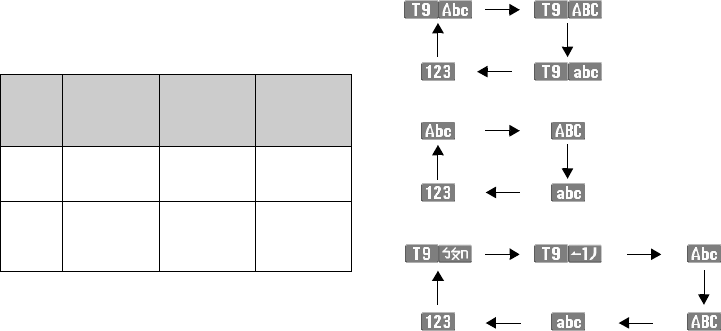
Entering Characters 43
Changing the Input Method
1. On the text entry screen, press [Options] and select
“Input Method”.
2. Select the input method you wish to use.
Tip
•In T9 or multi-tap mode, you can switch input mode
as follows by pressing P.
English/T9 mode
English/Multi-tap mode
Traditional Chinese/T9 mode
Input
Method
Input
Language
= English
Input
Language
= Traditional
Chinese
Input
Language
= Simplified
Chinese
T9
Mode
T9 Abc
T9 ABC
T9 abc
T9 BoPoMoFo
T9 Stroke
T9 PinYin
T9 Stroke
Multi-tap
mode
Abc
ABC
abc
Numeric
Abc
ABC
abc
Numeric
Abc
ABC
abc
Numeric
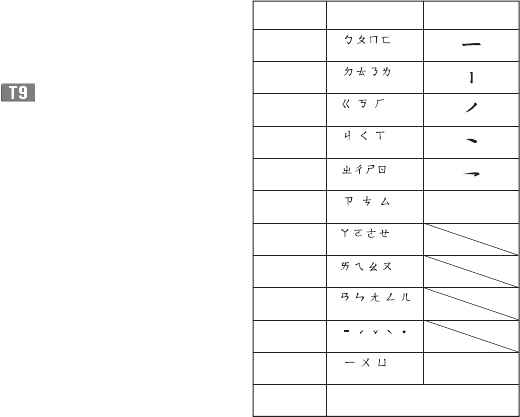
44 Entering Characters
T9 English Mode
Using T9 English Mode
T9 text input method is a shortcut to enter text easily
and quickly.
1. On the text entry screen, press [Options].
2. Select “Input Method”.
3. Select the T9 mode (T9 Abc, T9 ABC, T9 abc) you
wish to change. “ ” is displayed on the screen.
4. Press the keys to enter characters.
5. Press a or b to select the word you wish to input.
6. If you wish to clear the word, highlight it and long
press U.
7. Press B to complete the selection.
Tip
•If you press Q instead of step 6, a space is inserted
next to the selected word.
T9 BoPoMoFo and T9 Stroke Mode
In T9 BoPoMoFo and T9 Stroke mode, keys are as follows.
T9 BoPoMoFo and T9 Stroke Mode Keys
Key BoPoMoFo Stroke
Space
Wildcard
Go to the pictograms and symbols input screen.
G
H
I
J
K
L
M
N
O
P
Q
R

Entering Characters 45
G-O: Long press to input corresponding
Chinese character displayed in the
candidate field.
P: Press to change the input method.
Long press to enter tones
“ ” in T9 BoPoMoFo
mode.
R: Press to display the FullWidth
Symbols screen.
Long press to display the Input
Language screen.
Changing the Input Method between Stroke
and BoPoMoFo
See “Changing the Input Method” on page 43.
Using BoPoMoFo Input Mode
Long press the
corresponding numeric
key to select the desired
character directly from
the candidate field.
Candidate field
Input field
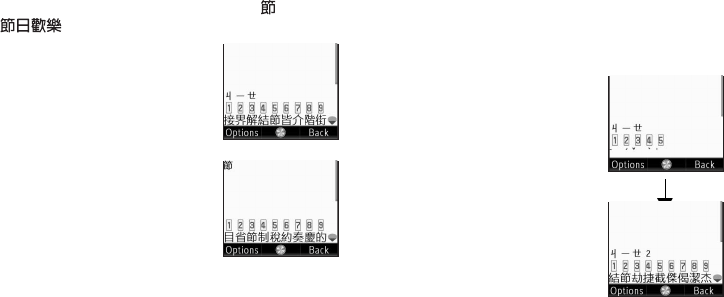
46 Entering Characters
The following is an example of entering “ ” for
“”.
1. Press J, Q, and M (2
times quickly) to enter
reading.
The candidates with the same
reading are displayed in the
candidate field.
2. Long press K if the desired
character is displayed.
3. Repeat steps 1 and 2 to complete messages.
Tip
• When the cursor is placed after the first character,
the candidate field displays characters most likely to
follow.
• If you want to use tone options,
long press P instead of step 2
to display the desired
character. The tone symbols are
displayed in the candidate field.
The candidates are displayed.
Press the corresponding
numeric key (H).
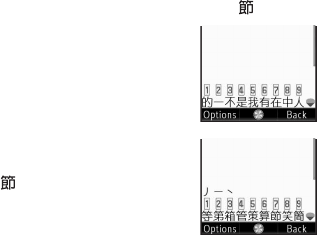
Entering Characters 47
Using Stroke Mode
The following is an example of entering “ ”.
1. Change the input mode to T9
Stroke mode.
2. Press I G J to display
the corresponding stroke for
“”.
3. Long press the corresponding key to complete the
selection (in this case M).
Selecting the Character to Input
1. Perform steps 1 and 2 in “Using BoPoMoFo Input
Mode” on page 45 or “Using Stroke Mode”.
2. Press b to highlight the Chinese character.
3. Press c or d to select the character you wish to
input and press B.
You can also enter the desired Chinese character by
pressing the candidate number directly using the
keypad.
Entering Pictograms and Symbols
1. On the text entry screen, press [Options] and select
“Add Symbol”.
The history for the pictograms screen is displayed
first.
Press A to see all pictograms.
Press C to switch to the symbols screen.
2. Select the pictogram or symbol you wish to use and
press B.
Note
•Pictograms are only available for SMS/MMS
messages and Text Template. However, pictograms
can be used in an application other than SMS, MMS
or Text Template in the following cases:
•When the pictogram is saved in a text template and
that text is inserted using “Insert Template”.
•When pasting text using “Copy” and “Paste”.
48 Entering Characters
User Dictionary
You can create your own word list for alphabet text and
T9 Chinese input.
English User Dictionary
Note
•This function is only available when “Input
Language” is set to “English”.
To Create a New Entry
1. On the text entry screen, press [Options] and select
“User Dictionary”.
2. Select “Add New Word”.
3. Enter a new word.
To Edit a Word in the List
1. On the text entry screen, press [Options] and select
“User Dictionary”.
2. Highlight the desired word.
3. Press [Options] and select “Edit”.
4. Modify the word.
To Delete a Word
1. On the text entry screen, press [Options] and select
“User Dictionary”.
2. Highlight the desired word.
3. Press [Options] and select “Delete”.
4. Select “Yes” or “No”.
Chinese User Dictionary
You can enter Chinese characters, alphabet, symbols
and numbers for Chinese word lists.
Note
•This function is only available when “Input
Language” is set to “Traditional Chinese” or
“Simplified Chinese”.
•Only capital letters can be used for acronyms.
To Create a New Entry
1. On the text entry screen, press [Options] and select
“Chinese User Dictionary”.
2. Select “Add New Word”.
3. Enter a new word.
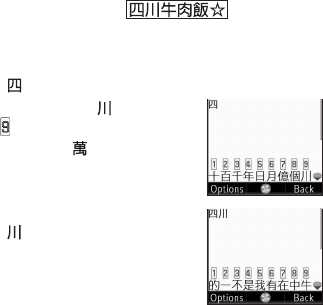
Entering Characters 49
To Edit a Word in the List
1. On the text entry screen, press [Options] and select
“Chinese User Dictionary”.
2. Highlight the desired word.
3. Press [Options] and select “Edit”.
4. Modify the entry word.
To Delete a Word
1. On the text entry screen, press [Options] and select
“Chinese User Dictionary”.
2. Highlight the desired word.
3. Press [Options] and select “Delete”.
4. Select “Yes” or “No”.
Finding an Entry
You can recall Chinese word entries by entering the
first few characters.
The following is an example from the Chinese User
Dictionary.
Please notice the word is already
stored at this example.
1. Press L (3 times quickly),
then long press G and enter
“”.
2. The character “ ” appears at
.
Normally “ ” appears here.
3. Long press O and enter
“”.
This example is
using BoPoMoFo
mode
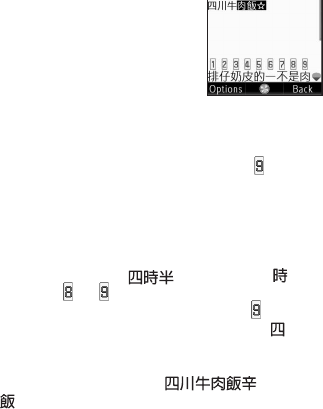
50 Entering Characters
4. Long press O, then the
following characters appear.
Note
•This function is not available, if the entry word is less
than 4 letters or no Chinese characters are included.
Since the candidate characters appear at , you can
use this as a shortcut if the word is made up of
Chinese characters. You only have to long press O
without having to search for the characters which
follow.
•If there was a stored word which shares the first 1-4
characters, such as “ ”, candidate “ ”
appears at or .
The most recently used entry appears at , and if
there were 3 or more entries that start with “ ”, the
oldest candidate is erased.
•If there were a stored word that shares the first 5 or
more characters, such as “ ”, after
“ ” is entered, the entry is completed with the most
recently used character.
Using Templates
You can use the phrases registered in Text Templates
when entering characters.
For details on creating the text template, see “Adding
Phrases to Text Templates” on page 121.
1. On the text entry screen, move the cursor to the
point you wish to insert the template.
2. Press [Options] and select “Advanced”.
3. Select “Insert Template”.
4. Select the desired text template.
Entering Characters 51
Copying, Cutting and Pasting Text
1. On the text entry screen, press [Options] and select
“Advanced”.
2. Select “Copy” or “Cut”.
3. Move the cursor to the first letter to be copied or to
be cut, then press B.
4. Move the cursor to the last letter to highlight the
area, then press B.
5. Move the cursor to the point you wish to paste the
letters.
6. Press [Options] and select “Advanced”.
7. Select “Paste”.
8. Select the desired item.
Insert Phonebook Entries
You can insert the entries registered in Phonebook
when entering characters.
For details on creating the Phonebook entries, see “Call
Manager” on page 52.
1. On the text entry screen, move the cursor to the
point you wish to insert the Phonebook Entry.
2. Press [Options] and select “Advanced”.
3. Select “Insert Phonebook Entry”.
4. Select the desired Phonebook Entry.
The selected entry is inserted.

52 Call Manager
Call Manager
You can store the phone numbers and Email addresses
of your friends, family and colleagues in the
Phonebook.
Your phone can store up to 1000 entries. For each entry,
you can enter information including up to 5 phone
numbers and 5 Email addresses. There is a limit to the
number of characters that can be entered for each item.
The character limit differs for the handset memory and
SIM/USIM card memory.
Adding a New Phonebook Entry
The amount of phone numbers that you can store to the
SIM/USIM card is dependent on its capacity. Contact
your service provider for details.
Selecting the Storage Memory
You can choose either the phone or SIM/USIM card
memory locations to store the new entry.
“Call Manager”
→
“Phonebook Settings”
→
“Save
to”
1. Select from “Handset”, “SIM” or “Choice”.
Tip
•“Choice” prompts you to choose the memory every
time you save a new entry.
Registering a New Entry
“Call Manager”
→
“Add New”
If you select the “Choice” option for the memory to be
used, the selection is between “To Handset” and “To
SIM”.
1. Select the field you wish to fill in, and enter the
relevant information.
2. Press [Save] when finished.
Tip
•To create an entry, at least one field must be filled
(“Last Name”, “First Name”, “Add Phone Number”
or “Add Email Address” for the handset memory;
“Name”, “Add Phone Number” or “Add Email
Address” for the USIM memory; “Name” or “Add
Phone Number” for the SIM memory).
(M 8)
(M 8-8-3)
(M 8-2)
Call Manager 53
Saving an Unregistered Number
After a call ends, you can have the confirmation screen
asking you if you wish to register the number to the
Phonebook.
“Call Manager”
→
“Phonebook Settings”
→
“Save
Unregistered”
1. Select “Incoming Call” or “Outgoing Call”.
2. Select “On” or “Off”.
Registering My Card
You can register and edit your own contact as with
other Phonebook entries.
“Call Manager”
→
“My Card”
Searching for an Entry
You can search for the desired entry by entering the first
few letters of the name or by sorting the entries.
Changing the List Displayed
“Call Manager”
→
“Phonebook Settings”
→
“Source”
1. Select from “Handset”, “SIM” or “Both”.
Finding a Name
“Call Manager”
→
“Phonebook”
1. Enter the first few letters of the name.
The first name corresponding to the entered letters
is highlighted.
Sorting the Phonebook Entries
When Simplified Chinese is selected, you can change
the listing order of the Phonebook entries to PinYin
order or by different groups.
When another language is selected, you can change the
listing order of the Phonebook entries to BoPoMoFo
order or by different groups.
“Call Manager”
→
“Phonebook Settings”
→
“View
Phonebook”
1. For Simplified Chinese, select “By PinYin” or “By
Group”. For another language, select “By
BoPoMoFo” or “By Group”.
(M 8-8-5)
(M 8-5)
(M 8-8-2)
(M 8-8-1)
54 Call Manager
Selecting the Search Mode
“Call Manager”
→
“Phonebook Settings”
→
“Search
Mode”
1. For Simplified Chinese, select “Character Search”,
“PinYin Search” or “English Search”. For another
language, select “Character Search”, “BoPoMoFo
Search” or “English Search”.
Dialling from the Phonebook
“Call Manager”
→
“Phonebook”
1. Highlight the desired entry and press D (voice
call) or T (video calling).
Tip
•If more than one phone number is registered for the
entry, highlight the desired phone number after step
1 and press D (voice call) or T (video calling).
•You can also dial from the details screen of the
Phonebook. On the details screen, select the desired
phone number and press D (voice call) or T
(video calling).
Dialling a Service Phone Number
Certain SIM/USIM cards contain service phone
numbers that can be dialled. Contact your SIM/USIM
card vendor for more information. On the Phonebook
screen, “Service Dialling No.” is displayed.
“Call Manager”
→
“Service Dialling No.”
1. Select the desired service phone number.
Tip
•If the SIM/USIM card contains only one service
phone number, you can dial it in step 1 by pressing
B.
•If no service phone number is stored in the SIM/
USIM card, this menu cannot be selected.
(M 8-8-4) (M 8-9)
Call Manager 55
Sending a Message from the
Phonebook
“Call Manager”
→
“Phonebook”
1. Select the desired entry including the phone number
or Email address you wish to use.
2. Select the desired phone number or Email address.
3. When a phone number is selected in step 2, select
“Create Message”.
For further procedures, see “Creating a New
Message” on page 79.
Using Mailing Lists
You can create a mailing list to send the same message
to a group of recipients at once. Up to 20 groups can be
registered.
To Create a New Mailing List
“Call Manager”
→
“Message Groups”
→
“Add New
Group”
1. Enter the group name.
The new group name is displayed following the last
group on the Group List screen.
To Add Recipients to a Group
Up to 20 recipients can be registered in each list.
“Call Manager”
→
“Message Groups”
1. Select the desired group name.
2. Select “Assign New Entry”.
3. Select the desired entry.
The detailed screen is displayed.
4. Select the desired phone number or Email address.
Tip
•If you modify the entry assigned in the group, you
need to re-assign it to the group. Select the entry,
press [Options], then select “Re-assign Entry” in
step 2.
•To remove an entry from the group, select the entry,
press [Options], then select “Remove Entry” in step
2.
•To remove a group, press [Options] and select
“Delete” in step 1.
To Send a Message Using a Mailing List
“Call Manager”
→
“Message Groups”
1. Highlight the desired group name.
2. Press [Options] and select “Create Message”.
For further procedures, see “Creating a New
Message” on page 79.
(M 8-7)
(M 8-7-1)
56 Call Manager
Editing Phonebook Entries
“Call Manager”
→
“Phonebook”
1. Highlight the entry you wish to edit.
2. Press [Options] and select “Edit”.
3. Modify the information.
4. Press [Save] when finished.
Adding a Thumbnail to Entries
Only Phonebook entries saved to the handset can have
thumbnails attached to them.
“Call Manager”
→
“Phonebook”
1. Highlight the desired entry.
2. Press [Options] and select “Edit”.
3. Select “Picture”.
4. Select “Assign Picture”.
5. Select the desired picture.
6. Press [Save] when finished.
Note
•If you delete a picture in the handset memory, the
corresponding thumbnail is also deleted.
•You can take a picture for a thumbnail by selecting
“Take Picture” in step 4.
Assigning a Ringtone or a Ring Video Clip to
Each Entry
“Call Manager”
→
“Phonebook”
1. Highlight the desired entry.
2. Press [Options] and select “Edit”.
3. Select “Tone/Video for Voice Call”, “Tone/Video
for Video Calling” or “Tone/Video for New
Message”.
4. Select “Assign Tone”.
5. Select “Preset Sounds”, “Sound Gallery”, “Video
Gallery” or “Flash®”.
6. Select the desired tone or video clip.
For details on selecting a ringtone or a ring video
clip, see “Assigning a Ringtone for an Incoming
Call” or “Assigning a Ring Video Clip for an
Incoming Call” on page 133.
7. Press [Save] when finished.
Call Manager 57
Deleting Phonebook Entries
Deleting All Phonebook Entries
“Call Manager”
→
“Advanced”
→
“Delete All
Entries”
1. Select from “Handset Entries”, “SIM Entries” or
“Both Entries”.
2. Enter your handset code.
The default handset code is “9999”. For details on
changing the handset code, see “Changing the
Handset Code” on page 140.
Deleting a Phonebook Entry
“Call Manager”
→
“Phonebook”
1. Highlight the desired entry.
2. Press [Options] and select “Delete”.
Managing the Phonebook
Copying Phonebook Entries between SIM/
USIM Card and Handset
“Call Manager”
→
“Advanced”
→
“Copy All
Entries”
1. Select “From SIM to Handset” or “From Handset to
SIM”.
Note
•When you insert the SIM/USIM card into your phone
for the first time and start the Phonebook application,
the confirmation screen is displayed automatically,
asking you if you wish to copy or not. The number of
Phonebook entries to be copied varies depending on
the SIM/USIM capacity.
•If the memory space is not enough to save all entries,
you cannot complete copying.
(M 8-10-3)
(M 8-10-1)
58 Call Manager
Sending a Phonebook Entry
“Call Manager”
→
“Phonebook”
1. Highlight the desired entry.
2. Press [Options] and select “Send Phonebook”.
3. Select “As Message”, “As Email”, “Via Bluetooth”
or “Via Infrared”.
For “As Message”
For details, see “MMS” on page 78.
For “As Email”
For details, see “Email” on page 78.
For “Via Bluetooth”
For details, see “Bluetooth” on page 154.
For “Via Infrared”
For details, see “Infrared” on page 157.
Receiving a Phonebook Entry
When the phone receives a Phonebook entry, a
confirmation message is displayed in stand-by.
1. Select “Yes”.
The received entry is saved in the Phonebook.
Select “No” to reject.
Tip
•For details on entering Infrared or Bluetooth
wireless settings, see “Connectivity” on page 154.
Manage Groups
Different ringtones can be set for each category. If you
do not change a category ringtone, the ringtone
assigned in the Profiles menu is used.
“Call Manager”
→
“Manage Groups”
1. Highlight the desired category.
2. Press [Options] and select “Assign Tone/Video”.
3. Select “For Voice Call”, “For Video Calling” or
“For New Message”.
4. Select “Assign Tone”.
5. Select “Preset Sounds”, “Sound Gallery”, “Video
Gallery” or “Flash®”.
6. Select the desired tone or video clip.
For details on selecting a ringtone or a ring video
clip, see “Assigning a Ringtone for an Incoming
Call” or “Assigning a Ring Video Clip for an
Incoming Call” on page 133.
(M 8-4)
Call Manager 59
Editing the Category Name
You can edit category names to be assigned to the
Phonebook entries.
“Call Manager”
→
“Manage Groups”
1. Highlight the desired category name.
2. Press [Edit] and select “Edit Name”.
3. Modify the name.
Speed Dial List
You can set a maximum of 8 phone numbers in the
Speed Dial list (p. 35).
Setting Phonebook Entries in the Speed Dial List
To Create a New Entry for Speed Dial or Speed
Mail
“Call Manager”
→
“Speed Dial List”
1. Select an empty entry.
2. Press [Assign].
3. Select the desired Phonebook entry.
4. Select the desired phone number.
5. Press B.
You can now also assign an Email address for
Speed Mail.
6. Select the desired Email address.
7. Press B.
8. Press [Save] to save the details to the selected digit
key.
Tip
•The nine digit keys (G-O) correspond to Speed
Dial list numbers.
To Change the Speed Dial List or the Speed Mail
List
“Call Manager”
→
“Speed Dial List”
1. Select the entry you wish to change.
2. Press [Options] and select “Change”.
3. Select the “Call number” or “Mail address” you
wish to modify.
4. Press [Change].
5. Select the phone number or Email address to assign.
If you wish to remove the entry, select “Do not
Assign”.
6. Press [Save].
Memory Status
This function helps you to check the memory used in
the Phonebook.
“Call Manager”
→
“Advanced”
→
“Memory Status”
(M 8-6)
(M 8-10-2)

60 Multimedia
Multimedia
Video Player
Video Player supports MPEG-4, 3GPP and H.264
format video files.
Playing Back Video Clip Files
“Multimedia”
→
“Video Player”
→
“My Videos”
1. Select “Handset Memory” or “Memory Card”.
2. Select “All Videos” or the desired playlist.
3. Select the desired file.
To pause playback, press B.
To stop playback, press U.
Tip
•You can control the Video Player by using the
following keys:
a/b: Increases or decreases the volume.
b (long press): Mutes.
d: Jumps to the next file.
c: Returns to the start of the current file.
cc: Jumps to the previous file.
d (long press): Fast-forwards.
c (long press): Rewinds.
The side keys can be used to change the volume level.
•Pressing H changes the size of the video display in
the following order: Normal Size, Enlarge, Full
screen and Widescreen. Note that this does not
change the Display Size setting.
•Pressing Q displays the help information.
To Play Back or Resume Playback of the Last
File
“Multimedia”
→
“Video Player”
→
“Last Played
Video”
Searching for a File to Be Played Back
“Multimedia”
→
“Video Player”
→
“My Videos”
1. Select “Handset Memory” or “Memory Card”.
2. Select “All Videos” or the desired playlist.
3. Press [Options] and select “Search”.
4. Enter a few letters of the title and press B.
Search results are displayed with the first matching
title highlighted (non-matching titles are greyed
out). Press a or b to select other matching titles.
The search will match the entered text with any part
of the title.
(M 7)
(M 7-1)
(M 7-1-1)
Multimedia 61
Adding a File to the Playlist
You can add files to a playlist.
“Multimedia”
→
“Video Player”
→
“My Videos”
1. Select “Handset Memory” or “Memory Card”.
2. Select “All Videos” or the desired playlist.
3. Highlight the file you wish to add to the playlist.
4. Press [Options] and select “Add to Playlist”.
The playlists are displayed. For details on creating a
playlist, see “Adding a New Playlist”.
5. Select the desired playlist.
The file highlighted in step 3 is saved.
To delete files from the playlist, highlight the file in
the playlist and press [Options]. Then select “Delete
from Playlist”.
Adding a New Playlist
You can create a playlist and register desired files in it.
“Multimedia”
→
“Video Player”
→
“My Videos”
1. Select “Handset Memory” or “Memory Card”.
2. Press [Options] and select “Add New Playlist”.
3. Enter the desired playlist name.
4. Press B.
Note
•To delete the playlist, highlight the playlist and press
[Options]. Then select “Delete Playlist”.
62 Multimedia
Settings
You can select a play mode for “Playback Pattern”,
“Backlight”, “Display Size” and “Sound Effects” when
playing back video clip files.
“Multimedia”
→
“Video Player”
→
“Settings”
1. Select from “Playback Pattern”, “Backlight”,
“Display Size” or “Sound Effects”.
2. Select from the following:
• “Playback Pattern”
“Normal”: Plays back all files in the
selected folder once and
stops playback.
“Repeat”: Continues playback of
selected file in the selected
folder.
“Repeat All”: Continues playback of all
files in the selected folder.
“Random”: Plays back files in the
selected folder at random.
• “Backlight”
“Always On”: Lit while the file is played
back.
“Always Off”: Unlit while the file is played
back even if a key is pressed.
“Normal Settings”: Works with the main
backlight setting (p. 129).
• “Display Size”
“Normal Size”: Displays the file in its
original size.
“Enlarge”: Displays the file in an
enlarged size.
“Full screen”: Displays the file on the full
screen.
“Widescreen”: Displays the file on the wide
screen.
• “Sound Effects”
Various sound effects are available, including
“Normal”, “Bass” and “Surround”.
Downloading Video Clip Files
“Multimedia”
→
“Video Player”
→
“Download
Videos”
The video clip file download site is displayed.
(M 7-1-5)
(M 7-1-4)
Multimedia 63
Streaming Player
You can play back video clip files while downloading
them from the mobile network.
You can also register the address of the Web site as a
bookmark.
“Multimedia”
→
“Streaming Player”
1. Select “Last Played”, “Enter URL”, “Favourites”,
“Access Log” or “Settings”.
“Last Played”: Shows the last streaming file.
“Enter URL”: Enter the desired address of the
Web site. The browser opens,
starts downloading and plays back.
“Favourites”: The address of the Web site is
registered.
“Access Log”: Shows a log of the Web sites you
have accessed.
“Settings”: The Backlight, Display Size and
Sound Effect settings.
Music Player
Music Player supports MP3, MPEG-4 and 3GPP
format sound files. You can access other menus while
listening to sound files.
Playing Back Sound Files
“Multimedia”
→
“Music Player”
→
“My Music”
1. Select the item you wish to play back.
• “All Music”:
All sound files are displayed.
• “Artists”:
The names of all artists are displayed.
When an artist is selected, all of their albums are
displayed.
When an album is selected, all of the sound files
in the selected album are displayed.
• “Albums”:
The names of all albums are displayed.
When an album is selected, all of the sound files
in the selected album are displayed.
• “Playlists”:
All playlists are displayed.
When a playlist is selected, all of the sound files
in the selected playlist are displayed.
(M 7-2) (M 7-3)
64 Multimedia
2. Select the desired sound file.
To pause playback, press B.
To stop playback, press F and go back to
stand-by, then press F again. Select “Yes” when
the pop-up appears.
Note
•Select “My Music” to update the list of available
music tracks.
•You are asked whether or not to play sounds when the
Silent mode is activated.
•When the motion control setting for “Music” is set to
“On” (p. 138), you can change the sound file being
played back by shaking the phone sideways. This is
only available when the phone is closed.
•When you receive a call, playback of the current file
is paused, and you can receive the call. After the call
ends, playback resumes automatically.
Tip
•You can return to the Main menu screen while
playing back the file in the background.
•You can create your playlist by listing only the
desired files (p. 66).
•Sound files in both the handset and the memory card
are displayed in a single view.
•When listening to music using an A2DP compatible
Bluetooth handsfree device, play back the file from
Music Player.
•To select the playback pattern, press [Options] and
select “Playback Pattern”.
“Normal”: Plays back all files in the selected
folder once and stops playback.
“Repeat”: Continues playback of selected file
in the selected folder.
“Repeat All”: Continues playback of all files in the
selected folder.
“Random”: Plays back files in the selected folder
at random.
“Random Repeat”:
Continues playback of files in the
selected folder at random.
Multimedia 65
•While in the Music Player, the player can be
controlled by using the following keys:
a/b: Increases or decreases the volume.
b (long press): Mutes.
d: Jumps to the next file.
c: Returns to the start of the current file.
cc: Jumps to the previous file.
d (long press): Fast-forwards.
c (long press): Rewinds.
F: Plays back the file in the background.
The side keys can be used to change the volume level.
To Play Back or Resume Playback of the Last File
“Multimedia”
→
“Music Player”
1. Select “Last Played Music”.
“Currently Playing” is displayed when a file is
being played back.
Searching for a File to Be Played Back
“Multimedia”
→
“Music Player”
→
“My Music”
1. Select “All Music” or the desired album or playlist.
2. Press [Options] and select “Search”.
3. Enter a few letters of the title and press B.
Search results are displayed with the first matching
title highlighted (non-matching titles are greyed
out). Press a or b to select other matching titles.
The search will match the entered text with any part
of the title.
Sorting Files
“Multimedia”
→
“Music Player”
→
“My Music”
→
“All Music”
1. Press [Options] and select “Sort”.
2. Select “By Title”, “By Artist”, “By Album” or
“By Genre”.
Sort results are displayed.
66 Multimedia
Adding a File to the Playlist
You can add files to a playlist.
“Multimedia”
→
“Music Player”
→
“My Music”
→
“All Music”
1. Highlight the file you wish to add to the playlist.
2. Press [Options] and select “Add to Playlist”.
The playlists are displayed. For details on adding a
playlist, see “Adding a New Playlist”.
3. Select the desired playlist.
The file highlighted in step 1 is saved.
To delete files from the playlist, highlight the file in
the playlist and press [Options]. Then select “Delete
from Playlist”.
Note
•You can store up to 99 files in one playlist. However,
the total number of files stored on your phone cannot
exceed 350 files.
Adding a New Playlist
You can create your own playlist, storing and managing
your favourite tracks and the order of tracks.
“Multimedia”
→
“Music Player”
→
“My Music”
→
“Playlists”
1. Press [Options] and select “Add New Playlist”.
2. Enter the desired playlist name.
Note
•To delete the playlist, highlight the playlist and press
[Options]. Then select “Delete Playlist”.
•You can create up to 99 playlists.
Downloading Music Files
“Multimedia”
→
“Music Player”
→
“Download
Music”
The music file download site is displayed.
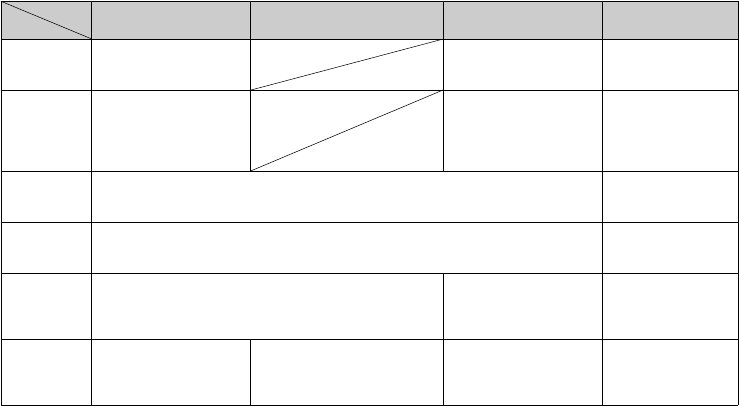
Multimedia 67
Navigating the Multimedia Menu when the Phone is Closed
You can access the Multimedia menu by pressing the side Multimedia key Y. When the phone is closed, the side
keys can be used to control the applications in the Multimedia menu as follows.
Function
Side Key
Video Player
(when playing video clip)
Streaming Player
(when playing a streaming file)
Music Player
(when playing sound file) Camera
Multimedia Y
Returns to the start of the
current file.
Long press to rewind
Returns to the start of the
current file.
Long press to rewind.
Activates focus mode.
Long press to turn the
Mobile Light on/off.
Send Z
Plays back the next video
clip file.
Long press to fast-
forward.
Plays back the next sound
file.
Long press to fast-
forward.
Displays the
Exposure menu.
Long press to switch
between the photo and
video camera modes.
Up VIncreases the volume.
(If the volume was previously muted, long press to unmute.)
Zooms in.
Long press to
continuously zoom in.
Down WDecreases the volume.
Long press to mute the sound.
Zooms out.
Long press to
continuously zoom out.
End SReturns to the previous screen.
Returns to the previous
screen.
Long press to activate
Display Saving.
Returns to previous
screen.
Long press to end the
application.
Camera X
Pauses or resumes
playback.
Long press to activate or
deactivate Keypad Lock.
Long press to activate or
deactivate Keypad Lock.
Pauses or resumes
playback.
Long press to activate or
deactivate Keypad Lock.
Takes a picture or
records a video clip.
68 Multimedia
Note
•When the Multimedia menu is active, you can end the application by tapping the back of the phone a few times (3
to 5 times).
•When the phone is held rotated 90° to the left or is held upside down:
•Press V to decrease the volume and W to increase the volume for Video and Music.
•Press V to zoom out and W to zoom in for Camera.
•When the camera is active, pressing Y:
•Activates or deactivates the focus adjustment bar when the focus mode is set to “Manual Focus”.
•Activates Focus Lock when the focus mode is set to “Auto Focus” or “Macro”.

Camera 69
Camera
Your phone has a built-in digital camera that allows you
to take pictures and record video clips wherever you
are. This section starts with basic functions and
operational procedures to take, save and send pictures
and video clips, followed by common and unique
functions to camera and video modes.
Note
•You can control the camera using the side keys when
the phone is closed. For details, see “Navigating the
Multimedia Menu when the Phone is Closed” on
page 67.
Taking Pictures
“Camera”
1. Press B to take the picture.
The shutter sounds and the still image of the taken
picture is displayed.
2. Press B to save the picture.
The taken picture is saved in Gallery.
To cancel, press U.
To send the taken picture, press C in step 2.
Note
•When the video camera is launched, press C.
•When you try to send a picture that is too large in
size, the picture size is resized for the message. The
original sized picture is saved in Gallery.
Tip
•You can activate the camera by long pressing X in
stand-by. When the phone is closed, simply press X
to take pictures, and start and stop recording.
•You can lock the focus by pressing D before taking
a picture or recording a video clip.
(M 5)
70 Camera
Recording Video Clips
You can record a video clip with your phone.
“Camera”
The preview is displayed on the screen.
When in photo camera mode, press C to switch to
video camera mode.
1. Press B.
2. To stop recording, press B.
3. Select “Save”.
The video clip is saved in Gallery.
To view the preview before saving, select
“Preview”.
To send the video clip, select “Send” and then select
“As Message”, “Bluetooth” or “Infrared”.
For “As Message”
For details, see “MMS” on page 78.
For “Bluetooth”
For details, see “Bluetooth” on page 154.
For “Infrared”
For details, see “Infrared” on page 157.
For further procedures, see “Creating a New Message”
on page 79.
Note
•You can only send video clips when “For Message”
is selected for the recording time. For details, see
“Selecting the Recording Time and Picture Size” on
page 76.
Common Functions in the Photo and
Video Camera Modes
Using the Digital Zoom Function
To Adjust the Zooming Ratio
1. Press a or b.
Once the phone has returned to stand-by, the zoom
settings return to default.
Note
•In photo camera mode, the zoom function is not
available for picture sizes 900 ×1600 and
1200 ×1600.

Camera 71
Adjusting the Exposure
“Camera”
→
[Options]
→
“Shooting Settings”
→
“Exposure”
“Camera”
→
[Options]
→
“Record Settings”
→
“Exposure”
1. Press d (Bright) or c (Dark).
: (Dark → Normal → Bright)
Once the phone has returned to stand-by, the
brightness settings return to default.
Switching the Focus Mode
“Camera”
→
[Options]
→
“Shooting Settings”
→
“Focus”
“Camera”
→
[Options]
→
“Record Settings”
→
“Focus”
1. Select the desired option.
: Auto Focus
: Manual Focus
:Macro
Selecting the Picture or Video Quality
Select the appropriate option.
“Camera”
→
[Options]
→
“Picture Quality”
“Camera”
→
[Options]
→
“Video Quality”
1. Select the desired picture or video quality.
: Super Fine
:Fine
: Normal
Note
•The better quality you select, the larger the file size
becomes.
Using the Self-Timer
Select the appropriate option.
“Camera”
→
[Options]
→
“Self-timer”
1. Select “2sec”, “5sec” or “10sec”.
When you select one of these options, the
corresponding indicator (“ ”, “ ”, or “ ”) is
displayed on the screen.
Select “Off” to cancel the self-timer.

72 Camera
Selecting the Storage Memory
Select the appropriate option.
“Camera”
→
[Options]
→
“Settings”
→
“Save New
Pictures”
“Camera”
→
[Options]
→
“Settings”
→
“Save New
Videos”
1. Select the desired location from “To Handset
Memory”, “To Memory Card” or “Choice”.
Note
•If you select “Choice”, select the desired location
every time you save.
Auto Save
You can set the phone to save pictures and video clips
automatically.
“Camera”
→
[Options]
→
“Settings”
→
“Auto Save”
1. Select “On” or “Off”.
Using the Help Function
“Camera”
→
[Options]
→
“Help”
Mobile Light
To Change the Mobile Light Mode
Set the mobile light according to your purpose.
“Camera”
→
[Options]
→
“Mobile Light”
1. Select the desired mode.
“On” ( ): The light is always on.
“Auto” ( ): The light turns on if the phone
detects that the conditions are
dark.
“Low Light” ( ) (photo camera mode only):
Select this mode for macro
shooting.
“Off ”: The light is always off.
The corresponding indicator is displayed on the
screen. Select “Off” to turn it off.
Switching between the Photo and Video
Camera Modes
You can switch between the photo and video camera
modes by pressing C.

Camera 73
Common Shortcut Keys
If multiple options exist, they switch each time you
press each of the following keys.
Note
•The “Switches the display modes” option is available
in “Preview” before you save a video clip. See
“Recording Video Clips” on page 70.
Functions in Photo Camera Mode
Selecting the Picture Size
You can select the size of pictures. All taken pictures
are saved in the JPEG format.
“Camera”
→
[Options]
→
“Picture Size”
1. Select the desired size.
1200 × 1600/900 × 1600/960 × 1280/480 × 640/
240 × 400/240 × 320/120 × 160
Photo Camera Video Camera
DFocus Lock
GFocus
HSwitches Viewfinder
between with and
without indicators
Switches the display
modes in the Preview
screen
IScan Barcode
JSave New Pictures Save New Videos
KPicture Size
LScene Microphone
MPicture Quality Video Quality
NSelf-timer
OZoom Max/Min
QHelp
RMobile Light

74 Camera
Continuous Shoot
There are various modes for taking continuous shots.
“Camera”
→
[Options]
→
“Modes”
→
“Continuous
Shoot”
1. Select the desired mode.
The following continuous shoot modes are
available:
“Off”: The continuous shoots are
cancelled.
“4 Pictures”/“9 Pictures” ( / ):
Takes 4 or 9 pictures
continuously.
After selecting this mode,
select from “Fast”,
“Normal”, “Slow” or
“Manual”.
“Overlapped” ( ): Overlaps continuous
pictures into one picture and
makes an afterimage.
After selecting this mode,
select “Fast” or “Normal”.
Note
•When you select “Manual” to take continuous
pictures, press B manually at the desired speed.
•You cannot use the Continuous Shoot function for
picture sizes larger than 480
×
640 pixels. “9
Pictures” and “Overlapped” are not available for
picture sizes larger than 240
×
400 pixels.
Taking Panorama Pictures
“Camera”
→
[Options]
→
“Modes”
→
“Panorama”
1. Select “On” and press B.
2. Move the phone slowly to keep the + mark aligned
with the assisting lines, and press B.
3. Select “Save”.
Note
•The image is captured automatically if the bar in the
lower right turns blue before B is pressed in step 2.
To Set the Assisting Lines
“Camera”
→
[Options]
→
“Settings”
→
“Panorama
Settings”
→
“Assisting Lines”
1. Select “On” or “Off”.
Note
•An error message is displayed if you move the phone
fast when taking panorama pictures with this setting
on.
Camera 75
To Set the AE-Lock
When this setting is enabled, the exposure setting is
fixed for the same brightness level.
“Camera”
→
[Options]
→
“Settings”
→
“Panorama
Settings”
→
“AE-Lock”
1. Select “Enable” or “Disable”.
Barcode/Scan
You can read barcodes in QR code format. For details,
see page 123.
“Camera”
→
[Options]
→
“Barcode/Scan”
→
“Scan
Barcode”
1. Display the barcode.
2. Press [Scan].
The scanned result is displayed.
Camera Effects
You can select from various camera effects.
“Camera”
→
[Options]
→
“Modes”
→
“Camera
Effects”
1. Select from “Sepia”, “Monochrome”, “Negative” or
“Sketch”.
Selecting a Frame
You can select the frame from preset patterns or Picture
Gallery.
“Camera”
→
[Options]
→
“Modes”
→
“Add Frame”
1. Select “Preset Frames” or “Picture Gallery”.
2. Select the desired frame.
The selected frame is confirmed on the display.
3. Press B.
Note
•Images larger than 240 pixels [W]
×
400 pixels [H]
cannot be used.
Selecting the Scene
You can select the appropriate mode by scene when you
take a picture.
“Camera”
→
[Options]
→
“Scene”
1. Select from “Auto”, “Night”, “Sports” or “Text”.

76 Camera
Using the Full Screen
You can display the preview on the full screen without
the soft key area and indicator area.
“Camera”
→
[Options]
→
“Settings”
→
“Display
Indicators”
→
“Full Viewfinder”
Note
•To return to the normal viewfinder, select “Normal
Viewfinder”.
Selecting the Shutter Sound
“Camera”
→
[Options]
→
“Settings”
→
“Shutter
Sound”
1. Select the desired shutter sound from 3 preset
patterns.
To play back the shutter sound, press [Play] in step
1.
Note
•Continuous Shoot uses the specialised shutter sound
that cannot be changed using the above settings.
•The shutter sound remains active even when
“General Volume” (p. 132) is set to “Silent” to
prevent unauthorised use.
Functions in Video Camera Mode
Selecting the Display Size
“Camera”
→
[Options]
→
“Display Size”
1. Select “Standard” or “Expand”.
Selecting the Recording Time and Picture Size
“Camera”
→
[Options]
→
“Record Time/Size”
1. Select “For Message”, “Extended Video” or “SD
VIDEO”.
“For Message” ( ): Limits the size to send a
message depending on
service providers.
“Extended Video” ( ): Less than 30 minutes
(depending on the
memory).
“SD VIDEO” ( ): Records in SD Video
format.
2. Select the desired picture size.
If “For Message” is selected, select
“QCIF(176×144)” or “SubQCIF(128×96)”.
If “Extended Video” is selected, select
“QVGA(320×240)”, “HQVGA(240×176)”,
“QCIF(176×144)” or “SubQCIF(128×96)”.
If “SD VIDEO” is selected, select
“QVGA(320×240)”.
Camera 77
Note
•If you select “For Message” for the recording time,
the file size is limited depending on the service
provider. Therefore, the quality is also limited for the
setting.
•“Send” is not displayed after recording in the
Extended Video mode.
Recording Video Clips with Sound
To record a video clip with sound, the microphone
needs to be activated.
“Camera”
→
[Options]
→
“Microphone”
1. Select “On” or “Off”.
Note
•The microphone is already turned on in the default
setting. Select “Off” to record a video clip without
the sound.
•The file size of a video clip can be reduced if the
sound is not recorded.
Video Encoding
“Camera”
→
[Options]
→
“Settings”
→
“Video
Encode”
1. Select the appropriate format.

78 Messages
Messages
Your phone allows you to send and receive text
messages, multimedia messages and Emails. It is
compatible with most POP3 Email providers.
SMS
SMS allows you to send text messages up to 70 Chinese
or 160 English characters in one SMS. If the number of
characters in an SMS exceeds this limit, the message is
split into several segments. For example, if a message
contains 100 Chinese characters, it is sent as two SMS
messages.
As a general rule, if both Chinese and English
characters are used, one Chinese character is counted as
two English characters. For punctuation symbols and
special symbols, the character count will depend on
whether it is full-width or half-width. When the symbol
is full-width, it is counted as two English characters or
one Chinese character. When the symbol is half-width,
it is counted as one English character.
Long SMS
WX-T825 supports Long SMS, which allows you to
send text messages up to 335 Chinese or 765 English
characters. If the number of characters in a message
exceeds this number, the message is automatically
delivered by MMS and the charge for an MMS is
applied.
MMS
With MMS, you can send images, sound or video to
brighten someone’s day. Messages of up to 300 KB
with images, sound, or video clips can be sent and
received.
Email
Email allows you to send messages of up to 300 KB.
Note
•Some MMS functions may not always be available
depending on your network. Contact your service
provider for more information.
•Maximum message size varies depending on the
restrictions set by the service provider.
(M 4)
Messages 79
Creating a New Message
(SMS/MMS)
“Messages”
→
“Message”
→
“Create Message”
(Email)
“Messages”
→
“Email”
→
“Create Email”
1. Select the recipient field.
2. Select the desired method to enter the recipient’s
details.
3. For MMS, enter or select the Email address or
phone number from the Phonebook. For SMS, enter
or select a phone number. For Email, enter or select
an Email address.
• To add multiple Email addresses or phone
numbers, highlight the recipient field, press
[Options], select “Edit Recipients” and select
“Add Recipient”. Enter or select the Email
address or phone number from the existing
Phonebook.
• To change the recipient mode, press [Options],
select “Edit Recipients” and highlight the desired
recipient. Press [Options] and select “Change to
To”, “Change to Cc” or “Change to Bcc”.
• To add a subject, highlight the subject field and
press B. Then enter the subject in the subject
entry screen and press B.
4. Place the cursor in the message field.
5. Press B to display the message entry screen.
Enter the message and press B.
6. Press [Options] and select “Send”.
“Send” is not available when no recipients are set.
After the message is sent, the message is moved to
the Sent box.
Note
•When you create an SMS message, the mode is
automatically switched to MMS in the following
cases:
•When an Email address is entered in the recipient
field.
•When a subject is entered.
•When the size of entered text has exceeded the SMS
size limit.
Tip
•To send the same message to a group of recipients,
select “Select Message Group” in step 2, then select
the desired group name. For details on creating a
mailing list, see “To Create a New Mailing List” on
page 55.
80 Messages
To Add a Slide Show
1. Perform steps 1 to 5 in “Creating a New Message”
on page 79.
2. Press [Options] and select “Add Slide”.
3. Select “Add Slide After” or “Add Slide Before”.
4. Enter another message.
If you wish to set the duration of each slide,
highlight your message or other inserted item such
as a picture or sound file. Press [Options] and select
“Slide Duration”, then select the desired duration.
Repeat steps 2 and 3 to add more slides.
Tip
•You can create messages up to 300 KB. Each slide
can contain one picture and/or one sound file or
video clip.
To Attach Data
1. In step 6 in “Creating a New Message” on page 79,
press [Options] and select “Insert Item”.
2. Select “Picture”, “Sound”, “Video”, “Attach
Contact”, “Attach Appointment”, “Others” or
“Flash®”.
When selecting “Attach Contact” or “Attach
Appointment”, go to step 4.
3. Select the desired option and then select the desired
file.
If you wish to attach pictures, sounds or video clips
that are saved, select “Saved Pictures”, “Saved
Sound” or “Saved Video”.
If you wish to take new pictures, record sounds or
video clips, select “Take Picture”, “Record Voice”
or “Record Video”.
4. Select the desired data.
If you wish to select your own Phonebook entry,
select “My Card”.
When attaching an appointment, select the desired
day including a schedule entry you wish to add and
select the desired schedule entry.
Note
•When attaching JPEG files, select the appropriate
resize option, as the maximum message size for
sending varies depending on the service provider.

Messages 81
To Remove Attachments
1. In step 6 in “Creating a New Message” on page 79,
highlight the desired item, press [Options] and then
select “Remove Picture”, “Remove Sound”,
“Remove Video” or “Remove Item”.
Using the Sending Options
You can use the message sending options for each type
of message.
1. Press [Options] and select “Messaging Settings”.
• “Delivery Report” (“On”, “Off”) (SMS/MMS):
Enables or disables Delivery Report when the
message is successfully sent to the recipient.
• “Expiry Time” (“Maximum”, “1 hour”, “12
hours”, “1 day”, “1 week”) (SMS/MMS): Sets
Expiry Time for a message to be saved in the
server.
• “Priority” (“High”, “Normal”, “Low”) (MMS/
Email): Prioritises composed messages.
• “Read Report” (“On”, “Off”) (MMS): Confirms
whether or not a report is sent notifying the
sender that the message has been read.
2. Press [Options] and select “Send”.
After the message is sent, the message is moved to
the Sent box.
Note
•The current message size displayed while you are
creating the message is an approximation.
•If a message cannot be sent for some reason, the
message stays in the Outbox and the “ ” is
displayed in stand-by.
•To send the message in the Outbox, highlight the
message, press [Options] and select “Resend”.
Tip
•To save the message without sending, press
[Options] and select “Save to Drafts” in step 6 in
“Creating a New Message” on page 79.
•You can send the following items attached to
multimedia messages. Details are given in the
following sections.
•Gallery data
•Phonebook entry
•Schedule entry created by Calendar, etc.
•You can use the template option to help you compose
messages. For details on using this option, see
“Using Templates” on page 50.
82 Messages
Sending a Message in the Drafts Box
(SMS/MMS)
“Messages”
→
“Message”
→
“Drafts”
(Email)
“Messages”
→
“Email”
→
“Drafts”
1. Highlight the desired message.
2. Press [Options] and select “Edit & Send”.
3. Modify the message, if necessary.
4. Press [Options] and select “Send”.
“Send” is not available when no recipients are set.
Reading a Message
Messages you receive are saved in the Inbox.
(SMS/MMS)
“Messages”
→
“Message”
→
“Inbox”
(Email)
“Messages”
→
“Email”
→
“Inbox”
1. Select a folder.
2. Select the message you wish to view.
Note
•When the motion control setting for “Messaging” is
set to “On” (p. 138), you can change the size of the
text by tilting the phone forward or backward. This is
only available when the phone is closed.
Storing the Phone Number of a Sender in the
Phonebook
(SMS/MMS)
“Messages”
→
“Message”
→
“Inbox”
(Email)
“Messages”
→
“Email”
→
“Inbox”
1. Select a folder.
2. Highlight the message from which you wish to store
the phone number or Email address.
3. Press [Options] and select “Save Address”.
The new Phonebook entry screen including the
phone number is displayed. For details on creating
a new Phonebook entry, see “Adding a New
Phonebook Entry” on page 52.

Messages 83
Calling the Phone Number of a Sender
Embedded in the Message
(SMS/MMS)
“Messages”
→
“Message”
→
“Inbox”
1. Select a folder.
2. Highlight the message containing the phone number
you wish to dial.
3. Press [Options] and select “Call Sender”.
Downloading a Single MMS
“Messages”
→
“Message”
→
“Inbox”
1. Select a folder.
2. Highlight the message alert ( ) you wish to
download.
3. Press [Options] and select “Download”.
Replying to a Message or to All Addresses
(SMS/MMS)
“Messages”
→
“Message”
→
“Inbox”
(Email)
“Messages”
→
“Email”
→
“Inbox”
1. Select a folder.
2. Highlight the message you wish to reply to.
3. Press [Options] and select “Reply” (to sender only)
or “Reply All” (to all other recipients listed in the
original To or Cc lists).
4. Select “Reply” or “Reply with History”.
5. Enter the message.
6. Press [Options] and select “Send”.
“Send” is not available when no recipients are set.
84 Messages
Forwarding a Message
(SMS/MMS)
“Messages”
→
“Message”
→
“Inbox”
(Email)
“Messages”
→
“Email”
→
“Inbox”
1. Select a folder.
2. Highlight the message you wish to forward.
3. Press [Options] and select “Forward”.
4. Perform steps 1 to 6 in “Creating a New Message”
on page 79.
Sorting the Messages in the List
(SMS/MMS)
“Messages”
→
“Message”
→
“Inbox”
(Email)
“Messages”
→
“Email”
→
“Inbox”
1. Select a folder.
2. Press [Options] and select “View Settings”.
3. Select “Sort”.
4. Select the desired sort option.
Cell Broadcasts
You can receive cell broadcast messages or general
messages such as weather forecasts and traffic reports.
This information is broadcast to subscribers in certain
network areas.
This function may not be available on all mobile phone
networks. Contact your service provider for more
information.
Enabling/Disabling Cell Broadcasts
“Messages”
→
“Cell Broadcasts”
→
“Switch On/
Off”
1. Select “On” or “Off”.
Reading Cell Broadcast Messages
“Messages”
→
“Cell Broadcasts”
→
“Read
Messages”
1. Select the desired subject.
2. Scroll the screen to read the message.
3. Press U.
(M 4-4)
Messages 85
Setting Languages for Cell Broadcast
Messages
“Messages”
→
“Cell Broadcasts”
→
“Settings”
→
“Language”
1. Highlight the desired language and press B to
check.
2. Press [Save].
Subscribing to Cell Broadcasts
Select the page of the cell broadcast message that you
want.
“Messages”
→
“Cell Broadcasts”
→
“Settings”
→
“Set Info Subjects”
1. Select “Add/Remove”.
2. Highlight the desired subject and press B to check.
3. Press [Save].
Tip
•If the desired subject is not in the list that appears in
step 2, select “Create Subject” in step 1, then enter
the subject code to add a page. For details on the
subject code, contact your service provider.
Area Info
The Area Info is the message information that operators
send to subscribers in certain areas.
When you receive Area Info, the message (area code) is
displayed in stand-by.
Enabling/Disabling Area Info
“Messages”
→
“Area Info”
1. Select “On” or “Off”.
Note
•This function may not be available on all mobile
phone networks. Contact your service provider for
more information.
•If Area Info is set to “On”, the stand-by time will
decrease.
(M 4-5)
86 Messages
Messaging Settings
General Settings
“Messages”
→
“Messaging Settings”
→
“General Settings”
1. Select the item you wish to set up.
• “Signature”:
Enables or disables “Auto Insert”. Select “Edit”
to edit current signature.
• “Auto Delete”:
Sets whether to delete the oldest message
automatically when the Inbox, Sent or Both
(Inbox and Sent) is full.
• “Message List View”:
Switches the mailbox listing.
• “Inbox Display Settings”:
Switches the Inbox listing.
• “Sent Box Display Settings”:
Switches the Sent box listing.
• “Scroll Unit”:
Scroll through messages by “Single Line”, “Half
Page” or “Whole Page”.
• “Message Type”:
Sets the type of message that can be created to
either SMS or MMS. When set to “Free”, the
message is sent automatically either as an SMS or
MMS as appropriate.
When set to “SMS”, the functions for MMS are
not available.
SMS Settings
“Messages”
→
“Messaging Settings”
→
“SMS Settings”
1. Select the item you wish to set up.
• “Delivery Report”:
Enables or disables Delivery Report request.
• “Automatic Resend”:
Tries to resend the failed SMS message up to two
times (“On” or “Off” selection).
• “Expiry Time”:
This indicates the number of days and hours for
which a message you send may remain
undelivered to the message recipient. During this
period, the message service centre will
continually try to deliver the message to the
recipient.
(M 4-6)
Messages 87
• “Message Centre”:
Enter the message centre number. Up to 2
numbers can be registered.
If you wish to enter a country code for a message
to an international number, long press Q until
a + sign is displayed.
•“Reply Path”:
Enables or disables adding a reply path to the
message.
• “Connection Type”:
Sets the preferred connection type (“GPRS
Preferred”, “CSD Preferred”).
MMS Settings
“Messages”
→
“Messaging Settings”
→
“MMS Settings”
1. Select the item you wish to set up.
• “MMS Accounts”:
Select the desired account or select “Create New”
to enter the following settings.
“Profile Name”: MMS profile name
(unique name)
“Proxy”: Proxy setting for MMS
“Relay Server URL”: MMS relay server
• “Home Download”:
Controls the message download timing inside
your network area.
“Always Download”: Downloads messages
immediately from the
server.
“Always Defer”: Defers message download.
• “Roaming Download”:
Controls the message download timing when
roaming outside of your network.
“Always Download”: Downloads messages
immediately from the
server.
“Always Defer”: Defers message download.
• “Delivery Report”:
Enables or disables Delivery Report request.
• “Automatic Resend”:
Tries to resend the failed MMS message up to
two times (“On” or “Off” selection).
• “Delivery Report Allow”:
Confirms whether or not a report is sent notifying
the sender when you receive a message.
•“Read Report”:
Enables or disables Read Report request.
88 Messages
• “Read Report Allow”:
Enables or disables Read Report Allow when the
recipient is required to inform the sender that the
message has been read.
• “Expiry Time”:
This indicates the number of days and hours for
which a message you send may remain
undelivered to the message recipient. During this
period, the message service centre will
continually try to deliver the message to the
recipient.
• “Slide Duration”:
Sets the duration of the slide.
• “Slide Auto Play”:
Enables or disables Slide Auto Play.
• “Send File Settings”:
Sets whether or not to send and save the file
settings.
• “Max Message Size”:
Sets the maximum message size for sending and
disables sending MMS messages exceeding that
size.
• “Creation Mode”:
When set to “Free”, you can attach files of any
format to the mail. When set to “Restricted”, only
files in certain formats and size can be attached.
The “Restricted” setting has priority over “Max
Message Size”.
• “Hide Number”:
Sets whether to show or hide the sender’s
address.
• “Delivery Time” (“Immediate”, “1 hour”, “12
hours”, “1 day”, “1 week”):
Sets the time the message is delivered after
[Options] is pressed and “Send” is selected.
• “Anonymous Rejection”:
Enables or disables the rejection of messages
from anonymous senders.
To Activate the MMS Account Profile
1. Select “MMS Accounts”.
2. Select the desired profile you wish to activate.
Messages 89
Email Settings
“Messages”
→
“Messaging Settings”
→
“Email Settings”
To Set an Email Account
1.
Select “Email Accounts” and then select “Create New”.
2. Select the item you wish to set up.
“Account Name”: Email account name (unique
name)
“Incoming Server”: Server Name, User ID,
Password, Port Number,
APOP Authentication and
Encryption for the incoming
server
“Outgoing Server”: Server Name, User ID,
Password, Port Number,
SMTP Authentication and
Encryption for the outgoing
server
“Access Point”: Access point for Email
“Email Address”: Email address
“Advanced Settings”: Your name, signature,
download interval,
download configuration,
Max Download Limit, save
sent messages
To Activate the Email Account Profile
1. Select “Email Accounts”.
2. Select the desired profile you wish to activate.
Speed Mail
The Speed Mail function allows you to initiate
messaging from the stand-by screen faster, with fewer
keys to press.
The digit keys (H to O) can be used for speed mail.
A total of 8 data items can be assigned to these keys.
For details, see page 59.
1. Press a digit key in stand-by.
2. Press A to display the message screen.
The Email address assigned to the digit key pressed
in step 1 is automatically entered in the recipient
field.
To add a subject, highlight the subject field and
press B. Then enter the subject in the subject entry
screen and press B.
3. Perform steps 4 to 6 in “Creating a New Message”
on page 79.

90 FET Mobile Internet
FET Mobile Internet
Your phone is already configured to access FET Mobile
Internet.
FET Mobile Internet is a new mobile Internet portal
which is your gateway to a new world of information,
games, music and services.
Because your phone uses 3G (UMTS), it has a system
that is faster than previous ways of getting mobile
information. Also, the connection is ‘always on’ which
means there is no need to wait for dialling up. You only
have to pay for the data you send or receive, not how
long you’re connected.
Your phone contains a WAP/Web browser used for
surfing on the mobile Internet, where you can get a lot
of useful information. Normally, pages are designed for
a mobile phone.
Your phone is already set up to FET Mobile Internet
site for Browser/MMS Settings.
Main Menu
“FET Mobile Internet”
→
“Homepage”
The FET Mobile Internet service page is displayed.
“FET Mobile Internet”
→
“Go to URL”
The URL entry screen is displayed. You can type in the
URL of a site directly.
“FET Mobile Internet”
→
“Bookmarks”
See page 91.
“FET Mobile Internet”
→
“Alert Inbox”
WAP Push alerts are displayed.
“FET Mobile Internet”
→
“My Saved Page”
You can view all the screenshots that have been saved
onto the handset memory.
“FET Mobile Internet”
→
“Access History”
The history of pages you have recently browsed is
displayed.
“FET Mobile Internet”
→
“Browser Settings”
See page 92.
(M 2)
FET Mobile Internet 91
Navigating a WAP or Web Page
•a b c d:
Moves the cursor in the screen.
•A: Launches the option menu if it has not
been launched.
Used to select an option from the option
menu.
•B:
Executes the highlighted item in the screen.
•C: Launches “FET Mobile Internet” by
opening the browser when in stand-by.
Moves to previous page when the browser
is active.
•F(short press):
Exits the browser.
(long press):
Turns off the phone.
Note
•When the motion control setting for “Browser” is set
to “On” (p. 138), you can zoom in or zoom out by
tilting the phone forward or backward. This is only
available when the phone is closed.
•When the phone is closed, use the side keys to
navigate the WAP/Web page.
Editing Bookmarks
“FET Mobile Internet”
→
“Bookmarks”
1. Select the desired URL, and press [Options].
You can edit the list of Bookmarks by the following
options:
(When a bookmark is focused)
“Edit”: Edits the URL address of the
bookmark.
“Add New Bookmark”:
Creates new bookmarks.
“Create Folder”: Creates new folders.
“Open in New Tab”: Opens a bookmark in a new
tab. (This option is available
only when the options menu
is opened from the browser
screen.)
“Send”: Sends the URL address to
recipients.
“Move”: Moves bookmarks to
another location or into a
folder.
“Details”: Displays detailed
information of the WAP/
Web page.
“Delete”: Deletes a bookmark.
“Delete All”: Deletes all bookmarks.
(M 2-3)
92 FET Mobile Internet
(When a folder is focused)
“Add New Bookmark”:
Creates new bookmarks.
“Create Folder”: Creates new folders.
“Move”: Moves folder and
bookmarks in the folder to
another location.
“Rename Folder”: Renames the folder.
“Delete”: Deletes the folder and
bookmarks in the folder.
“Delete All”: Deletes all folders and
bookmarks.
(When there are no bookmarks)
“Add New Bookmark”:
Creates new bookmarks.
“Create Folder”: Creates new folders.
Browser Settings
“FET Mobile Internet”
→
“Browser Settings”
“Font Size”: Sets the font size for
browsing.
“Scroll Settings”: Sets the scroll units and
turns page navigation on/
off.
“Cursor Settings”: Sets whether or not to show
the cursor, and its speed.
“Downloads”: Sets whether or not to show
images or play back sound
when accessing a WAP/
Web page.
“Memory Operation”: Clears Cache, Cookies, or
Authentication information.
“Security Settings”: Adjusts the security prompt
level.
“Download to”: Sets the preferred download
location.
“Zoom Factor”: Sets the zoom ratio for
viewing a page.
“Zoom Area”: Sets the window size for
displaying enlarged specific
area.
“WAP Push”: Sets whether you need
confirmation for Push
messages.
“Initialize Browser”: Initializes the browser
settings and memory.
“Reset Settings”: Resets all the browser
settings to the default
settings.
(M 2-7)
FET Mobile Internet 93
Browser Options when Online
You can use the various options of the browser.
A
→
[Options]
“Home”: Goes to the homepage.
“Alert Inbox”: Displays WAP Push alerts.
“Forward”: Goes to the next page.
“Open This Frame”: Opens the selected frame.
(This option is available
only when a frame page is
displayed.)
“Bookmarks”: Displays the Bookmarks
menu. See page 91.
“My Saved Page”: Displays all the browser
screenshots saved in the
handset memory.
“Copy Text”: Copies the text on the WAP/
Web page.
“Reload Page”: Reloads the WAP/Web page
to get updated information.
“Go to URL”: Allows you to type in the
URL of a site directly.
Handset browser will go to
the WAP/Web page that you
entered.
“Save Items”: Saves items from the
browsing pages.
“Fit to Screen Width”/“Actual Page Width”:
Allows the browser to display
in complete page mode or
Virtual Screen mode.
“Convenient Functions”
:Displays functions for page
operation.
“Access History”: Shows previously browsed
pages.
“Flash®Menu”: Displays Flash® menu.
(This option is available
only when a Flash® file is
displayed.)
“SVG Menu”:
Displays SVG menu. (This
option is available only when
a SVG file is displayed.)
“Open in New Tab”: Opens a new window. (This
option is available only
when one window is opened
and a URL is highlighted.)
“Tab Menu”: Displays the tab menu. (This
option is available only
when two or more windows
are opened.)
“Settings”: Displays the settings menu.
“Help”: Displays the browser help
screen.
“Exit”: Exits the browser.

94 Gallery
Gallery
Gallery contains all your pictures, music and videos.
You can also transmit pictures, sounds and video clips
via infrared or Bluetooth wireless technology to other
OBEX-enabled devices.
Picture Gallery
Pictures that are taken by your phone’s camera or
images that are downloaded from mobile Internet sites
can be viewed, edited and organised.
Viewing Pictures
“Gallery”
→
“Picture Gallery”
1. Select the file you wish to view.
The selected picture is displayed.
Note
•To switch between viewing handset or memory card
content, select the first item in the options menu.
•When the motion control action setting for “Image
Viewer” is set to “On” (p. 138), you can change the
picture being displayed by shaking the phone
sideways. This is only available when the phone is
closed.
Tip
•You can scroll through your pictures with P and
R.
•To change the default view of pictures (Inline
Display, Grid View or Display Preview), press
[Options], select “Manage Items” and then select
“Change List View”.
Using Images as Wallpaper
“Gallery”
→
“Picture Gallery”
1. Highlight the file you wish to use as wallpaper.
2. Press [Options] and select “Set as Wallpaper”.
Editing Pictures
“Gallery”
→
“Picture Gallery”
1. Highlight the file you wish to edit.
2. Press [Options] and select “Edit”.
3. Select “Picture Editor” or “Composite”.
4. Select the desired option.
Note
•“Picture Editor” may not be available depending on
the original picture and copyright issued.
(M 6)
(M 6-1)
Gallery 95
Saving an Image to Phonebook Entries
You can use this option only for pictures saved in the
handset memory.
“Gallery”
→
“Picture Gallery”
1. Highlight the file you wish to add to Phonebook.
2. Press [Options] and select “Add to Contacts”.
To save as a new entry, select “As New”.
To overwrite, select “As New Detail” and then
select the data you wish to save.
For details on entering a name, see “Adding a New
Phonebook Entry” on page 52.
Downloading Picture Files
“Gallery”
→
“Picture Gallery”
→
“Download More”
The picture file download site is displayed.
Video Gallery
Video clips that are recorded by your phone’s video
camera or video clips that are downloaded from mobile
Internet sites can be viewed and organised.
Playing Back Video Clip Files
“Gallery”
→
“Video Gallery”
1. Select the file you wish to play back.
To pause playback, press B.
To resume, press B again.
To stop playback, press U.
Note
•To switch between viewing handset or memory card
content, select the first item in the options menu.
Using a Video Clip as a Ring Video Clip
You can set your video clip to play back when the
phone rings.
“Gallery”
→
“Video Gallery”
1. Highlight the desired video clip.
2. Press [Options] and select “Set as Ring Video”.
Tip
•For other option menus, see “Common Option
Menus” on page 99.
(M 6-2)
96 Gallery
Downloading Video Clip Files
“Gallery”
→
“Video Gallery”
→
“Download More”
The video clip file download site is displayed.
SD VIDEO
Video clips with the “ASF” format that are recorded by
a video camera can also be managed with SD VIDEO.
“Gallery”
→
“SD VIDEO”
1. Select the desired file.
To pause playback, press B.
To resume, press B again.
To delete a file, highlight the file, press [Options]
and select “Delete”.
Note
•By default, video clips are recorded in 3GP format.
To enable SD VIDEO recording, change the setting
in the Video Camera as shown below.
[Options]
→
“Record Time/Size”
→
“SD VIDEO”
Sound Gallery
The downloaded sound files and the AMR data
recorded by Voice Recorder are managed in Sound
Gallery. The default ringtones are not contained within
Sound Gallery. Only the sound files that can be played
back on the phone are stored in Sound Gallery.
Playing Back Sound Files
“Gallery”
→
“Sound Gallery”
1. Select the file you wish to play back.
To stop playback, press U.
Note
•Playback may not be available for some sound files.
A2DP function is available only when playing back
from music player and is not available when playing
back from Gallery.
•To switch between viewing handset or memory card
content, select the first item in the options menu.
(M 6-3)
(M 6-4)
Gallery 97
Using the Sound Files as a Ringtone
“Gallery”
→
“Sound Gallery”
1. Highlight the file you wish to use as a ringtone.
2. Press [Options] and select “Set as ringtone”.
Tip
•For other option menus, see “Common Option
Menus” on page 99.
Downloading Sound Files
“Gallery”
→
“Sound Gallery”
→
“Download More”
The sound file download site is displayed.
Themes
You can easily customise the display by using the
theme files.
Note
•Preset themes are not included in “Themes” in
“Gallery”.
Viewing Previews
“Gallery”
→
“Themes”
1. Highlight the theme file you wish to preview.
2. Press B.
The selected theme file is displayed.
Note
•To switch between viewing handset or memory card
content, select the first item in the options menu.
Setting a Theme
“Gallery”
→
“Themes”
1. Select the desired theme file.
The selected theme file is set as the default theme.
Tip
•Even after a theme is set, you can set a wallpaper
regardless of the set theme. In this case, the other
items follow the set theme.
•For other option menus, see “Common Option
Menus” on page 99.
Downloading Theme Files
“Gallery”
→
“Themes”
→
“Download More”
The theme file download site is displayed.
(M 6-5)
98 Gallery
Flash®
Playing Back Flash® Files
“Gallery”
→
“Flash®”
1. Select the file you wish to play back.
To stop playback, press U.
Note
•Flash® files of up to 150 KB can be played back.
Using Images as Wallpaper
“Gallery”
→
“Flash®”
1. Highlight the file you wish to use as wallpaper.
2. Press [Options] and select “Set as Wallpaper”.
Using the Sound Files as a Ringtone
“Gallery”
→
“Flash®”
1. Highlight the file you wish to use as a ringtone.
2. Press [Options] and select “Set as ringtone”.
Other Documents
Some types of files are stored in the Other Documents
folder of the phone. You can edit and use these files as
Gallery data.
Opening a Document File
“Gallery”
→
“Other Documents”
1. Select the desired file.
Note
•To switch between viewing handset or memory card
content, select the first item in the options menu.
Tip
•For other option menus, see “Common Option
Menus” on page 99.
(M 6-7) (M 6-8)

Gallery 99
Common Option Menus
For using the desired file type, first select the
appropriate folder in the Gallery menu. Gallery
contains the following folders.
“Gallery”
→
“Picture Gallery”
“Gallery”
→
“Video Gallery”
“Gallery”
→
“SD VIDEO”
“Gallery”
→
“Sound Gallery”
“Gallery”
→
“Themes”
“Gallery”
→
“Java™ Gallery”
“Gallery”
→
“Flash®”
“Gallery”
→
“Other Documents”
Activating Files with Copyright Protection
(DRM)
Some pictures, sound files, video clips, Flash® files and
theme files have a digital copy protection program,
which is called DRM (Digital Rights Management).
You need to activate the digital licence permission to
open the files. Files protected with DRM are displayed
with .
1. Select the appropriate folder for the desired file
type.
2. Highlight the file you wish to activate.
3. Press [Options] and select “Get Contents Key”.
Note
•Some pictures with DRM may not be opened even
when an attempt is made to activate it.
Sending Gallery Data
For details on Infrared and Bluetooth wireless
technology, see “Connectivity” on page 154.
1. Select the appropriate folder for the desired file
type.
2. Highlight the desired file.
3. Press [Options] and select “Send”.
4. Select “As Message”, “As Email”, “Bluetooth”,
“Infrared” or “Send via IrSS”.
For “As Message”
For details, see “MMS” on page 78.
For “As Email”
For details, see “Email” on page 78.
For “Bluetooth”
For details, see “Bluetooth” on page 154.
For “Infrared”
For details, see “Infrared” on page 157.
100 Gallery
Note
•Pictures/Sounds/Video clips/Themes/Flash® files/
Other Documents data protected by copyright cannot
be sent attached to a message, with the exception of
Separate Delivery files.
•When pairing, you need to enter your passcode when
establishing contact with a Bluetooth wireless
technology enabled device for the first time.
Receiving Gallery Data
When the phone receives Gallery data, a confirmation
message is displayed in stand-by.
1. Select “Yes”.
The received data is saved in the corresponding
Gallery folder.
Tip
•For details on Infrared or Bluetooth wireless
settings, see “Connectivity” on page 154.
Using Gallery Data
You can copy, move, sort, rename, and delete the saved
Gallery data.
1. Select the appropriate folder for the desired file type
(p. 99).
2. Highlight the desired file.
3. Press [Options] and select “Manage Items”.
4. Select the desired option.
“Sort”: Sorts files according to a specific
sequence.
“Rename”: Renames the file or folder.
“Create Folder”: Creates a new folder.
“Change List View”:
Changes the list view.
“Check All”: Selects all files in the list.
“Delete All”: Deletes all files in the folder.
Note
•“Manage Items” is not available for “Java™
Gallery”.
To Delete the File
1. Select the appropriate folder for the desired file type
(p. 99).
2. Highlight the desired file.
3. Press [Options] and select “Delete”.
Gallery 101
To See the Gallery Details
1. Select the appropriate folder for the desired file type
(p. 99).
2. Highlight the file you wish to view the details of.
3. Press [Options] and select “Details”.
Selecting Multiple Files
You can select more than one item from Gallery for
moving, copying, managing and deleting.
Note
•The following procedure applies when entries other
than “Download More” are highlighted.
1. Select the appropriate folder for the desired file type
(p. 99).
2. Highlight the file you wish to select.
3. Press [Options] and select “Check”.
4. Repeat steps 2 and 3 until you select all the desired
files.
Tip
•To remove the check, highlight the file again and
select “Uncheck” in step 3.
•If you wish to unselect all, select “Manage Items” in
step 3 and select “Uncheck All”.
•You can quickly check, uncheck, check all or uncheck
all items by using the H, J and L keys.
H: Check/uncheck currently highlighted item.
J: Checks all items in the current folder.
L: Unchecks all checked items in the current
folder.
Memory Status
This function helps you to check the memory status of
the handset memory or memory card. Memory status
covers the following:
Handset Memory: Pictures, Videos, Sound Gallery,
Themes, Java™ Gallery, Flash®,
Other Documents, Others, Total
and Free
Memory Card: Pictures, Videos, Sound Gallery,
Themes, Flash®, Other
Documents, Others, Total and
Free
“Gallery”
→
“Memory Status”
1. Select “Handset Memory” or “Memory Card”.
(M 6-9)

102 Java™
Java™
Java™ Gallery
The list of Java™ applications is displayed.
Downloaded applications are displayed in order
starting from the latest one.
Downloading Applications
“Java™”
→
“Java™ Gallery”
→
“Download More”
1. Select the desired application.
Before downloading the application you are asked
to confirm what you are about to receive. After
checking the information on the confirmation
screen, the application can be downloaded.
2. Press B to start downloading.
3. Press B when finished.
Note
•User authentication may be required before
downloading the application on some information
screens.
Executing Applications
“Java™”
→
“Java™ Gallery”
1. Select the title of the application you wish to
execute.
The selected application is executed. When using
network connection type applications, connection
to the network can be selected.
2. To end the application, press F and select “End”.
Setting as a Screensaver for the Display
“Java™”
→
“Java™ Gallery”
1. Highlight the file you wish to use as a screensaver.
2. Press [Options] and select “Set as Screensaver”.
(M 1)
(M 1-1)
Java™ 103
Setting Permission
You can set permission for selected Java™
applications.
“Java™”
→
“Java™ Gallery”
1. Highlight the desired Java™ application.
2. Press [Options] and select “Permission”.
3. Select one of the following options:
“Phone Call”: Sets permission to make voice
calls.
“Network Access”: Sets permission to access the
network.
“Messaging”: Sets permission to perform
SMS messaging.
“Autorun”: Sets permission to perform the
Autorun function.
“Bluetooth Conn.”: Sets permission to connect via
Bluetooth.
“Read User Data”: Sets permission to read user
data, such as Phonebook
entries, mailbox (Inbox) and
Gallery data.
“Write User Data”: Sets permission to write
entries in your phone, such as
Phonebook entries, mailbox
(Inbox) and Gallery data.
“Use Multimedia”: Sets permission to use the
multimedia recording.
4. Select one of the following options:
“Always Ask”: The confirmation message is
displayed every time network
access is executed.
“Ask Once”: The confirmation message is
displayed the first time
network access is executed.
“Never Ask”: The confirmation message is
not displayed while execution
of network access is
authorised.
“No”: Execution of network access
is not authorised.
Note
•Options displayed in step 4 depend on the item
selected in step 3.
•To clear all the permission settings, select “Reset” in
step 3.
•Some permissions are not available for some Java™
applications.
•“Bluetooth Conn.”, “Read User Data” and “Write
User Data” may not be available in step 3.
104 Java™
Viewing Application Information
You can check the information of Java™ applications.
“Java™”
→
“Java™ Gallery”
1. Highlight the desired Java™ application.
2. Press [Options] and select “Information”.
Deleting an Application
You can delete an application in the folder.
“Java™”
→
“Java™ Gallery”
1. Highlight the desired Java™ application.
2. Press [Options] and select “Delete”.
Java™ Settings
Application Volume
You can set the volume of the application such as the
sound effect to one of the five levels or silent. When the
profile is set to “Silent”, the “General Volume” setting
(p. 132) has priority.
“Java™”
→
“Java™ Settings”
→
“Application
Volume”
1. Press a (or d) to increase the volume or press b
(or c) to decrease the volume and then press B.
Backlight
“Java™”
→
“Java™ Settings”
→
“Backlight”
→
“Switch On/Off”
1. Select from “Always On”, “Always Off” or
“Normal Settings”.
“Always On”: Lit while the application is
operated.
“Always Off”: Unlit while the application is
operated even if a key is
pressed.
“Normal Settings”: Works with the main
backlight setting (p. 129).
(M 1-2)
(M 1-2-1)

Java™ 105
To Set the Blinking Operation
This setting enables the backlight to be controlled by
the application. If set to “Off”, the backlight cannot be
turned on from the application.
“Java™”
→
“Java™ Settings”
→
“Backlight”
→
“Blink”
1. Select “On” or “Off”.
Vibration
When the vibrator is set in the application, you can
choose whether the operation is enabled or disabled.
“Java™”
→
“Java™ Settings”
→
“Vibration”
1. Select “On” or “Off”.
Calls & Alarms
The priority of incoming calls, alarms and Bluetooth
connection while an application is operating can be set.
“Java™”
→
“Java™ Settings”
→
“Calls & Alarms”
1. Select “Voice Call”, “Video Calling”, “Incoming
Message”, “Alarm” or “Push Request”.
2. Select the desired method.
• “Call Priority”, “Message Priority”, “Alarm
Priority” or “Request Priority”:
The application is suspended automatically, and
you can receive a call or a message, the alarm
will sound or Bluetooth connection will start.
After finishing the call or receiving the message,
or when the alarm or Bluetooth connection ends,
the suspend indicator ( ) is displayed letting
you know there is a suspended application.
• “Call Notice”, “Message Notice”, “Alarm
Notice” or “Request Notice”:
The marquee (character scrolls) is displayed on
the first line of the screen while the application
continues. If you press D, the application is
suspended, and you can receive the call. After
finishing the call or receiving the message, the
suspend indicator ( ) is displayed letting you
know there is a suspended application.
(M 1-2-3)
(M 1-2-4)
106 Java™
Screensavers
You can download screensaver applications for the
stand-by screen and set the time period for the
screensaver to activate.
“Java™”
→
“Java™ Settings”
→
“Set Java™
Wallpaper”
→
“Switch On/Off”
1. Select “On” or “Off”.
To Set the Activation Time
“Java™”
→
“Java™ Settings”
→
“Set Java™
Wallpaper”
→
“Activation Time”
1. Enter an activation time from 1 to 10 seconds (in 2
digits) using the keypad.
To Set the Suspend Time
“Java™”
→
“Java™ Settings”
→
“Set Java™
Wallpaper”
→
“Suspend Time”
1. Set the desired time period from “after 15 min.” to
“after 6 hours”.
Surround
1. You can set surround sound for Java™ applications.
“Java™”
→
“Java™ Settings”
→
“Surround”
1. Select “On” or “Off”.
Default Settings
“Java™”
→
“Java™ Settings”
→
“Set to Default”
1. Enter your handset code.
The default handset code is “9999”. For details on
changing the handset code, see “Changing the
Handset Code” on page 140.
Clearing All Memory
“Java™”
→
“Java™ Settings”
→
“Memory All
Clear”
1. Enter your handset code.
The default handset code is “9999”. For details on
changing the handset code, see “Changing the
Handset Code” on page 140.
Java™ Information
“Java™”
→
“Java™ Information”
The information about the licences belonging to Java™
is displayed.
(M 1-2-6)
(M 1-2-7)
(M 1-2-8)
(M 1-3)

Organiser 107
Organiser
Calendar
The calendar allows you to easily schedule
appointments.
These entries can also be sent via Bluetooth wireless
technology to a PC to share the same schedules. When
you exchange entries with other devices, the date and
time displayed may be different to that of the original
data depending on the data format of the receiving
device.
Creating a New Entry
“Organiser”
→
“Tools 1” tab
→
“Calendar”
1. Select the desired day to which you want to add an
event.
2. Select “Add New Entry”.
3. Enter the subject.
4. Enter the start date and time.
5. Select the desired category.
6. Select the reminder time.
When selecting “Other”, enter the desired reminder
date and time.
7. Press [Save].
Note
•If the date and time settings have not been entered,
the date and time entry screen is displayed (p. 136).
•The reminder will not sound when the profile is set to
“Silent”, but will sound when “General Volume”
(p. 132) is set to “Silent”.
•
You can display the Stamp screen by pressing
H
in
the monthly calendar view. Select the desired category.
To Change the Settings
1. Select the item you wish to change in the New Entry
screen.
• “Reminder”: Sets options including
“Reminder Time”, “Assign
Tone/Video” and “Duration” for
the reminder.
• “Repeat”: Sets the number of times the
reminder sounds.
•
“Location”:
Sets the location for the schedule
entry.
• “Description”: Enables entering a memo for the
schedule entry.
• “Secret”: Sets to show or hide the schedule
entry. Set to “On” to make the
data secret or select “Off” to
leave it as it is.
(M 3)
(M 3-1)
108 Organiser
Viewing a Schedule Entry
“Organiser”
→
“Tools 1” tab
→
“Calendar”
1. Select the day you wish to view.
2. Select the desired entry.
To Search by Date
1. In any view, press [Options] and select “Go to”.
2. Select “Today” to display today or “Enter Date” to
enter the desired date.
Tip
•You can control the view by using the following:
Monthly or 2-month view
P: Displays the previous month.
R: Displays the next month.
Q: Displays the Help screen.
H: Displays the Stamp screen (monthly view
only).
J: Displays the Set Colour screen.
K: Moves the cursor to today.
L: Displays the Find (By Subject) screen.
N: Displays the Go to (Enter Date) screen.
O: Displays the Find (By Category) screen.
c/d: Moves the cursor to left (the previous day)
or to right (the next day).
a/b: Moves the cursor upward (last week) or
downward (next week).
Weekly view
P: Displays the previous week.
R: Displays the next week.
Q: Displays the Help screen.
J: Displays the Set Colour screen.
K: Moves the cursor to today.
L: Displays the Find (By Subject) screen.
N: Displays the Go to (Enter Date) screen.
O: Displays the Find (By Category) screen.
c/d: Moves the cursor to left (the previous day)
or to right (the next day).
a/b: Moves the weekly view up or down (the
previous hour or next hour).
Organiser 109
Setting a Colour
You can highlight a date or days of the week with seven
colour options.
For Date Colour
“Organiser”
→
“Tools 1” tab
→
“Calendar”
1. Press [Options] and select “Calendar Settings”.
2. Select “Set Colour”.
3. Select “By Date”.
4. Select the desired colour.
Note
•To reset the colour setting, select “Reset Colour” in
step 4.
For Days of the Week Colour
“Organiser”
→
“Tools 1” tab
→
“Calendar”
1. Press [Options] and select “Calendar Settings”.
2. Select “Set Colour”.
3. Select “By Week” and then select days of the week
you wish to colour.
4. Select the desired colour.
Tip
•The selected date/days are also highlighted on the
calendar on the stand-by screen.
Note
•If the same date is set with both a date colour and
a day of the week colour, the date is highlighted in the
date colour.
•Up to 100 days can be set for the highlights.
Setting a Holiday
You can set personal holidays in the calendar.
“Organiser”
→
“Tools 1” tab
→
“Calendar”
1. Press [Options] and select “Calendar Settings”.
2. Select “Set Holiday”.
3. Enter the name.
4. Enter the date.
5. Select the desired frequency.
6. Press [Save].
110 Organiser
Finding a Schedule Entry
You can search for a schedule entry by subject or
category.
To Search by a Subject
“Organiser”
→
“Tools 1” tab
→
“Calendar”
1. In any view, press [Options] and select “Find”.
2. Select “By Subject”.
3. Enter a few letters of the subject.
Search results are displayed in time order.
To Search by a Category
“Organiser”
→
“Tools 1” tab
→
“Calendar”
1. In any view, press [Options] and select “Find”.
2. Select “By Category”.
3. Select a desired category.
Search results are displayed in time order.
Editing a Schedule Entry
“Organiser”
→
“Tools 1” tab
→
“Calendar”
1. Select the day you wish to edit.
2. Highlight the entry you wish to edit, press
[Options], then select “Edit”.
3. Select the desired item and modify the entry.
4. Press [Save].
Deleting Schedule Entries
1. In any view, press [Options] and select “Delete”.
2. Select the desired option.
“This Appointment” (daily view):
Deletes the selected entry.
“All This Day”: Deletes all entries for the
selected day.
“All This Month” (monthly view):
Deletes all entries for the
selected month.
“Last Two Months” (2-month view):
Deletes all entries for the
selected two months.
“All This Week” (weekly view):
Deletes all entries for the
selected week.
“Up to Last Month” (monthly view):
Deletes all entries before the
selected month.
“Up to Last Week” (weekly view):
Delete all entries before the
selected week.
“All Appointments”:
Deletes all entries in this
application.
Organiser 111
Sending a Schedule Entry
“Organiser”
→
“Tools 1” tab
→
“Calendar”
1. Select the day including schedule entries you wish
to send.
2. Highlight the entry you wish to send, press
[Options], then select “Send”.
3. Select “As Message”, “As Email”, “Via Bluetooth”
or “Via Infrared”.
For “Via Bluetooth”
For details, see “Bluetooth” on page 154.
For “Via Infrared”
For details, see “Infrared” on page 157.
Note
•When pairing, you need to enter your passcode when
establishing contact with a Bluetooth wireless
technology enabled device for the first time.
Receiving a Schedule Entry
When the phone receives a schedule entry, a
confirmation message is displayed in stand-by.
1. Select “Yes”.
The received entry is saved in the Calendar.
Select “No” to reject.
Tip
•For details on entering Infrared or Bluetooth
wireless settings, see “Connectivity” on page 154.
Viewing the Memory Status
1. In any view, press [Options] and select “Memory
Status”.
112 Organiser
Alarms
Setting the Alarms
The alarm function allows you to be alerted at a
specified time.
Note that you need to set the current date and time
before setting the alarm function if it has not been done
already.
“Organiser”
→
“Tools 1” tab
→
“Alarms”
1.
Select the blank line (--:--) you wish to set an alarm to.
2. Enter the desired time.
3. Press [Save].
To Change the Settings
1. Select the item you wish to change in the Set Alarm
screen.
• “Subject”:
Sets the subject for the alarm setting.
• “Repeat”:
Sets the number of times the alarm sounds.
• “Assign Tone/Video”:
Assigns a tone or video clip file to the alarm.
• “Snooze”:
Sets the snooze option.
• “Alarm Volume”:
Sets the desired volume.
The alarm will not sound when “Alarm Volume”
is set to “Silent”.
• “Vibration”:
Sets the vibration pattern of the alarm.
For details on selecting a vibration, see
“Vibration” on page 135.
•“Duration”:
Sets the duration of the alarm.
Resetting an Alarm
“Organiser”
→
“Tools 1” tab
→
“Alarms”
1. Highlight the alarm you wish to reset.
2. Press [Options] and select “Reset Alarm”.
Resetting All Alarms
“Organiser”
→
“Tools 1” tab
→
“Alarms”
1. Press [Options] and select “Clear All”.
(M 3-2)
Organiser 113
Setting for Silent Profile
You can set whether to sound the alarm when the
profile is set to “Silent”.
“Organiser”
→
“Tools 1” tab
→
“Alarms”
→
“Settings”
→
“For Silent Profile”
1. Select “Ring” or “Do not Ring”.
Setting the Alarm to the World Clock Time
You can set the alarm to sound according to the time of
the World Clock.
“Organiser”
→
“Tools 1” tab
→
“Alarms”
→
“Settings”
→
“Link to World Clk”
1. Select “On” or “Off”.
Tasks
You can register your schedule as task entries for a
given date or time.
Creating a New Entry
“Organiser”
→
“Tools 1” tab
→
“Tasks”
1. Select “Add New Entry”.
2. Enter the subject.
3. Enter the due date and time.
4. Press [Save].
Note
•If the date and time settings have not been entered,
the date and time entry screen is displayed (p. 136).
To Select the Reminder Time
1. On the New Entry screen, select “Reminder”.
2. Select “Reminder Time”.
3. Select the reminder time.
When selecting “Other”, enter the desired reminder
date and time.
To Change the Type of Alarm Tone or Video Clip
File
1. On the New Entry screen, select “Reminder”.
2. Select “Assign Tone/Video”.
3. Select “Preset Sounds”, “Sound Gallery”, “Video
Gallery” or “Flash®”.
4. Select the desired tone or video clip file.
For details on selecting a ringtone or a ring video
clip, see “Assigning a Ringtone for an Incoming
Call” or “Assigning a Ring Video Clip for an
Incoming Call” on page 133.
(M 3-3)
114 Organiser
To Change the Duration of Alarm Tone or Video
1. On the New Entry screen, select “Reminder”.
2. Select “Duration”.
3. Select the desired duration.
To Set the Alarm Volume
“Organiser”
→
“Tools 1” tab
→
“Tasks”
1. Press [Options] and select “Alarm Settings”.
2. Select “Alarm Volume”.
3. Press a (or d) to increase the volume or press b
(or c) to decrease the volume and then press B.
To Set the Vibration
“Organiser”
→
“Tools 1” tab
→
“Tasks”
1. Press [Options] and select “Alarm Settings”.
2. Select “Vibration”.
3. Select “On”, “Link to Sound” or “Off”.
To Set for the Silent Profile
You can set whether to sound the alarm when the
profile is set to “Silent”.
“Organiser”
→
“Tools 1” tab
→
“Tasks”
1. Press [Options] and select “Alarm Settings”.
2. Select “For Silent Profile”.
3. Select “Ring” or “Do not Ring”.
To Set the Priority
1. On the New Entry screen, select “Priority”.
2. Select “Normal”, “High” or “Low”.
To Change the Description
1. On the New Entry screen, select “Description”.
2. Enter a memo for the task entry.
To Make the Entry Secret
1. On the New Entry screen, select “Secret”.
2. Select “On” to make the data secret or select “Off”
to leave it as it is.
Organiser 115
To Unlock the Secret Settings Temporarily
You can show the secret tasks temporarily.
“Organiser”
→
“Tools 1” tab
→
“Tasks”
1. Highlight the desired entry.
2. Press [Options] and select “Unlock Temporarily”.
Note
•Once the phone has returned to stand-by, the
temporarily unlocked tasks are reset as secret data.
Making the Entry Completed or Uncompleted
“Organiser”
→
“Tools 1” tab
→
“Tasks”
1. Highlight the desired entry.
2. Press [Done].
To make the entry incomplete, press [Not Yet].
Finding a Task Entry
To Search by a Subject
“Organiser”
→
“Tools 1” tab
→
“Tasks”
1. Press [Options] and select “Find”.
2. Select “By Subject”.
3. Enter a few letters of the subject and press B.
Search results are displayed in time order.
To Search by a Due Date
“Organiser”
→
“Tools 1” tab
→
“Tasks”
1. Press [Options] and select “Find”.
2. Select “By Due Date”.
3. Select a desired due date and press B.
Search results are displayed in time order.
Sending a Task Entry
“Organiser”
→
“Tools 1” tab
→
“Tasks”
1. Highlight the task entry you wish to send.
2. Press [Options] and select “Send”.
3. Select “As Message”, “As Email”, “Via Bluetooth”
or “Via Infrared”.
For “Via Bluetooth”
For details, see “Bluetooth” on page 154.
For “Via Infrared”
For details, see “Infrared” on page 157.
Note
•When pairing, you need to enter your passcode when
establishing contact with a Bluetooth wireless
technology enabled device for the first time.
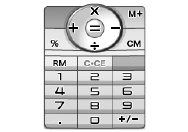
116 Organiser
Viewing the Memory Status
“Organiser”
→
“Tools 1” tab
→
“Tasks”
1. Press [Options] and select “Memory Status”.
Deleting Entries
“Organiser”
→
“Tools 1” tab
→
“Tasks”
→
[Options]
→
“Delete”
1. Select the desired option.
“This Task”: Deletes the selected entry.
“All Completed Tasks”: Deletes all checked
entries.
“All Tasks”: Deletes all entries.
Calculator
The calculator function performs the 4 arithmetic
calculations using up to 12 digits.
“Organiser”
→
“Tools 1” tab
→
“Calculator”
Key operations for calculation are as follows:
To enter a decimal point, press P.
To clear the entered number or function, press U.
To do the calculations, press B.
To start a new calculation, press U.
(M 3-4)
Organiser 117
Rate Conversion
You can also use the calculator as a currency calculator
to convert from/to a home currency using a conversion
rate that you enter.
To Set a Currency Conversion Rate
“Organiser”
→
“Tools 1” tab
→
“Calculator”
→
[Options]
→
“Currency Converter”
→
“Exchange
Rate”
1. Select “Domestic” or “Foreign”.
2. Enter the domestic or foreign currency.
To Convert a Value
“Organiser”
→
“Tools 1” tab
→
“Calculator”
1. Enter the value to be converted.
2. Press [Options] and select “Currency Converter”.
3. Select “Convert to Domestic” or “Convert to
Foreign”.
Expenses Memo
You can record an expenses memo with pre-defined or
edited categories.
Recording in the Expenses Memo
“Organiser”
→
“Tools 1” tab
→
“Expenses Memo”
→
“Add New Expense”
1. Enter the expenses using the digit keys.
2. Select the desired category.
Expenses memo is registered.
Viewing Totals
“Organiser”
→
“Tools 1” tab
→
“Expenses Memo”
→
“Totals”
Recorded expenses are displayed on the screen.
To Change Category
1. In the total view, highlight the desired item.
2. Press [Change].
3. Select the desired category.
(M 3-5)
(M 3-5-1)
(M 3-5-2)
118 Organiser
To Change Amount
1. In the total view, highlight the desired item.
2. Press [Options] and select “Change Amount”.
3. Enter the desired amount using the digit keys.
To Delete a Recorded Item or All Items
1. In the total view, highlight the desired item.
2. Press [Options] and select “Delete Item” or “Delete
All”.
Editing the Category Name
“Organiser”
→
“Tools 1” tab
→
“Expenses Memo”
→
“Edit Category”
1. Select the desired category name.
2. Modify the name.
Stopwatch
You can store 4 lap times when using the stopwatch
function.
“Organiser”
→
“Tools 2” tab
→
“Stopwatch”
1. Press [Start].
Press [LAP] to view the lap time before the
stopwatch stops. Last 4 lap times are saved.
2. Press [Stop].
Tip
•You can save a record of lap times and the stop time
by pressing [Options] and selecting “Save to
Templates”.
Resetting the Time
1. After stopping the stopwatch, press [Options] and
select “Reset”.
(M 3-5-3)
(M 3-
d
-1)
Organiser 119
Countdown Timer
“Organiser”
→
“Tools 2” tab
→
“Countdown Timer”
1. Enter the time to count.
You can set the time from 1 second to 60 minutes.
2. Press [Start].
Press [Suspend] to pause the countdown.
Press [Resume] to continue counting.
3. When the countdown has finished, press [Stop] and
then press [Start] to start the countdown again.
Editing the Countdown Time
1. In the countdown start screen, press [Options] and
select “Edit”.
2. Modify the desired time.
World Clock
Setting the Time Zone
“Organiser”
→
“Tools 2” tab
→
“World Clock”
1. Press [Edit] and select “Set Time Zone”.
The current time zone is indicated by red line on the
world map.
2. Press c or d to change the time zone.
3. Press [Accept].
To Set the Custom Time Zone
“Organiser”
→
“Tools 2” tab
→
“World Clock”
1. Press [Edit] and select “Set Time Zone”.
2. Press [Custom].
3. Enter the desired city name and time difference.
Setting Daylight Saving
“Organiser”
→
“Tools 2” tab
→
“World Clock”
1. Press [Edit] and select “Daylight Saving”.
2. Select “On” or “Off”.
(M 3-
d
-2) (M 3-
d
-3)
120 Organiser
Hour Minder
Hour Minder function informs you of the time by
sounding a tone.
“Organiser”
→
“Tools 2” tab
→
“Hour Minder”
1. Select “Switch On/Off”.
2. Select “On” or “Off”.
3. Select “Select Time”.
4. Select the desired time.
5. Select “Save”.
To Change the Settings
“Organiser”
→
“Tools 2” tab
→
“Hour Minder”
1. Select “Advanced”.
2. Select the item you wish to change.
“Assign Tone/Video”:
Assigns a tone or video clip file.
“Volume”: Sets the volume.
“Vibration”: Sets the vibration.
“Duration”: Sets the duration.
“For Silent Profile”:
Sets whether to sound a tone
when the profile is set to
“Silent”.
“Link to World Clk”:
Sets to sound a tone according to
the time of the World Clock.
Document Viewer
You can view PC documents.
“Organiser”
→
“Tools 3” tab
→
“Document Viewer”
1. Select the file you wish to view.
To cancel reading, press U or C.
Note
•You can view the following types of files with the
document viewer: PDF (.pdf), Microsoft Excel (.xls),
Microsoft Word (.doc), Microsoft PowerPoint (.ppt).
•For the shortcut keys that can be used in the
document viewer, refer to the help by pressing
[Options] and selecting “Help”.
•A file of up to 10 MB can be opened.
•Some files may not be displayed correctly depending
on the type or size, such as a file of vertical text (not
supported) or when the memory runs out while
viewing a large document.
•Some PDF files may not be displayed correctly due to
a shortage of memory even if the file size is not large
when numerous fonts are embedded or image data is
pasted.
(M 3-
d
-4)
(M 3-
d
-
d
-1)
Organiser 121
•Depending on how the PDF document was created,
some characters in a PDF file may not be displayed.
•Document files that are saved in Gallery or linked in
a WAP/Web page can be viewed with the document
viewer.
•When the motion control setting for “Document
Viewer” is set to “On” (p. 138), you can zoom in or
zoom out by tilting the phone forward or backward.
This is only available when the phone is closed.
•Document files that are protected with a password
cannot be viewed with the document viewer.
Text Templates
You can register up to 500 text templates for use in text
messages and multimedia messages. The maximum
capacity of the text templates is 8192 characters.
Adding Phrases to Text Templates
“Organiser”
→
“Tools 3” tab
→
“Text Templates”
→
“Add New Template”
1. Enter the text.
2. Select the desired category.
Editing Text Templates
“Organiser”
→
“Tools 3” tab
→
“Text Templates”
1. Highlight the text template you wish to edit.
2. Press [Options] and select “Edit Text”.
To view the text template, press B.
To delete the text template, press [Options] and
select “Delete”.
3. Modify the text and press B.
Changing the Category
“Organiser”
→
“Tools 3” tab
→
“Text Templates”
1. Highlight the desired text template.
2. Press [Options] and select “Change Category”.
3. Select the desired category.
(M 3-
d
-
d
-2)
122 Organiser
Sending Text Templates
“Organiser”
→
“Tools 3” tab
→
“Text Templates”
1. Highlight the text template you wish to send.
2. Press [Options] and select “Send Template”.
3. Select “As Message”, “Via Bluetooth” or “Via
Infrared”.
For “Via Bluetooth”
For details, see “Bluetooth” on page 154.
For “Via Infrared”
For details, see “Infrared” on page 157.
Voice Recorder
This allows you to record a voice clip, which can be
used to remind you of schedule entries or be sent within
a multimedia message. The recorded voice clip is saved
in Sound Gallery. Voice clips are saved in .amr format.
Recording a Voice Clip
“Organiser”
→
“Tools 3” tab
→
“Voice Recorder”
1. Press B to start recording.
To stop recording before the recording time is over,
press B.
2. Select “Save” to save the voice clip.
Note
•Press a (or V) or b (or W) to adjust the sound
volume when playing back the recorded file.
Sending Voice Clips
“Organiser”
→
“Tools 3” tab
→
“Voice Recorder”
1. Press B to start recording.
To stop recording before the recording time is over,
press B.
2. Select “Save and Send”.
Selecting the Record Time
“Organiser”
→
“Tools 3” tab
→
“Voice Recorder”
→
[Options]
→
“Record Time”
1. Select “For Message” or “Extended Voice”.
When selecting “Extended Voice”, voice clips are
automatically saved to a memory card.
Selecting Storage Memory
“Organiser”
→
“Tools 3” tab
→
“Voice Recorder”
→
[Options]
→
“Save Recording to”
1. Select the desired location.
When selecting “Choice”, you can select the
location when saving a voice clip.
(M 3-
d
-
d
-3)
Organiser 123
Scanner
With the built-in digital camera, you can read barcodes
in QR code format. The scanned data can be saved as a
Phonebook entry, URL, Email address and text.
Note
•When scanning does not take place, it may be due to
one of the following reasons: type or size of barcode,
scratches, dirt, damage, print quality, light
reflection, etc.
Reading Barcodes
“Organiser”
→
“Tools 3” tab
→
“Scanner”
→
“Scan
Barcode”
1. Display the barcode using the camera.
2. Press [Scan].
3. Press [Options] and select the desired option.
The options vary depending on the scanned data.
“Save”: The result is saved.
“Send Message”: The result is sent as SMS or
MMS.
“Save to Templates”: The result is saved as text.
“Copy”: The result is copied.
To Select the Focus Mode
“Organiser”
→
“Tools 3” tab
→
“Scanner”
→
“Scan
Barcode”
1. Press [Options] and select “Focus”.
2. Select “Auto Focus”, “Macro” or “Manual Focus”.
To Use Continuous Scanning
1. In scanning mode, press [Options] and select
“Continuous Scan”.
2. Select “On” or “Off ”.
To Set the Mobile Light
“Organiser”
→
“Tools 3” tab
→
“Scanner”
→
“Scan
Barcode”
1. Press [Options] and select “Mobile Light”.
2. Select “On” or “Off”.
To Adjust the Exposure
“Organiser”
→
“Tools 3” tab
→
“Scanner”
→
“Scan
Barcode”
1. Press [Options] and select “Exposure”.
2. Select the desired exposure.
(M 3-
d
-
d
-4)
124 Organiser
Viewing the Scanned Data
“Organiser”
→
“Tools 3” tab
→
“Scanner”
→
“Scanned Results”
1. Highlight the data you wish to view, then press
[View].
Phone Help
You can view the help list and use it to guide you in the
phone’s functions.
“Organiser”
→
“Tools 3” tab
→
“Phone Help”
1. Select “Settings Method”, “Common Functions” or
“Key Operation”.
2. Press a or b.
(M 3-
d
-
d
-5)

SIM Application 125
SIM Application
You can refer to the information on the SIM/USIM
card. Contact your service provider for further details.
(M 10)

126 Settings
Settings
Phone Settings
Setting a Profile
There are 4 profiles: “Normal”, “Car”, “Silent” and
“Personal”.
Activating a Profile
“Settings”
→
“Phone Settings” tab
→
“Profiles”
1. Select the desired profile.
Note
•When a profile is set, the corresponding indicator
described on page 24 is displayed in stand-by.
•The settings of “Normal” profile cannot be changed.
•For “Silent” and “Car” profiles, some of the
settings, such as volume level, cannot be changed.
Tip
•In stand-by, long press R to switch Profiles
between Silent mode and the profile most recently
activated.
Resetting Profile Settings
“Settings”
→
“Phone Settings” tab
→
“Profiles”
1. Highlight the profile you wish to reset.
2. Press [Reset].
3. Enter your handset code.
The default handset code is “9999”. For details on
changing the handset code, see “Changing the
Handset Code” on page 140.
Event Light
You can set the Small Light to flash when receiving an
incoming call or a new message.
“Settings”
→
“Phone Settings” tab
→
“Profiles”
1. Highlight “Car”, “Silent” or “Personal”.
2. Press [Edit].
3. Select “Event Light”.
4. Select the desired option.
“For Voice Call”: Flashes when an incoming
voice call is received.
“For Video Calling”: Flashes when an incoming
video calling is received.
“For New Message”: Flashes when a new
message is received.
“Java Start”: Flashes when Bluetooth
notification is received.
“Delivery Report”: Flashes when a delivery
report is received.
(M 9)
(M 9-1)
Settings 127
Status Light
You can set the Small Light to flash when you miss any
incoming calls or new messages.
“Settings”
→
“Phone Settings” tab
→
“Profiles”
1. Highlight “Car”, “Silent” or “Personal”.
2. Press [Edit].
3. Select “Status Light”.
4. Select the desired option.
“For Missed Call”: Flashes when an incoming
voice call is missed.
“For New Message”: Flashes when a new
message is missed.
“Java Start”: Flashes when Bluetooth
notification is missed.
“Delivery Report”: Flashes when a delivery
report is missed.
Any Key Answer
You can answer a call by pressing any key except F,
U, S, [Options], [Busy], X or side keys. For details,
see page 35.
“Settings”
→
“Phone Settings” tab
→
“Profiles”
1. Highlight “Car”, “Silent” or “Personal”.
2. Press [Edit].
3. Select “Any Key Answer”.
4. Select “On” or “Off”.
Setting the Display
You can change the display settings.
Setting the Wallpaper
Your phone includes preset pictures to be used as
wallpaper in stand-by. Pictures taken with the phone’s
digital camera or images downloaded from a WAP site
can also be used as wallpaper.
“Settings”
→
“Phone Settings” tab
→
“Display
Settings”
→
“Wallpaper”
1. Select “Vertical” or “Horizontal”.
2. Select the folder in which the picture you wish to set
is contained.
Pictures can be selected from “Preset Pictures”,
“Picture Gallery”, “Flash®” or “Other Documents”.
3. Select the desired picture.
4. After displaying the picture, press B.
Note
•Some pictures cannot be used because of their
picture and data types.
•Wallpaper can be linked to a theme. Select “Link to
Theme” in step 2.
(M 9-2)
(M 9-2-1)
128 Settings
Assigning Pictures
Pictures can be displayed when turning the power on or
off, when receiving an incoming call, or when
operating the alarm.
Pictures taken with the phone’s digital camera or
images downloaded from a WAP site can be used.
To Set Built-in Pictures
“Settings”
→
“Phone Settings” tab
→
“Display
Settings”
→
“Assign Pictures”
1. Select the desired function to set the picture to.
2. Select “Preset Animation” when you select “Power
On” or select “Power Off” in step 1.
Select “Pattern 1”, “Pattern 2” or “Pattern 3” when
you select “Incoming Voice Call”, “Incoming
Video Call” or “Alarm” in step 1.
To Set Saved Pictures
“Settings”
→
“Phone Settings” tab
→
“Display
Settings”
→
“Assign Pictures”
1. Select the desired function to set the picture to.
2. Select “Picture Gallery”, “Flash®” or “Other
Documents”.
3. Select the desired picture.
4. After displaying the picture, press B.
5. Specify the area you wish to display using the
navigation keys, then press B.
Note
•Some pictures cannot be used because of their
picture and data types.
Setting the Font
To Set the Font Size
“Settings”
→
“Phone Settings” tab
→
“Display
Settings”
→
“Font Size Settings”
1. Select “Menu”, “Entering Text”, “Messaging” or
“Viewing the Web”.
2. Select the desired font size.
Setting the Stand-by Display
You can set the stand-by screen display.
“Settings”
→
“Phone Settings” tab
→
“Display
Settings”
→
“Standby Display”
1. Select “Clock/Calendar”, “Display Icons” or “Show
Operator Name”.
(M 9-2-2)
(M 9-2-3)
(M 9-2-4)
Settings 129
Setting the Vivid Mode
“Settings”
→
“Phone Settings” tab
→
“Display
Settings”
→
“Vivid Mode”
1. Select the desired mode.
Setting the Greeting Message
You can set the message which is displayed when the
phone is turned on.
“Settings”
→
“Phone Settings” tab
→
“Display
Settings”
→
“Greeting Message”
1. Select “Switch On/Off” and then select “On” or
“Off”.
Tip
•If you wish to edit the message, select “Edit
Message” in step 1 and enter a message (up to 10
characters).
Backlight
The backlight will turn off if you do not press the
keypad for a certain length of time. You can specify a
desired time to elapse before the backlight turns off,
which will help conserve battery life.
Tip
•When you purchase this phone, Backlight is set to 15
seconds.
To Select the Backlight Time Out Duration
“Settings”
→
“Phone Settings” tab
→
“Display
Settings”
→
“Backlight”
→
“Time Out”
1. Select the desired time.
When selecting “Other”, enter the desired time.
Select “Off” to shut it off.
To Adjust the Brightness of the Backlight
“Settings”
→
“Phone Settings” tab
→
“Display
Settings”
→
“Backlight”
→
“Brightness”
1. Press a (Light) and b (Dark) to switch between 5
levels of clarity.
2. Press B.
Note
•You can set the auto brightness adjustment function
by selecting “Auto Sensor” in step 1.
(M 9-2-5)
(M 9-2-6)
(M 9-2-7)
130 Settings
Setting the Display Saving
The screen of this phone will automatically turn off
after a given amount of time. You can change the length
of time before the Display Saving goes into effect,
which will help conserve battery life.
“Settings”
→
“Phone Settings” tab
→
“Display
Settings”
→
“Display Saving”
1. Select the desired time.
When you purchase this phone, Display Saving is
set to 1 minute.
Note
•To cancel the Display Saving: The display saving
continues until either a key is pressed or there is an
incoming alert. The first key press only cancels this
function. You must press another key in order to enter
any numerical or text value.
Setting the Display Manner
You can set the backlight to turn off for a specified
time. If any operation is performed while Display
Manner is set, the backlight turns on. Display Manner
is resumed when the backlight dims.
“Settings”
→
“Phone Settings” tab
→
“Display
Settings”
→
“Display Manner”
1. Select “Switch On/Off”.
2. Select “On” or “Off”.
To Set the Screen Time Out when the Phone is
Closed
“Settings”
→
“Phone Settings” tab
→
“Display
Settings”
→
“Display Manner”
1. Select “Lights out period”.
2. Enter the start time and end time.
3. Press [Save].
Note
•Enter the start and end times according to the format
set in “Time Format”.
•If the clock settings have not been entered, the date
and time entry screen is displayed (p. 136).
(M 9-2-8) (M 9-2-9)
Settings 131
Setting the Display Time when the Phone is
Closed
You can specify a desired time to elapse before the
backlight and screen turn off after the slider is closed.
“Settings”
→
“Phone Settings” tab
→
“Display
Settings”
→
“CLS Disp. Time”
1. Select the desired option.
“1 sec.”: The screen turns off after 1
second.
“3 sec.”: The screen turns off after 3
seconds.
“5 sec.”: The screen turns off after 5
seconds.
“10 sec.”: The backlight turns off after
5 seconds, and the screen
turns off after 10 seconds.
“Follow the Settings”: The backlight and screen
turn off according to normal
settings.
Note
•Regardless of the Keypad Lock setting, the screen
turns off after 5 seconds.
Setting the Caller Display
You can set the phone to show or hide the caller’s
number when the slider is closed.
“Settings”
→
“Phone Settings” tab
→
“Display
Settings”
→
“Caller Display”
1. Select “On” or “Off”.
Select “Off” to hide the caller’s name and number.
Setting the Dial Number
You can set the type of number which is displayed
when making a call.
“Settings”
→
“Phone Settings” tab
→
“Display
Settings”
→
“Dial Number”
1. Select the desired type of dial number.
(M 9-2-10)
(M 9-2-11)
(M 9-2-12)
132 Settings
Themes
You can easily customise the display by using the
theme files.
The theme files downloaded from a WAP site can be
used.
“Settings”
→
“Phone Settings” tab
→
“Themes”
1. Select “Preset Themes” or “My Themes”.
2. Select the desired theme file.
Tip
•Even after a theme is set, you can set a wallpaper
regardless of the set theme. In this case, the other
items follow the set theme.
Sound Settings
You can use this menu to check or edit the current
profile settings (except “Any Key Answer”).
“Settings”
→
“Phone Settings” tab
→
“Sound
Settings”
Volume
You can adjust the volume for incoming voice calls,
SMS/MMS/Email messages and other sounds to one of
six levels.
“Settings”
→
“Phone Settings” tab
→
“Sound
Settings”
→
“Volume”
1. Select “For Incoming Call”, “For New Message”,
“Java Start”, “Delivery Report” or “General
Volume”.
2. Press a (or d) to increase the ringer volume or
press b (or c) to decrease the ringer volume and
then press B.
To select “Silent”, press b (or c) at level 1.
(M 9-3) (M 9-4)
(M 9-4-1)
Settings 133
Assigning a Ringtone for an Incoming Call
You can set a ringtone for incoming voice calls and
video callings. You can select from different tones
including patterns, sound effects and melodies or set a
sound in Sound Gallery as the default ringtone.
“Settings”
→
“Phone Settings” tab
→
“Sound
Settings”
→
“Ringtone/Ringvideos”
1. Select “For Voice Call” or “For Video Calling”.
2. Select “Preset Sounds”, “Sound Gallery” or
“Flash®”.
3. Highlight the ringtone you wish to use.
4. Press B.
Note
•Melodies can be selected from “Sound Gallery”,
“Preset Sounds” or “Flash®”.
Assigning a Ring Video Clip for an Incoming
Call
You can set a ring video clip for incoming voice calls
and video callings. You can set a video clip in Video
Gallery as the default ring video clip.
“Settings”
→
“Phone Settings” tab
→
“Sound
Settings”
→
“Ringtone/Ringvideos”
1. Select “For Voice Call” or “For Video Calling”.
2. Select “Video Gallery”.
3. Highlight the ring video clip file you wish to use.
4. Press B.
134 Settings
Notification
When receiving messages, Bluetooth notification or
delivery reports, your phone will notify you of their
arrival with the ringtone or ring video clip you specify.
“Settings”
→
“Phone Settings” tab
→
“Sound
Settings”
→
“Ringtone/Ringvideos”
1. Select “For New Message”, “Java Start” or
“Delivery Report”.
2. Select “Assign Tone”.
3. Select the desired folder.
4. Highlight the desired ringtone or ring video clip.
For details on selecting a ringtone or a ring video
clip, see “Assigning a Ringtone for an Incoming
Call” or “Assigning a Ring Video Clip for an
Incoming Call” on page 133.
5. Press B.
6. Select “For New Message”, “Java Start” or
“Delivery Report”.
7. Select “Duration”.
8. Enter the desired duration of message notification in
2 digits using the digit keys.
9. Press B.
Keypad Tones
When the keypad tone is set on, you will hear a
confirmation tone each time you press any key.
“Settings”
→
“Phone Settings” tab
→
“Sound
Settings”
→
“System Sounds”
→
“Keypad Tones”
1. Select the desired tone pattern.
Warning Tone
Your phone can be set to emit a warning tone when an
error occurs.
“Settings”
→
“Phone Settings” tab
→
“Sound
Settings”
→
“System Sounds”
→
“Warning Tone”
1. Select “Sound” or “Duration”.
For “Sound”, select “Off”, “Preset Sounds” or
“Sound Gallery”.
For “Duration”, select the desired time.

Settings 135
Power On/Off Sound
Your phone can be set to emit a sound when it is
switched on or off.
“Settings”
→
“Phone Settings” tab
→
“Sound
Settings”
→
“System Sounds”
1. Select “Power On Sound” or “Power Off Sound”.
2. Select “Sound” or “Duration”.
For “Sound”, select “Off”, “Preset Sounds” or
“Sound Gallery”.
For “Duration”, enter the desired duration of sound
in 2 digits using the digit keys.
Handset Open/Close Sound
Your phone can be set to emit a sound when it is opened
or closed.
“Settings”
→
“Phone Settings” tab
→
“Sound
Settings”
→
“System Sounds”
1. Select “Handset Open” or “Handset Close”.
2. Select “Sound” or “Duration”.
For “Sound”, select “Off”, “Preset Sounds” or
“Sound Gallery”.
For “Duration”, select the desired time.
Charge Full
Your phone can be set to emit a sound when it is fully
charged.
“Settings”
→
“Phone Settings” tab
→
“Sound
Settings”
→
“System Sounds”
→
“Charge Full”
1. “Select “Sound” or “Duration”.
For “Sound”, select “Off”, “Preset Sounds” or
“Sound Gallery”.
For “Duration”, select the desired time.
Vibration
“Settings”
→
“Phone Settings” tab
→
“Sound
Settings”
→
“Vibration”
1. Select “For Incoming Call”, “For New Message”,
“Java Start” or “Delivery Report”.
2. Select “Switch On/Off” and then select “On” or
“Link to Sound” to activate.
3. Select “Vibration Pattern” and then select the
desired vibration pattern.
Tip
•When you select “On” for “For Incoming Call”,
“ ” is displayed in stand-by.
(M 9-4-4)
136 Settings
Surround Sound
You can set surround sound.
“Settings”
→
“Phone Settings” tab
→
“Sound
Settings”
→
“Surround”
1. Select “On” or “Off”.
Date & Time
You need to set the correct time and date in order for
your phone’s various time-based functions to work
correctly.
“Settings”
→
“Phone Settings” tab
→
“Date & Time”
→
“Set Date/Time”
1. Enter the day, month, year and time using the digit
keys.
Tip
•When you enter the time in the 12-hour format, press
a or b to switch between am and pm. The order in
which the date and time is displayed is based on the
format setting.
To Set Daylight Saving
“Settings”
→
“Phone Settings” tab
→
“Date & Time”
→
“Daylight Saving”
1. Select “On” or “Off”.
To Set the Time Zone
“Settings”
→
“Phone Settings” tab
→
“Date & Time”
→
“Set Time Zone”
1. Press c or d to select the home city to set.
2. Press B.
To Customise the Time Zone
“Settings”
→
“Phone Settings” tab
→
“Date & Time”
→
“Set Time Zone”
1. Press [Custom].
2. Enter the city name.
3. Enter the time-zone differences using the digit keys.
Press a or b to switch between − and +.
4. Press B.
World Clock
For details, see page 119.
To Select the Time Format
“Settings”
→
“Phone Settings” tab
→
“Date & Time”
→
“Time Format”
1. Select “24 Hour” or “12 Hour”.
(M 9-4-8)
(M 9-5-1)
(M 9-5-2)
(M 9-5-4)
(M 9-5-5)
Settings 137
To Select the Date Format
“Settings”
→
“Phone Settings” tab
→
“Date & Time”
→
“Date Format”
1. Select from “D-M-Y”, “M-D-Y” or “Y-M-D”.
To Select the Calendar Format
“Settings”
→
“Phone Settings” tab
→
“Date & Time”
→
“Calendar Format”
1. Select “Sunday-Saturday” or “Monday-Sunday”.
Language Setting
You can change the language displayed on the phone.
“Settings”
→
“Phone Settings” tab
→
“Language”
1. Select the desired language.
Tip
•You can also change the input language on the text
entry screen (p. 42).
Note
•If you select “Automatic” in step 1, the language
preset on the SIM/USIM card is selected.
•If the language preset on the SIM/USIM card is not
supported, then the default language of the phone is
selected.
Motion Control Settings
To Set the Display Direction to Change
Automatically when the Phone is
Closed
“Settings”
→
“Phone Settings” tab
→
“Motion
Control”
→
“Display Change”
1. Select the desired option.
“Auto”: Automatically changes the direction of the
screen according to the direction the phone
is rotated.
“Normal”: Displays the vertical screen regardless of
the direction the phone is rotated.
(M 9-5-6)
(M 9-5-7)
(M 9-6)
(M 9-7)
(M 9-7-1)
138 Settings
To Set the Action
“Settings”
→
“Phone Settings” tab
→
“Motion
Control”
→
“Action Settings”
1. Select the desired setting.
“Quick Silent”: Enables switching to Quick
Silent mode when the phone
is turned over.
“Music”: Enables selecting a sound file
by shaking the phone
sideways.
“Messaging”: Enables changing the size of
the text by tilting the phone
forward or backward.
“Browser”: Enables zooming in or
zooming out by tilting the
phone forward or backward.
“Document Viewer”: Enables switching the page
by shaking the phone
sideways. Enables zooming
in or zooming out by tilting
the phone forward or
backward.
“Image Viewer”: Enables switching the image
displayed by shaking the
phone sideways. Enables
zooming in or zooming out
by tilting the phone forward
or backward.
“Back Tap”: Enables ending an
application by tapping the
back of the phone.
2. Select “On” or “Off”.
Setting the Sound Output
“Settings”
→
“Phone Settings” tab
→
“Switch
Ringtone Output”
1. Select “Earphone Only” or “Earphone + Speaker”.
Change Menu
You can change the type of menu to display.
“Settings”
→
“Phone Settings” tab
→
“Change
Menu”
1. Select “Standard Menu” or “Large Font Menu”.
(M 9-7-3)
(M 9-8)
(M 9-10)
Settings 139
Security Settings
You can set various locks on your phone such as PIN
Entry and Handset Lock.
“Settings”
→
“Phone Settings” tab
→
“Security
Settings”
Enabling/Disabling the PIN Code
If the PIN code is enabled, you are asked to enter the
PIN code each time the phone is switched on. Your PIN
code is registered on the SIM/USIM card and you
should have been made aware of the code when you
purchased the SIM/USIM card. Contact your service
provider for further details.
Select “On” for “PIN Entry” and enter your PIN code if
you wish to activate the PIN lock.
Note
•If you enter the wrong PIN code three times, the SIM/
USIM card will lock. To remove the lock, contact
your service provider or SIM/USIM card vendor.
To Change the PIN Code
This allows you to change the PIN code registered on
the SIM/USIM card. Before you change the PIN code,
select “On” for “PIN Entry”.
Enter the existing PIN code for “Change PIN” after
selecting “PIN Entry”, and enter a new PIN code twice.
To Change the PIN2 Code
PIN2 is a second PIN code used to unlock certain
features of a SIM/USIM card, such as Fixed Dialling
and Call Cost metering. Not all SIM/USIM cards use
the PIN2 code. This menu may not be displayed
depending on the type of your SIM/USIM card.
Enter the existing PIN2 code for “Change PIN2”, and
enter a new PIN2 code twice.
Handset Lock
The Handset Lock prevents unauthorised use of the
phone or certain features on the phone when the power
is turned on. By setting this option on, your phone or
certain features on your phone are locked until the
correct handset code is entered.
Select “On” for “Handset Lock” if you wish to activate
the Handset Lock.
140 Settings
Function Lock
By setting this option on, all the functions of your
phone will be locked until the correct handset code is
entered.
Enter your handset code after selecting “Function Lock”.
To Turn Off the Function Lock
Enter your handset code in stand-by to turn the
Function Lock off.
Phonebook Lock
The Phonebook Lock function prevents unauthorised
use of your Phonebook.
Select “On” to lock or “Off” to unlock for “Phonebook
Lock” and enter your handset code.
The default handset code is “9999”. For details on
changing the handset code, see “Changing the Handset
Code”.
History Lock
The History Lock function prevents unauthorised
access to Call Log. By setting this option on, Call Log
cannot be viewed until the correct handset code is
entered.
Press [Check] to lock or [Uncheck] to unlock.
Showing Secret Data
By setting this option on, the hidden data can be
displayed.
Select “On” to display or “Off” to hide for “Show
Secret Data”. Enter your handset code when you select
“On”.
The default handset code is “9999”. For details on
changing the handset code, see “Changing the Handset
Code”.
Changing the Handset Code
The default handset code is “9999”.
Select “Change Handset Code” and enter the old
handset code, then enter a new handset code twice.
Settings 141
Slider Settings
You can set the action when sliding open or sliding
close your phone.
“Settings”
→
“Phone Settings” tab
→
“Slider
Settings”
To Set the Open Action for Calling
1. Select “Calls on Open” and select the desired
option.
“On”: Enables answering an incoming call by
sliding open the phone.
“Off”: Disables answering an incoming call by
sliding open the phone.
To Set the Close Action for Calling
1. Select “Calls on Close” and select the desired
option.
“Continue Call”: Disables terminating a call by
sliding close the phone.
“End Call”: Enables terminating a call by
sliding close the phone.
To Set the Close Action for Locking
1. Select “Lock on Close” and select the desired
option.
2. Select “No Action” or “Immediate”.
“No Action”: Disables locking the phone by sliding
it close.
“Immediate”: Enables locking the phone by sliding
it close.
Master Reset
You can return the settings for M1 to M12 to the default
settings.
“Settings”
→
“Phone Settings” tab
→
“Master Reset”
→
“Reset Settings”
1. Enter your handset code.
The default handset code is “9999”. For details on
changing the handset code, see “Changing the
Handset Code” on page 140.
Note
•Some settings are not deleted by this function. Data
stored in Phonebook, etc. is not deleted.
To Reset All Settings for M1 to M12 and Delete All
Created Data
“Settings”
→
“Phone Settings” tab
→
“Master Reset”
→
“Reset All”
1. Enter your handset code.
The default handset code is “9999”. For details on
changing the handset code, see “Changing the
Handset Code” on page 140.
(M 9-12)

142 Settings
Call/Video Call
Voicemail & Diverts
This service can be used to divert incoming calls that
you cannot answer. Calls can be diverted to another
phone number or to your Voicemail system.
Note
•This service may not be available on all mobile phone
networks. Contact your service provider for more
information.
To Activate the Voicemail Service
“Settings”
→
“Call/Video Call” tab
→
“Voicemail &
Diverts”
→
“Voicemail”
→
“Activate”
1. Select one of the following options:
“Always”: Diverts all calls without
ringing.
“When Busy”: Diverts incoming calls while
you are talking on the phone.
“No Answer”: Diverts incoming calls if you
do not answer a call within a
certain period of time. Select
the period of time from 6
levels (05 to 30 seconds).
“Not Reachable”: Diverts incoming calls when
your phone has no network
service or is switched off.
2. Press B.
To Activate the Diverts Service
Select the appropriate option.
“Settings”
→
“Call/Video Call” tab
→
“Voicemail &
Diverts”
→
“Diverts”
1. Select “All Services”, “Voice Calls”, “Video
Callings” or “Messages”.
2. Select from “Always”, “When Busy”, “No Answer”
or “Not Reachable”.
3. Enter a phone number to which you wish to divert
calls or search for it in the Phonebook (p. 53).
If you select “No Answer” in step 2, select the
period of time from 6 levels (05 to 30 seconds).
4. Press B.
Note
•When “Voice Calls” diverts are set to “Always”,
“ ” is displayed in stand-by.
To Deactivate the Diverts Service
Select the appropriate option.
“Settings”
→
“Call/Video Call” tab
→
“Voicemail &
Diverts”
→
“Deactivate”
1. Select from “Always”, “When Busy”, “No Answer”
or “Not Reachable”.
2. Press B.
(M 9-d-1)
Settings 143
To Cancel the Diverts and Voicemail Service
Once you have changed the diverts settings, you can
cancel them all with this service.
“Settings”
→
“Call/Video Call” tab
→
“Voicemail &
Diverts”
→
“Cancel All”
To Check the Diverts Status
“Settings”
→
“Call/Video Call” tab
→
“Voicemail &
Diverts”
→
“Status”
1. Select the diverts option you wish to check.
Video Calling Settings
Set various types of functions and services for video
callings.
To Select an Image for the Alternative Image
You can select an image shown to the other party
between the camera image and an alternative image
from the saved picture files.
“Settings”
→
“Call/Video Call” tab
→
“Video Calling
Settings”
→
“Camera Picture”
1. Select “Default Image” or “Alternative Image”.
For “Default Image”, select “Alternative Image” or
“External Camera”.
For “Alternative Image”, select “Preset Picture”,
“Picture Gallery” or “Theme”.
To Select the Picture Quality
Select the desired data format for your environment.
“Settings”
→
“Call/Video Call” tab
→
“Video Calling
Settings”
→
“Incoming Picture Quality”
“Settings”
→
“Call/Video Call” tab
→
“Video Calling
Settings”
→
“Outgoing Picture Quality”
1. Select “Normal”, “Quality Priority” or “Frame Rate
Priority”.
Select “Frame Rate Priority” to perform faster
communication.
To Assign Hold Guidance Picture
You can display an image saved in the phone on your
display while you are putting a call on hold.
“Settings”
→
“Call/Video Call” tab
→
“Video Calling
Settings”
→
“Hold Guidance Picture”
1. Select “Preset Picture”, “Picture Gallery” or
“Theme”.
2. Select the desired picture.
(M 9-d-2)
(M 9-d-2-1)
(M 9-d-2-4)
144 Settings
To Set the Backlight
With this setting on, the phone’s backlight is on when
making a video calling.
“Settings”
→
“Call/Video Call” tab
→
“Video Calling
Settings”
→
“Backlight”
1. Select “Always On”, “Always Off” or “As Normal
Setting”.
The “As Normal Setting” option depends on the
backlight setting of the display (p. 129).
To Turn On or Off the Speaker
“Settings”
→
“Call/Video Call” tab
→
“Video Calling
Settings”
→
“Loudspeaker”
1. Select “On” to turn on the loudspeaker or select
“Off” to turn it off.
To Mute the Microphone
You can mute the microphone while making a video
calling.
“Settings”
→
“Call/Video Call” tab
→
“Video Calling
Settings”
→
“Mute Microphone”
1. Select “On” to mute or “Off” to cancel mute.
To Set the Remote Monitor
You can set the phone to answer video callings
automatically.
“Settings”
→
“Call/Video Call” tab
→
“Video Calling
Settings”
→
“Remote Monitor”
1. Enter your handset code.
2. Select “Switch On/Off”.
3. Select “On” or “Off”.
To Set the Auto Answer List
Register phone numbers to the Auto Answer list.
“Settings”
→
“Call/Video Call” tab
→
“Video Calling
Settings”
→
“Remote Monitor”
1. Enter your handset code.
2. Select “Auto Answer List”.
3. Select a blank field.
4. Enter the desired number.
To Set the Answer Time
“Settings”
→
“Call/Video Call” tab
→
“Video Calling
Settings”
→
“Remote Monitor”
1. Enter your handset code.
2. Select “Answer Time”.
3. Enter the time from 0 to 30 seconds (in 2 digits).
(M 9-
d
-2-5)
(M 9-d-2-6)
(M 9-d-2-7)
Settings 145
Showing Your Number
This lets you control whether to show your phone
number when calling another party or not.
“Settings”
→
“Call/Video Call” tab
→
“Show Your
Number”
1. Select “On”, “Off” or “Status”.
Note
•Some networks do not support this service. Please
check with your service provider for availability.
Restrict Calls
This function lets you place restrictions on incoming
and outgoing calls. To activate this option you will need
the specified password, which is available from your
service provider.
“Settings”
→
“Call/Video Call” tab
→
“Restrict
Calls”
1. Select “Outgoing Calls” or “Incoming Calls”.
“Outgoing Calls”: Restricts outgoing calls.
“Incoming Calls”: Restricts incoming calls.
2. Select one of the following options:
(For “Outgoing Calls”)
“Bar All Outgoing Calls”:
Restricts all outgoing calls
except emergency calls.
“Bar International Calls”:
Restricts all outgoing
international calls.
“Only Local & Home”:
Restricts all outgoing
international calls except to
your home country.
(For “Incoming Calls”)
“Bar All Incoming Calls”:
Restricts all incoming calls.
“Bar if Abroad”: Restricts all incoming calls
when you are outside of the
coverage from your
registered service provider.
3. Select one of the following options:
“All Services”: Restricts all services.
“Voice Calls”: Restricts all voice calls.
“Video Callings”: Restricts all video callings.
“Messages”: Restricts all messages.
4. Select “On”, “Off” or “Status”.
5. Enter the network password.
(M 9-
d
-3)
(M 9-d-4)
146 Settings
To Cancel Settings
“Settings”
→
“Call/Video Call” tab
→
“Restrict
Calls”
1. Select “Outgoing Calls” or “Incoming Calls”.
2. Select “Cancel All”.
3. Enter the network password.
Fixed Dialling Numbers
This option is available on most SIM/USIM cards for
mobile phones. It allows you to configure a SIM/USIM
card so that it can only be used to make calls to numbers
on a predefined list.
Note
•This service depends on the SIM/USIM card.
To Enable Fixed Dialling Numbers
“Settings”
→
“Call/Video Call” tab
→
“Restrict
Calls”
→
“FDN”
1. Select “Switch On/Off”.
2. Select “On” to enable this function.
3. Enter your PIN2 code.
To Add a New Name
“Settings”
→
“Call/Video Call” tab
→
“Restrict
Calls”
→
“FDN”
1. Select “Edit Dial List”.
2. Select a blank field.
3. Enter your PIN2 code.
4. Add a name and a phone number.
For details on adding a name and phone number, see
“Adding a New Phonebook Entry” on page 52.
5. Press [Save].
Rejecting an Incoming Call
You can register phone numbers you do not wish to
answer.
To Reject the Registered Number
“Settings”
→
“Call/Video Call” tab
→
“Restrict
Calls”
→
“Rejected Numbers”
→
“Switch On/Off”
1. Select “On” or “Off”.
To Register the Rejected Number
“Settings”
→
“Call/Video Call” tab
→
“Restrict
Calls”
→
“Rejected Numbers”
→
“Set Rejecting
Number”
1. Select a blank field.
2. Enter the desired number.
Settings 147
Rejecting a Call when the Caller’s Number is
Withheld
“Settings”
→
“Call/Video Call” tab
→
“Restrict
Calls”
→
“Withheld Call”
1. Select “On” or “Off”.
Changing the Network Password
“Settings”
→
“Call/Video Call” tab
→
“Restrict
Calls”
→
“Change N/W Password”
1. Enter the old network password.
2. Enter a new network password.
3. Enter the new network password again.
If you enter the incorrect password, you are asked to
enter the password again.
4. Press B.
Minute Minder
Minute Minder function informs you of your talk time
by sounding a tone after every minute.
“Settings”
→
“Call/Video Call” tab
→
“Minute
Minder”
1. Select “On” or “Off”.
Auto Answer
You can set the phone to answer voice calls
automatically.
“Settings”
→
“Call/Video Call” tab
→
“Auto
Answer”
1. Enter your handset code.
2. Select “Switch On/Off”.
3. Select “On” or “Off”.
To Set the Answer Time
“Settings”
→
“Call/Video Call” tab
→
“Auto
Answer”
1. Enter your handset code.
2. Select “Answer Time”.
3. Enter the time from 1 to 30 seconds.
(M 9-d-5)
(M 9-
d
-6)
148 Settings
Call Waiting
Note
•This service may not be available on all mobile phone
networks. Contact your service provider for more
information.
If you wish to be able to receive another incoming call
while you have a call in progress, you must activate the
Call Waiting service.
“Settings”
→
“Call/Video Call” tab
→
“Call Waiting”
1. Select “On”, “Off” or “Status”.
Display Call Timer
“Settings”
→
“Call/Video Call” tab
→
“Display Call
Timer”
1. Select “On” or “Off”.
Display Call Cost
“Settings”
→
“Call/Video Call” tab
→
“Display Call
Cost”
1. Select “On” or “Off”.
Auto Redial
“Settings”
→
“Call/Video Call” tab
→
“Auto Redial”
1. Select “On” or “Off”.
Network Settings
Network Settings
To Select a Service Automatically
Each time the power is turned on, your phone selects a
service automatically.
“Settings”
→
“Network Settings” tab
→
“Network
Settings”
→
“Select Service”
1. Select “Auto”.
To Select a Service Manually
“Settings”
→
“Network Settings” tab
→
“Network
Settings”
→
“Select Service”
1. Select “GSM”.
Note
•When “GSM” is selected for the network setting,
functions for 3G service, such as video callings or
high speed data access, cannot be used.
(M 9-
d
-7)
(M 9-d-8)
(M 9-d-9)
(M 9-d-10)
(M 9-
d
-
d
-1)
Settings 149
To Select a Network Automatically
Each time the power is turned on, your phone always
tries to connect to the preferred network.
If your phone is not connected to the network, you can
perform the following immediately to establish the
preferred network connection.
“Settings”
→
“Network Settings” tab
→
“Network
Settings”
→
“Select Network”
→
“Automatic”
To Select the Network Manually
“Settings”
→
“Network Settings” tab
→
“Network
Settings”
→
“Select Network”
→
“Manual”
1. Select the desired network.
To Edit the Preferred List
“Settings”
→
“Network Settings” tab
→
“Network
Settings”
→
“Select Network”
→
“Set Preferred”
1. Select the name of the network you wish to edit.
2. Select “Insert” to insert over the selected position,
“Add to end” to insert at the end or “Delete” to
delete.
To Add a New Network
“Settings”
→
“Network Settings” tab
→
“Network
Settings”
→
“Select Network”
→
“Add New
Network”
1. Select “Add”.
2. Enter the country code (up to 3 digits).
3. Enter the network code (up to 3 digits).
4. Enter a new network name (up to 25 characters).
5. Select the desired network type.
6. Enter either 2G (GSM) or 3G for the network type.
Showing the Network Information
“Settings”
→
“Network Settings” tab
→
“Network
Settings”
→
“Network Information”
Information about the operator is displayed.
Off Line Mode
When the Off Line Mode is set to “On”, the phone cuts
off the network connections and stops searching for
available networks to connect.
“Settings”
→
“Network Settings” tab
→
“Off Line
Mode”
1. Select “On” or “Off”.
(M 9-d-d-1-3)
(M 9-d-d-2)
150 Settings
Internet Settings
Note
•In normal operations, you do not need to change the
settings.
•Internet settings have already been entered in your
phone depending on your service provider. You may
have restrictions on viewing, deleting, copying or
modifying the settings. Contact your service provider
for details.
Browser Settings
“Settings”
→
“Network Settings” tab
→
“Internet
Settings”
→
“Browser Settings”
→
“Create New”
“Profile Name”: Browser profile name
(unique name)
“Proxy”: Proxy setting for Browser
(when “Use Proxy” is On)
“Access Point”: Access point for Browser
(when “Use Proxy” is Off)
“Use Proxy”: Setting to connect by Proxy
or not
“Home”: Home page URL (when
“Use Proxy” is Off)
Java™ Settings
“Settings”
→
“Network Settings” tab
→
“Internet
Settings”
→
“Java™ Settings”
→
“Create New”
“Profile Name”: Profile name for Java™
application (unique name)
“Proxy”: Proxy setting for Java™
application (when “Use
Proxy” is On)
“Access Point”: Access point for Java™
application (when “Use
Proxy” is Off)
“Use Proxy”: Setting to connect by Proxy
or not
(M 9-
d
-
d
-3)
(M 9-d-d-3-1)
(M 9-
d
-
d
-3-2)
Settings 151
Streaming Settings
“Settings”
→
“Network Settings” tab
→
“Internet
Settings”
→
“Streaming Settings”
→
“Create New”
“Profile Name”: Profile name for streaming
(unique name)
“Proxy Address”: Proxy address
“Proxy Port Number”: Port number (1-65535)
“Access Point”: Access point
Proxy Settings
“Settings”
→
“Network Settings” tab
→
“Internet
Settings”
→
“Proxy Settings”
→
“Create New”
“Proxy Name”: Proxy name (unique name)
“Proxy Address”: IP address
“Access Point”: Access point
“Home”: Home page URL
“Port Number”: Port number (1-65535)
“
Authentication Type
”: Authentication type
(“HTTP-BASIC” or
“HTTP-DIGEST”)
“User Name”: User name for
authentication
“Password”: Password for authentication
Access Point Settings
“Settings”
→
“Network Settings” tab
→
“Internet
Settings”
→
“Access Point Settings”
→
“Create New”
“Access Point Name”: Access point name (unique
name)
“APN”: APN setting
“
Authentication Type
”: Authentication type
(“NONE”, “PAP” or
“CHAP”)
“User Name”: User name for access point
“Password”: Password for access point
“DNS”: DNS (Domain Name
System)
“Linger Time”: Linger Time (1-99999 sec.)
(M 9-
d
-
d
-3-3)
(M 9-d-d-3-4)
(M 9-
d
-
d
-3-5)
152 Settings
Re-provisioning Settings
“Settings”
→
“Network Settings” tab
→
“Internet
Settings”
→
“Re-provisioning Settings”
→
“Execute
Pending”
Clearing DNS Cache
“Settings”
→
“Network Settings” tab
→
“Internet
Settings”
→
“Clear DNS Cache”
To Activate the Browser/Java™/Streaming Profile
“Settings”
→
“Network Settings” tab
→
“Internet
Settings”
1. Select “Browser Settings”, “Java™ Settings” or
“Streaming Settings”.
2. Select the desired profile you wish to activate.
To Edit/View/Copy/Delete the Browser/Java™/
Streaming/Proxy/Access Point Profile
“Settings”
→
“Network Settings” tab
→
“Internet
Settings”
1. Select “Browser Settings”, “Java™ Settings”,
“Streaming Settings”, “Proxy Settings” or “Access
Point Settings”.
2. Highlight the desired profile.
3. Press [Options] and select the desired option.
“Edit”: Modify the desired item.
“View”: Confirm the details of the
profile.
“Copy”: Enter the new file name.
“Delete”: Select “Yes” to delete.
(M 9-
d
-
d
-3-6)
(M 9-d-d-3-7)

Call Log 153
Call Log
The phone will record the last 30 missed calls, received
calls and dialled numbers.
Viewing Call Log
“Call Log”
1. Select from “All Calls”, “Dialled Numbers”,
“Missed Calls” or “Received Calls”.
The selected call log list is displayed.
To switch logs, press c or d.
2. Select the phone number you wish to view.
If you wish to dial the number, press D to make a
voice call or T to make a video calling.
Tip
•You can also confirm call logs by pressing D in
stand-by.
Sending Messages
1. In the call log list, highlight the phone number or
name you wish to send a message to.
2. Press [Options] and select “Create Message”.
For details on creating a message, see “Creating a
New Message” on page 79.
Deleting a Call Log
1. In the call log list, press [Options] and select
“Delete” or “Delete All”.
Call Timers
This function lets you check the duration of your calls.
Checking the Duration of the Last Call and All Calls
“Call Log”
→
“Call Timers”
1. Select “Dialled Calls” or “Received Calls”.
Resetting Call Timers
“Call Log”
→
“Call Timers”
→
“Clear Timers”
1. Enter your handset code.
The default handset code is “9999”. For details on
changing the handset code, see “Changing the
Handset Code” on page 140.
Data Counter
You can confirm the number of bytes used in the data
transmission.
“Call Log”
→
“Data Counter”
1. Select “Last Data” or “All Data”.
Resetting All Data Counter
“Call Log”
→
“Data Counter”
→
“Clear Counter”
(M 11) (M 11-5)
(M 11-5-3)

154 Connectivity
Connectivity
By configuring the settings in this menu, you can
connect to Bluetooth wireless technology or infrared
enabled phones, as well as PCs (USB connection is
possible using Data Cable accessory).
Bluetooth
For using the Bluetooth wireless function, you need to
search for other Bluetooth wireless technology enabled
devices to establish contact with your phone. Keep your
phone within a distance of 10 metres from the devices
before searching.
Using the Bluetooth Wireless Function
To Turn On or Off the Bluetooth Wireless Function
“Connectivity”
→
“Bluetooth”
→
“Switch On/Off”
1. Select “On” or “Off”.
When “On” is selected, the Bluetooth wireless
setting is activated, and “ ” is displayed.
To Search for Devices to be Paired
A maximum of 16 devices can be searched for.
“Connectivity”
→
“Bluetooth”
→
“Search for
Devices”
1. Select the desired device for pairing.
2. Enter the device passcode.
Note
•You can search for devices even when the Bluetooth
wireless function is off. Once pairing is started, the
phone turns the Bluetooth wireless function on
automatically.
•You can only select one device for pairing. To change
the paired device, see “To Activate the Paired
Device” on page 155.
•Pairing means authentication has been established
between the two devices.
•In order to pair two devices with Bluetooth wireless
technology, the users should agree on the same
passcode for both devices.
•The passcode is used only once, so there is no need to
remember it. The passcode can be different each time
the devices are connected.
•Devices that do not have a user interface (i.e.,
headsets and car kits) have a factory-set passcode.
See the user guide for the device.
(M 12)
(M 12-1)
(M 12-1-1)
(M 12-1-2)
Connectivity 155
Tip
•You can save battery power by turning the Bluetooth
wireless function off while it is not in use. Turn the
Bluetooth wireless function off in “To Turn On or Off
the Bluetooth Wireless Function” on page 154 or in
“To Turn Off Automatically” on page 157.
•During a call, you can divert voice calls to the paired
handsfree device. Press [Options], select “Transfer
Audio” and then “To Handset” or “To Bluetooth”.
To Activate the Paired Device
Paired devices are listed by tabs for all devices for
handsfree devices and for Audio devices.
“Connectivity”
→
“Bluetooth”
→
“Paired Devices”
1. Press d to switch to the list for handsfree devices.
2. Select the desired device you wish to activate.
To Check the Paired Handsfree Devices
“Connectivity”
→
“Bluetooth”
→
“Paired Devices”
1. Press d to switch to the list for handsfree devices.
2. Highlight the desired handsfree device.
3. Press [Options] and select “Set to Prior Connect”.
To Check the Audio Device
“Connectivity”
→
“Bluetooth”
→
“Paired Devices”
1. Press d twice to switch to the list for audio devices.
2. Highlight the desired audio device.
3. Press [Options] and select “Set to Prior Connect”.
To Rename or Delete the Paired Devices
“Connectivity”
→
“Bluetooth”
→
“Paired Devices”
1. Press c or d to switch between all paired devices
and handsfree devices.
2. Highlight the desired device.
3. Press [Options].
4. Select “Change Name” or “Delete”.
You can rename or delete by pressing B after
selecting desired device.
156 Connectivity
To Send All Data to Other Devices
You can send all the data for applications such as
Phonebook, Calendar, Tasks to selected devices.
“Connectivity”
→
“Bluetooth”
→
“Send All”
1. Select the desired device.
If a device is not specified, searching starts
automatically.
2. Enter your handset code.
The default handset code is “9999”. For details on
changing the handset code, see “Changing the
Handset Code” on page 140.
3. Select the desired data to send.
4. Enter the device passcode for unpaired devices.
Note
•If the handsfree device is connected, the confirmation
screen to deactivate the handsfree function is
displayed. Select “Yes” to deactivate.
Bluetooth Wireless Settings
With this setting you can rename your phone, prevent
other devices from recognising your phone and turn the
Bluetooth wireless function off automatically to save
battery power, etc.
To Rename Your Phone
You can rename your phone. The name is shown on
other devices when your phone is detected.
“Connectivity”
→
“Bluetooth”
→
“Bluetooth
Settings”
→
“Device Name”
1. Enter the new device name.
To Show or Hide Your Phone
“Connectivity”
→
“Bluetooth”
→
“Bluetooth
Settings”
→
“Visibility”
1. Select the desired visibility settings.
“Show My Phone”: Allows other devices to
recognise your phone.
“Hide My Phone”: Hides your phone from
other devices.
To Select the Sound Output
“Connectivity”
→
“Bluetooth”
→
“Bluetooth
Settings”
→
“Sound Output”
1. Select “Phone/Earphone” or “Bluetooth Device”.
(M 12-1-4)
(M 12-1-5)

Connectivity 157
To Switch the Handsfree Settings
You can switch modes of the handsfree kit between two
modes; talking with the handsfree kit or talking with the
phone.
“Connectivity”
→
“Bluetooth”
→
“Bluetooth
Settings”
→
“Handsfree Setting”
1. Select “Handsfree Mode” or “Private Mode”.
“Handsfree Mode”: For talking with the handsfree
kit
“Private Mode”: For talking with the phone
To Set Java™ Application Request
You can set whether to accept Java™ application
requests from other devices.
“Connectivity”
→
“Bluetooth”
→
“Bluetooth
Settings”
→
“Java™ Application Request”
1. Select “On” or “Off”.
To Turn Off Automatically
“Connectivity”
→
“Bluetooth”
→
“Bluetooth
Settings”
→
“Bluetooth Timeout”
1. Select the desired time.
Your phone turns the function off automatically
after the specified time.
To See Your Phone Details
“Connectivity”
→
“Bluetooth”
→
“My Phone Details”
Infrared
In order to use the Infrared function, you need to search
for other infrared enabled devices to establish contact
with your phone. Keep your phone within a distance of
20 centimetres before searching. The infrared setting
will return to off when no data is transmitted/received
via infrared communication.
Infrared communication is only available when the
phone is open.
Turning On or Off
“Connectivity”
→
“Infrared”
→
“Switch On/Off”
1. Select “On(3 min)” or “Off”.
The infrared setting is activated, and “ ” is
displayed.
Sending All Data
“Connectivity”
→
“Infrared”
→
“Send All”
1. Enter your handset code.
The default handset code is “9999”. For details on
changing the handset code, see “Changing the
Handset Code” on page 140.
2. Select the desired data to send.
3. Enter the authorisation code.
(M 12-1-6)
(M 12-2)
(M 12-2-1)
(M 12-2-2)
158 Connectivity
Mass Storage
You can set the phone to connect to a PC via Mass
Storage mode.
“Connectivity”
→
“Mass Storage”
1. Select “Yes”.
Note
•Activating Mass Storage mode also activates offline
mode.
•
Mass Storage is not available when the battery is low,
a Java™ application is paused, Music Player is
active, or a memory card is not inserted in your phone.
USB Charge
You can set the phone to charge via USB, connected to
a PC.
“Connectivity”
→
“USB Charge”
1. Select “Enable” or “Disable”.
Card Settings
Formatting Memory Card
“Connectivity”
→
“Card Settings”
→
“Format Card”
1. Enter your handset code.
The default handset code is “9999”. For details on
changing the handset code, see “Changing the
Handset Code” on page 140.
2. Select “Yes” to start formatting.
(M 12-3)
(M 12-4)
(M 12-5)
(M 12-5-2)
Connectivity 159
Making a Backup File
With a memory card inserted in your phone, you can
back up data in Messages (Inbox, Drafts, Sent
Messages), Call Manager, Message Groups, Calendar,
Tasks, Text, and Bookmarks in the handset memory to
the memory card. You can also restore the backup data
from the memory card.
“Connectivity”
→
“Card Settings”
→
“Backup/
Restore”
→
“Backup”
1. Enter your handset code.
The default handset code is “9999”. For details on
changing the handset code, see “Changing the
Handset Code” on page 140.
2. Check off the desired items to back up and press
[Execute].
To back up all files, press [Options] and select
“Check All” to check off all items. Then press
[Execute].
3. Select “Yes” to start backing up the data.
Restoring a Backup File
“Connectivity”
→
“Card Settings”
→
“Backup/
Restore”
→
“Restore”
1. Enter your handset code.
The default handset code is “9999”. For details on
changing the handset code, see “Changing the
Handset Code” on page 140.
2.
Check off the desired items to restore and press [OK].
To restore all files, press [Options] and select
“Check All” to check off all items. Then press [OK].
3. Select the desired file to restore and press [OK].
A confirmation message indicating deletion from
the handset memory is displayed.
4. Select “Yes” to start restoring.
Deleting a Backup File
“Connectivity”
→
“Card Settings”
→
“Backup/
Restore”
→
“File Management”
1. Select the desired folder.
2. Check off the desired files to delete and press
[Delete].
To delete all backup files, press [Options] and select
“Check All” to check off all files. Then press
[Delete].
3. Select “Yes” to start deleting.

160 Connecting WX-T825 to Your PC
Connecting WX-T825 to Your
PC
You can use the following functions by connecting the
WX-T825 to your PC using a USB data cable or via
Bluetooth wireless technology:
• 3G/GSM modem
• Handset Manager for WX-T825
• Music Manager for WX-T825
• Sync Manager for WX-T825
Note
•Operation with software not provided by Sharp is not
guaranteed.
System Requirements
Operating System:
Windows 2000*, Windows XP**, Windows Vista
* Service Pack 4 or later
** Service Pack 2 or later
Supported Software:
Microsoft Outlook/Outlook Express
Interface:
USB port or Bluetooth wireless port
CD-ROM drive
To use Music Manager, DirectX9 and Windows Media
Player 9 or later are required.
3G/GSM Modem
You can use WX-T825 as a 3G/GSM modem to access
the Internet from your PC. Connect your phone to your
PC via Bluetooth wireless technology or USB interface.
Software installation on your PC is required.
Modem via the USB Data Cable
1. Insert the CD-ROM into your PC’s CD-ROM drive.
The WX-T825 CD-ROM screen is displayed.
If the WX-T825 CD-ROM screen is not displayed,
double-click [Launcher.exe] in your CD-ROM.
2. Select the USB driver from the on-screen
instructions of your CD-ROM, and start installation
of USB driver software following the on-screen
instructions of your CD-ROM.
•
During installation, the on-screen instructions ask
you to connect your phone to your PC. Power on
your phone and atta
ch the phone to the USB port
of your PC using the USB data cable (optional
accessory).
3. Follow the on-screen instructions to complete
installation.
Connecting WX-T825 to Your PC 161
4. Select the modem driver from the on-screen
instructions of your CD-ROM, and install modem
driver software following the on-screen instructions
of your CD-ROM.
5. Follow the on-screen instructions to use your phone
as a modem driver.
• When the on-screen instructions ask for the
modem driver type, select the cable as a modem
driver.
Modem via Bluetooth Connection
1. Turn on the Bluetooth wireless function of your
phone.
For details, see “To Turn On or Off the Bluetooth
Wireless Function” on page 154.
2. Pair your PC with your phone.
For details on pairing your PC with your phone, see
“To Search for Devices to be Paired” on page 154.
3. Insert the CD-ROM into your PC’s CD-ROM drive.
The WX-T825 CD-ROM screen is displayed.
If the WX-T825 CD-ROM screen is not displayed,
double-click [Launcher.exe] in your CD-ROM.
4. Select the modem driver from the on-screen
instructions of your CD-ROM, and install modem
driver software following the on-screen instructions
of your CD-ROM.
5. Follow the on-screen instructions to use your phone
as a modem driver.
• When the on-screen instructions ask for the
modem driver type, select Bluetooth as a modem
driver.
Note
•Modem communication is not possible while
communicating with the Handset Manager via
Bluetooth wireless technology or USB interface.
•It is not recommended that you make or answer calls
when you are using WX-T825 as a GSM/GPRS
modem. The operation may be interrupted.
•Your phone exhausts the battery when connected to a
PC, even when not communicating.
•For a detailed explanation on how to use the modem
driver, please click and refer to the help on the
modem driver.

162 Connecting WX-T825 to Your PC
Handset Manager
You can transmit the following items between your
phone and your PC, and can use Phonebook entries on
your PC:
• Gallery files (pictures/sounds/video clips/themes/
Flash® files/Other Documents data)
• Phonebook entries
• Schedule entries
Via USB Data Cable
1. Insert the CD-ROM into your PC’s CD-ROM drive.
The WX-T825 CD-ROM screen is displayed.
If the WX-T825 CD-ROM screen is not displayed,
double-click [Launcher.exe] in your CD-ROM.
2. Select Handset Manager from the on-screen
instructions of your CD-ROM, and start installation
of Handset Manager software following the
on-screen instructions of your CD-ROM.
• If you have not installed the USB driver, follow
steps 2 and 3 on page 160.
3. Follow the on-screen instructions to complete
installation.
• During installation, the on-screen instructions
ask you to select an interface. Select the USB
data cable as an interface.
4. Power on your phone and attach the phone to the
USB port of your PC using the USB data cable
(optional accessory).
5. Launch Handset Manager from the relevant folder.
6. Enter your handset code.
7. Follow the on-screen instructions of Handset
Manager.
For details, see the User Guide Software which is
installed within Handset Manager or our web-site,
http://www.sharp-mobile.com.

Connecting WX-T825 to Your PC 163
Via Bluetooth
1. Insert the CD-ROM into your PC’s CD-ROM drive.
The WX-T825 CD-ROM screen is displayed.
If the WX-T825 CD-ROM screen is not displayed,
double-click [Launcher.exe] in your CD-ROM.
2. Select Handset Manager from the on-screen
instructions of your CD-ROM, and start installation
of Handset Manager software following the
on-screen instructions of your CD-ROM.
3. Follow the on-screen instructions to complete
installation.
• During installation, the on-screen instructions
ask you to select an interface. Select Bluetooth as
an interface.
4. Launch Handset Manager from the relevant folder.
5. Enter your handset code.
6. Follow the on-screen instructions of Handset
Manager.
Note
•Some large files may not be able to be transmitted
from the PC to the phone.
•Applications (Camera, Gallery, etc.) cannot be run
when the phone is connected to the PC via Bluetooth
wireless technology interface or USB data cable.
•If you have already installed Sharp Handset
Manager, you need to uninstall the previous one.
•If you have trouble with installation, uninstall
Handset Manager, restart your PC, reinstall Handset
Manager and restart.
•For details, see the User Guide Software which is
installed within Handset Manager or our web-site,
http://www.sharp-mobile.com.
Music Manager
You can manage the playlist and exchange sound files
on your PC. Available files are the sound files in the
following formats: MP3, AAC, 3GPP.
Tip
•MP3 files with two or more periods (“.”) used in the
file name cannot be saved.
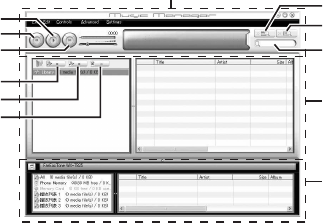
164 Connecting WX-T825 to Your PC
Main Control Panel
Control all the main actions from here.
Play: Plays back a file.
Previous: Returns to the top portion of the
current file.
Next: Jumps to the next file.
Search Media File: Searches for a media file.
Browse: Browses all the media files
sorted in Genre/Artist/Album.
Input Window: Quickly finds the media files in
Library or the playlist with
keyword entry.
Media Management in PC
Media files in PC can be easily explored in 2 main
columns.
Add Playlist: Creates a new playlist.
Add Smart Playlist: Creates a new smart playlist.
Remove Playlist: Removes a playlist.
Media Management in Handset
Media files in Handset can be easily explored in 2
main columns.
Previous Browse
Search Media File
Input Window
Media Management
in PC
Media Management
in Handset
Play
Next
Add Playlist
Add Smart Playlist
Remove Playlist
Main Control Panel
Connecting WX-T825 to Your PC 165
• With the drag and drop operation, you can upload the
sound files and the playlists from your PC, and also
download them to your PC.
• With the drag and drop operation, you can change the
order of tracks in the playlist of your PC.
• You can create a new playlist and delete an existing
playlist.
• With the drag and drop operation, you can add a
sound file to a playlist, and delete them from the
playlist.
• You can edit the name of a playlist of your PC.
• You can edit the title, artist name, and album name of
sound files of your PC (only available in MP3
format).
Tip
•To add tracks from your PC into the Music Manager
library, go to “Advanced” then search music tracks.
•Once you have created your list, drag the list to the
WX-T825 area on Music Manager, and the files will
be uploaded to the WX-T825. If one or more of the
files is already stored on the handset, Music Manager
will not upload them again; the playlist will play the
track already uploaded.
•Music Manager also allows you to import existing
playlists (M3U file type) that you may have created
using other media programs.
•Use Smart Playlist to automatically add tracks to a
playlist based on criteria you can select.
Sync Manager
You can synchronise the following data with the data of
Microsoft Outlook or Outlook Express on your PC.
• Phonebook entries
• Schedule entries
Tip
•You can set up Sync Manager to start up and
synchronise automatically after you connect your
phone to your PC via the USB data cable.

166 Troubleshooting
Troubleshooting
Problem Solution
The phone does not
turn on.
• Make sure the battery is
properly inserted and
charged.
PIN code or PIN2
code is rejected.
• Make sure you have entered
the correct code (4 to 8
digits).
• Your SIM/USIM card/
protected functions will
become locked after three
unsuccessful attempts.
• Contact your SIM/USIM
provider if you do not have
the correct PIN code.
The SIM/USIM card
becomes locked.
• Enter the PUK code (8 digits)
provided by your service
provider (if supported).
• If the attempt is successful,
enter the new PIN code and
confirm your phone is
operational again. Otherwise
contact your dealer.
The display is
difficult to read.
• Adjust the backlight
brightness for the display.
Phone functions do
not work after the
phone is turned on.
• Check the radio signal
strength indicator as you may
be outside the service area.
• Check to see if any error
message is displayed when
you turn your phone on. If so,
contact your dealer.
• Make sure the SIM/USIM
card is correctly inserted.
Call quality is poor.
• Your current location may not
provide good call quality (i.e.,
in a car or train). Move to a
location where radio signal
strength is greater.
Cannot send or
receive text
message.
• Make sure you are correctly
subscribed for the Short
Message Service, that the
network supports this service,
and that the centre number is
set up correctly. If not, contact
your network service
provider.
Problem Solution

Troubleshooting 167
Calls cannot be
made or received.
• If the message “Insert SIM
Card” is displayed when the
phone is switched on, you
cannot use your SIM/USIM
card or the SIM/USIM card is
damaged. Contact your
dealer or network service
provider.
• Check your call barring, fixed
dialling setting, remaining
battery and call forwarding
settings.
• Check if your phone is
currently performing data
communication using Infrared
(IrDA), Bluetooth wireless
technology interface or a USB
data cable.
• Check the remaining balance
if you are using a pre-paid
SIM/USIM card.
Cannot access
network service.
• Check where your account
has been registered and
where the service is
available.
Limited memory
available.
• Delete any unnecessary data.
Problem Solution
Cannot connect to
Multimedia
Messaging Service
provider.
• MMS settings and
configuration may be missing
or incorrect or the network
does not support it. Check
your service provider’s
access point number.
Contact your service provider
to confirm the correct
settings.
Call is terminated
unexpectedly.
• Magnetised objects such as
health necklaces placed near
the phone may terminate the
call. Keep your phone away
from such objects.
No entries are
displayed in the
Phonebook.
• Confirm that the Source
setting (Handset or SIM/
USIM) is correct.
Cannot receive
OBEX data.
• The OBEX data can only be
received in stand-by.
Problem Solution

168 Safety Precautions and Conditions of Use
Safety Precautions and
Conditions of Use
Your phone conforms to international regulations
insofar as it is used under normal conditions and in
accordance with the following instructions.
Conditions of Use
Electromagnetic waves
• Do not switch on your phone aboard an aircraft (as
your phone may interfere with the aircraft’s
electronic systems). Current legislation forbids this
use and legal action can be taken against the user.
• Do not switch on your phone in a hospital, except in
designated areas.
• Use of your phone’s function may affect the
performance of medical electronic units
(pacemakers, hearing aids, insulin pumps, etc.).
When the phone function is on, do not bring it near
medical equipment or into areas in which medical
equipment is being used. If you have a hearing aid or
a pacemaker, only use the phone on the opposite side
of your body from where it is located. The phone
should be kept at least 6 inches (15.24 cm) from a
pacemaker ANYTIME the phone is switched on.
• Do not switch on your phone near gas or flammable
substances.
• Observe the rules concerning the use of mobile
phones at gasoline stations, chemical plants and at all
sites where a risk of explosion exists.
Caring for your phone
• Do not allow children to use your phone without
supervision.
• Do not open or attempt to repair your phone yourself.
The product can only be repaired by authorised
service personnel.
• Do not drop your phone or subject it to severe
impacts. Bending the body and pushing the display or
keys with extreme force could damage the phone.
• Do not use solvents to clean your phone. Use only a
soft, dry cloth.
• Do not carry your phone in your back pocket as it
could break when you sit down. The display is made
of glass and is particularly fragile.
• Avoid touching the external connector on the
underside of the phone, since the delicate
components within can be damaged by static
electricity.
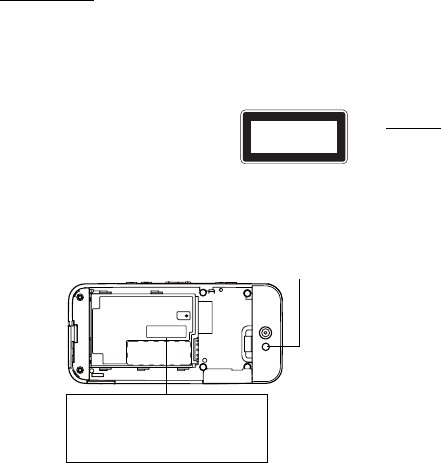
Safety Precautions and Conditions of Use 169
Mobile Light
Do not use Mobile Light near people’s faces.
Eyesight may be temporarily affected leading to
accidents.
CAUTION
Use of controls, adjustments or
performance of procedure other
than those specified herein may
result in hazardous radiation
exposure. As the emission level
from Mobile Light LED used in this product is harmful
to the eyes, do not attempt to disassemble the cabinet.
Servicing is limited to qualified servicing station only.
Mobile Light LED Properties
a) Emission Duration: Continuous
b) Wavelength
White: 400-700 nm
c) Maximum Emission Output
White: 105 µW (1.5 mW inside handset)
Battery
• Use your phone only with batteries, chargers and
accessories recommended by the manufacturer. The
manufacturer disclaims any liability for damage
caused by the use of other chargers, batteries or
accessories.
•Network configuration and phone usage will
affect talk-time and stand-by time.
Using the games or camera will hasten battery
consumption.
•When the battery charging alert is displayed on
the screen, charge the battery as soon as possible.
If you continue using your phone ignoring the alert,
the phone may cease to function, and all data and
settings you have stored may be lost at any moment.
• Before removing the battery from the phone, make
sure the phone is switched off.
• Replace and charge the new battery as soon as
possible after removing the old one.
CLASS 1
LED Product
EN60825-1:1994 A1:2002 & A2:2001
CAUTION-CLASS 1M
LED RADIATION WHEN OPEN
DO NOT VIEW DIRECTLY WITH
OPTICAL INSTRUMENTS
Mobile Light

170 Safety Precautions and Conditions of Use
• Do not touch the battery terminals. Batteries can
cause damage, injury or burns if a conductive
material touches exposed terminals. When the battery
is detached from the phone, use a cover made of
non-conductive material for keeping and carrying the
battery safely.
• Recommended temperature for using and storing
batteries is approximately 20°C.
• The batteries’ performance is limited in low
temperatures, particularly below 0°C and the phone
may not work temporarily regardless of the amount
of remaining battery power.
• Exposing the phone to extreme temperatures will
shorten battery life.
• The battery can be charged and discharged hundreds
of times but it will eventually wear out. When the
operating time (talk-time and stand-by time) is
noticeably shorter than normal, it is time to buy a new
battery.
CAUTION
RISK OF EXPLOSION IF BATTERY IS REPLACED
BY AN INCORRECT TYPE,
DISPOSE OF USED BATTERIES ACCORDING
TO THE INSTRUCTIONS
See “Battery Disposal” on page 17.
Aerial Care
• Do not cover the top or bottom area of the phone
(p. 15, No. 29 , 29 ) with your hand when in use
as this may interfere with the performance of the
built-in aerial. Call quality may deteriorate leading to
shortened talk-time and stand-by time because the
mobile phone has to operate on a higher power level
than is necessary.
• Use only the aerial supplied or one approved by
Sharp for your mobile phone. Using unauthorised or
modified aerials may damage the mobile phone.
Moreover, since the mobile phone may violate the
appropriate regulations, it may lose performance or
exceed the limitation of SAR levels.
• To avoid impaired performance, do not damage the
aerial of the mobile phone.
• To avoid interfering with blasting operations, please
turn off the mobile phone in a blasting area or in a
place where a “turn off two-way radio” sign is
posted.

Safety Precautions and Conditions of Use 171
Camera Operation
• Learn picture quality, file formats, etc. beforehand.
The taken pictures can be saved in JPEG format.
• Be careful not to move your hand while taking
pictures.
If the phone moves while taking a picture, the picture
can become blurred. When taking a picture, hold the
phone firmly to prevent it from moving, or use the
delay timer.
• Clean the lens cover before taking a picture.
Fingerprints, oils, etc. on the lens cover hinder clear
focusing. Wipe them off with a soft cloth before
taking a picture.
Others
• As with any electronic storage unit, data may be lost
or corrupted under various circumstances.
• Before connecting the phone with a PC or a
peripheral unit, read the operation manual for the
other unit carefully.
• If the phone’s battery has been removed for some
time, or the phone has been reset, the unit’s clock and
calendar may be reinitialised. The date and time
should be updated in this case.
• The phone uses a magnet to recognise that the phone
is closed. Do not place magnetic cards near your
phone or get the card caught in the phone as it may
damage the recorded data.
Environment
• Keep your phone away from extreme heat. Do not
leave it on the dashboard of a car or near a heater. Do
not leave it in any place that is extremely damp or
dusty.
• Since this product is not waterproof, do not use it or
store it where fluids such as water can splash onto it.
Raindrops, water spray, juice, coffee, steam,
perspiration, etc. will also cause malfunctions.
172 Safety Precautions and Conditions of Use
Precautions Concerning Vehicle Use
• It is the user’s responsibility to check the local laws
governing the use of a mobile phone in vehicles. Pay
full attention to driving. Pull off to the side of the
road, park the car, and switch off the engine before
making or answering a call.
• Use of your phone’s function may interfere with the
vehicle’s electronic systems, such as the ABS
anti-lock brakes or the air-bag. To ensure no such
problem occurs, please check with your dealer or car
manufacturer before connecting your phone.
• The phone uses a magnet to recognise that the phone
is closed. Do not place magnetic cards near your
phone or get the card caught in the phone as it may
damage the recorded data.
• Only allow qualified service maintenance personnel
to install vehicle accessories.
The manufacturer disclaims any liability for damage
which may result as a consequence of improper use or
use contrary to the instructions contained herein.
SAR
Your Sharp mobile phone has been designed,
manufactured and tested so as not to exceed the limits
for exposure to electromagnetic fields as required by
the NCC. These limits are part of comprehensive
guidelines developed by independent scientific
organisations. The guidelines include a substantial
safety margin designed to assure the safety of the phone
user and others and to take into account variations in
age and health, individual sensitivities and
environmental conditions. The NCC rules provide for
the amount of radio frequency electromagnetic energy
absorbed by the body when using a mobile phone to be
measured by reference to the Specific Absorption Rate
(SAR). The SAR limit for the general public is
currently 2.0 watts per kilogram averaged over 10
grams of body tissue. Your Sharp mobile phone SAR
value is 0.923 W/kg. This has been tested to ensure
that this limit is not exceeded even when the phone is
operating at its highest certified power. In use however
your Sharp mobile phone may operate at less than full
power because it is designed to use only sufficient
power to communicate with the network.

Safety Precautions and Conditions of Use 173
FCC NOTICE
This device complies with part 15 of the FCC Rules.
Operation is subject to the following two conditions:
(1) This device may not cause harmful interference, and
(2) this device must accept any interference received,
including interference that may cause undesired
operation.
Changes or modifications not expressly approved by
the manufacturer responsible for compliance could
void the user’s authority to operate the equipment.
Exposure to Radio Waves
THIS MODEL PHONE MEETS THE
GOVERNMENT’S REQUIREMENTS FOR
EXPOSURE TO RADIO WAVES.
Your wireless phone is a radio transmitter and receiver.
It is designed and manufactured not to exceed the
emission limits for exposure to radio frequency (RF)
energy set by the Federal Communications
Commission of the U.S. Government. These limits are
part of comprehensive guidelines and establish
permitted levels of RF energy for the general
population. The guidelines are based on standards that
were developed by independent scientific organizations
through periodic and thorough evaluation of scientific
studies. The standards include a substantial safety
margin designed to assure the safety of all persons,
regardless of age and health.
The exposure standard for wireless mobile phones
employs a unit of measurement known as the Specific
Absorption Rate, or SAR. The SAR limit set by the
FCC is 1.6 W/kg.* Tests for SAR are conducted using
standard operating positions specified by the FCC with
the phone transmitting at its highest certified power
level in all tested frequency bands. Although the SAR
is determined at the highest certified power level, the
actual SAR level of the phone while operating can be
well below the maximum value. This is because the
phone is designed to operate at multiple power levels so
as to use only the power required to reach the network.
In general, the closer you are to a wireless base station
aerial, the lower the power output.
Before a phone model is available for sale to the public,
it must be tested and certified to the FCC that it does not
exceed the limit established by the government-adopted
requirement for safe exposure. The tests are performed
in positions and locations (e.g., at the ear and worn on
the body) as required by the FCC for each model. The
highest SAR value for this model phone when tested for
use at the ear is 0.248 W/kg and when worn on the
body, as described in this user guide, is 0.603 W/kg.
Body-worn Operation; This device was tested for
typical body-worn operations with the back of the
phone kept 1.5 cm from the body. To maintain
174 Safety Precautions and Conditions of Use
compliance with FCC RF exposure requirements, use
accessories that maintain a 1.5 cm separation distance
between the user’s body and the back of the phone. The
use of belt-clips, holsters and similar accessories should
not contain metallic components in its assembly.
The use of accessories that do not satisfy these
requirements may not comply with FCC RF exposure
requirements, and should be avoided. While there may
be differences between the SAR levels of various
phones and at various positions, they all meet the
government requirement for safe exposure.
The FCC has granted an Equipment Authorization for
this model phone with all reported SAR levels
evaluated as in compliance with the FCC RF emission
guidelines. SAR information on this model phone is on
file with the FCC and can be found under the Display
Grant section of http://www.fcc.gov/oet/fccid after
searching on FCC ID APYHRO00074.
Additional information on Specific Absorption Rates
(SAR) can be found on the Cellular
Telecommunications & Internet Association (CTIA)
web-site at http://www.phonefacts.net.
* In the United States and Canada, the SAR limit for
mobile phones used by the public is 1.6 watts/kg (W/
kg) averaged over one gram of tissue. The standard
incorporates a substantial margin of safety to give
additional protection for the public and to account for
any variations in measurements.

Out of Warranty List 175
Out of Warranty List
This limited warranty shall not apply in respect of the
following:
(i) Any deterioration due to normal wear and tear
including all plastic surfaces and all other
externally exposed parts that are scratched or
damaged due to normal customer use.
(ii) Defects caused by the Product being subjected to
any of the following: use in contradiction with the
user guide, rough handling, exposure to moisture,
dampness or extreme thermal or environmental
conditions or rapid changes in such conditions,
corrosion, oxidation, unauthorised modifications
or connections, unauthorised opening or repair,
repair by use of unauthorised spare parts, misuse,
improper installation, accident, forces of nature,
spillage of food or liquid, influence from chemical
products or other acts beyond Sharp’s reasonable
control (including but not limited to lifetime, and
breakage of or damage to aerials) unless the defect
was caused directly by defects in materials or
workmanship.
(iii) Products in respect of which the product serial
number or the IMEI number has been removed,
erased, defaced, altered or made illegible.
(iv) Defects caused by the fact that the Product was
used with or connected to a product or an
accessory not manufactured or supplied by Sharp
or was used other than for its intended use.
(v) Defects caused by a defective function of the
cellular network.
(vi) Defects caused by the fact that the battery was
short-circuited or seals of the battery enclosure or
cells were broken or show evidence of tampering
or the battery was used in equipment other than
for which it has been specified.
(vii) Defects caused by the need to upgrade Products
software due to changes in cellular network
parameters.
(viii) Products operated outside published maximum
ratings.
(ix) Products rented on a monthly basis.
Charger Plug:
Do not use the AC Charger if the plug does not fit the
socket.

176 Index
Index
A
Alarms 112
Area Info 85
B
Battery 16, 169
C
Calculator 116
Calendar 107
Call Functions 34, 153
Auto Redial 148
Call Restrictions 145
Call Timers 148, 153
Call Waiting 37, 148
Conference Call 37
Data Counter 153
Earpiece Volume 36
Emergency Calls 34
International Calls 34
Make Another Call 36
Minute Minder 147
Muting the
Microphone 38,
40, 144
My Phone
Number 145
Redialling 35
Rejecting a Call 36,
39, 146
Sending a Busy
Tone 36, 40
Speaker 36, 40, 144
Speed Dialling 35, 59
Video Calling 40, 143
Voice Call 34, 36
Voicemail &
Diverts 142
Call Log 153
Camera 69
Continuous Shoot 74
Digital Zoom 70
Exposure 71
Focus Mode 71
Mobile Light 72
Panorama 74
Picture Quality 71
Picture Size 73, 76
Recording Time 76
Recording Video
Clips 70, 77
Scene 75
Settings 70
Shortcut Keys 73
Switching Modes 72
Taking Pictures 69
Video Encoding 77
Video Quality 71
Cell Broadcasts 84
Characters
Changing the Input
Method 43
Cutting, Copying,
Pasting Text 51
Entering Characters 42
Input Language 42
Stroke mode 47
Text Templates 50,
121
User Dictionary 48
Chinese User
Dictionary 48
Creating 48
Deleting 49
Editing 49
Conditions of Use 168
Connectivity 154
Countdown Timer 119
D
Display Indicators 23
Document Viewer 120
E
Expenses Memo 117
F
FET Mobile Internet 90
Browser Settings 92
Navigating a WAP or
Web Page 91
Flash®98
G
Gallery 94
Other Documents 98
H
Handset Code 140
Help 124
Hour Minder 120
I
Infrared 157
J
Java™ 102
Java™ Settings 104
M
Mass Storage 158
Master Reset 141
Memory Card 19
Index 177
Memory Status 59, 101,
111, 116
Messaging 78
Attaching/Removing
Data 80
Creating a Message 79
Drafts Box 82
Email 78, 89
Forwarding a
Message 84
Mailing List 55
MMS 78, 83, 87
Reading a Message 82
Replying to a
Message 83
Sending Options 81
Settings 86
SMS 78, 86
Motion Control 29, 137
Multimedia 60
Music Player 63
Adding a File 66
Adding a New
Playlist 66
Downloading
Music 66
Playing Back
Music 63
Searching for a File 65
Sorting 65
N
Navigating Functions 25
O
Off Line Mode 149
Organiser 107
P
PC Connection 160
Phonebook
Adding New Entry 52
Category 58
Dialling from an
Entry 54
Editing Entries 56
Group 55
Saving a Number 53
Saving an Address 82
Saving an Image 95
Searching the List 53
Sending a Message 55
Storage Memory 52
Thumbnail 56
Phonebook Lock 140
Pictures 94
PIN/PIN2 Code 139
Power On and Off 21
S
Safety Precautions 168
Screensavers 106
Settings 126
Date & Time 136
Display 127
Font 128
Internet 150
Language 137
Network 148
Profiles 126
Security 139
Sound 132
Shortcut Keys 26
Side Keys 14, 28, 67
SIM Application 125
SIM/USIM Card 16
Slider Settings 141
Sound Gallery 96
Stopwatch 118
Streaming 63
T
T9 Text Input
Using BoPoMoFo
input mode 45
Using Stroke mode 47
Using T9 English
Mode 44
Tasks 113
Themes 97
Troubleshooting 166
U
USB Charge 158
V
Video Gallery 95
Videos 60
Adding a File 61
Adding a New
Playlist 61
Downloading
Video 62
Playing Back Video 60
Searching for a File 60
Settings 62
Voice Recorder 122
W
World Clock 119
178 Index
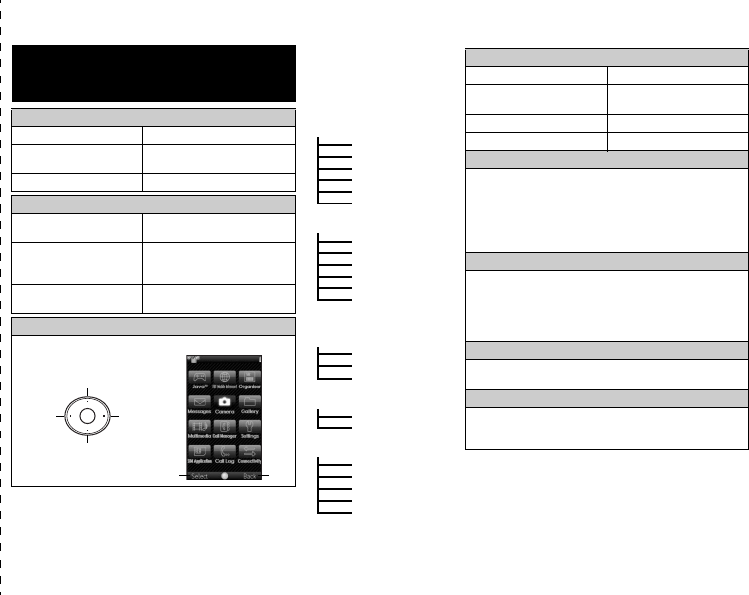
Quick Reference 179
Quick Reference
Function Key Shortcuts
To display the Main menu.
B
To mute and unmute the
microphone during a call.
C [Mute]
To turn Silent mode on. Long press R.
Special Features
To adjust earpiece
volume during a call Press V or W a few times.
To display:
Individual Call Timer
B QK, then select
“Received Calls” or “Dialled
Calls”.
Reset Call Timer B QK, then select
“Clear Timers”.
Navigating Menus
Press B to display the Main menu.
WX-T825
Messages
Press B during stand-by and
select “Messages”.
Press a or b to scroll.
Press B.
Message
Email
Alert Inbox
Cell Broadcasts
Area Info
Messaging Settings
Memory Status
Create Message
Inbox
Drafts
Sent
Outbox
Te m pl a t e s
Create Email
Inbox
Drafts
Sent
Outbox
Te m pl a t e s
Switch On/Off
Read Messages
Settings
On
Off
General Settings
SMS Settings
MMS Settings
Email Settings
Speed Mail List
AC
Up
Down
Left Right
Basic Operation
Power On/Off Long press F.
Make a call Enter number, press
D.
Answer a call Press D.
End a call Press F.
Phonebook
Storing name and number
1. Enter the phone number in stand-by.
2. Press A [Options], select “Save Number” & “As
New”.
3. Fill each field.
4. Press C [Save].
Camera/Video
Taking pictures/Recording video clips
1. Press B, select “Camera”.
2. Press C to switch between photo and video
camera modes.
3. Press B to take a picture or video.
Voice Recorder
Press B, select “Organiser”, press d twice, then
select “Voice Recorder”.
Voice Mail
Long press G (FET Voice Mail as default setting).
Alternatively, direct dial HHH (FET Voice Mail
as default setting).
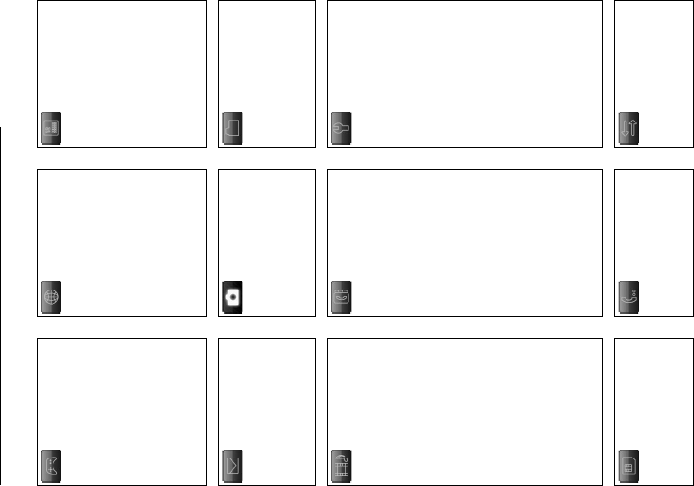
180 Quick Reference
Quick Reference Menu
Press B during stand-by mode.
Press a, b, c or d to navigate to required location.
1 Java™
1-1 Java™ Gallery
1-2 Java™ Settings
1-3 Java™ Information
c
d
2 FET Mobile Internet
2-1 Homepage
2-2 Go to URL
2-3 Bookmarks
2-4 Alert Inbox
2-5 My Saved Page
2-6 Access History
2-7 Browser Settings
c
d
3Organiser
(Tab 1: Tools 1)
3-1 Calendar
3-2 Alarms
3-3 Tasks
3-4 Calculator
3-5 Expenses Memo
(Tab 2: Tools 2)
3-1 Stopwatch
3-2 Countdown Timer
3-3 World Clock
3-4 Hour Minder
(Tab 3: Tools 3)
3-1 Document Viewer
3-2 Text Templates
3-3 Voice Recorder
3-4 Scanner
3-5 Phone Help
a ba ba b
4 Messages
4-1 Message
4-2 Email
4-3 Alert Inbox
4-4 Cell Broadcasts
4-5 Area Info
4-6 Messaging Settings
4-7 Memory Status
c
d
5 Camera
c
d
6Gallery
6-1 Picture Gallery
6-2 Video Gallery
6-3 SD VIDEO
6-4 Sound Gallery
6-5 Themes
6-6 Java™ Gallery
6-7 Flash
®
6-8 Other Documents
6-9 Memory Status
a ba ba b
7 Multimedia
7-1 Video Player
7-2 Streaming Player
7-3 Music Player
7-4 Camera
c
d
8Call Manager
8-1 Phonebook
8-2 Add New
8-3 Call Voicemail
8-4 Manage Groups
8-5 My Card
8-6 Speed Dial List
8-7 Message Groups
8-8 Phonebook Settings
8-9 Service Dialling No.
8-10 Advanced
c
d
9 Settings
(Tab 1: Phone Settings)
9-1 Profiles
9-2 Display Settings
9-3 Themes
9-4 Sound Settings
9-5 Date & Time
9-6 Language
9-7 Motion Control
9-8
Switch Ringtone Output
9-9 Earpiece Volume
9-10 Change Menu
9-11 Security Settings
9-12 Slider Settings
9-13 Master Reset
(Tab 2: Call/Video Call)
9-1 Voicemail & Diverts
9-2
Video Calling Settings
9-3 Show Your Number
9-4 Restrict Calls
9-5 Minute Minder
9-6 Auto Answer
9-7 Call Waiting
9-8 Display Call Timer
9-9 Display Call Cost
9-10 Auto Redial
(Tab 3: Network Settings)
9-1 Network Settings
9-2 Off Line Mode
9-3 Internet Settings
a ba ba b
10 SIM Application
c
d
11 Call Log
11-1 All Calls
11-2 Dialled Numbers
11-3 Missed Calls
11-4 Received Calls
11-5 Call Timers
11-6 Call Costs
11-7 Data Counter
c
d
12 Connectivity
12-1 Bluetooth
12-2 Infrared
12-3 Mass Storage
12-4 USB Charge
12-5 Card Settings
WX
-
T82
5

English user manual:
Maker: SHARP CORPORATION
Importer: FarEasTone Telecommunications Co., Ltd.
Address: 468, Ruei Guang Rd., Nei Hu, Taipei Taiwan
Tel: +886 2 8793 5000
www.fetnet.net
FarEasTone mobile customers please dial 888 for customer services